-
Posts
232 -
Joined
-
Last visited
Content Type
Profiles
Forums
Gallery
Events
Posts posted by John Gummersall
-
-
Planking ongoing,,,,, I really really wish I decided to use 20' (5") planks instead of 12" (3"). I am getting real tired of cutting, blackening, and gluing each of the 3" planks. Even though the 1/8" etched lines are very helpful with keeping the planking straight, with variations in the wood planks, it is very easy to stray with the planking and get our of line. Ask me how I know this 🙂 It is a rather large model with long decking. Play close attention to you plank lines.
The black dot (marked in green) is where the little dowel attached to the bottom of the boiler ash catcher is supposed to be inserted. I assume this is to insure the boiler is located in the correct sport for the smoke stacks to fit into the holes in the boiler deck. Somehow I am imaging alignment issues when I add on the boiler deck, so I did not attach the little dowel to the ash catcher. I marked it with a pencil for general reference, but I wanted to have a little "play" as to where the boiler is located. To me, pinning down the boiler to one exact spot, with all the other variables in ship building, somehow to is asking for alignment issues. We will see if I regret this decision later on.
The area in red is space under the boiler and can not bee seen. So no sense planking it. However that space is much smaller than the actual size designate by the etched lines on the deck. Test fitting the boiler with the supplied etched lines I realized if I only planked to the etched lines, when looking at the model you would see the missing planking under the boiler. This way when the boiler is in place, it will looked like the planks go all the way under the boiler.
It is also painfully obvious the variations of color on the planking strips. Hopefully when I get to staining it they will more blend together... We'll see, but not much I can do about it.
Instead of 1/8"x1/8" boards all around the aft cabin area, I choose to use 3/32"x3/32" boards. Probably way overkill as 1/8"x1/8" boards would probably supply ample gluing surface, but I just wanted a little extra gluing help. I just know it will be lots of fun trying to square up the walls at the corners. Hopefully the little extra gluing surface will help.
The boards in black below are the normal 1/8"x1/8" boards and they do not go all the way to the designated end. Here again I did not want someone looking into that area and see the boards. Stopping short still provides plenty of gluing area at the end of the wall. The wall itself will go all the way to the designated end spot.
Same issue with the main opening amidships. The boards in black are 1/8"x1/8" and they do not go all the way to the designated end. Again just to avoid them showing when looking at the finished model.
Similar to the amidships section in yellow. Same over planking the designated area to avoid showing areas not planked. Not sure I had to do all the over planking, but easy do do now and do not want to risk wishing I had done it later on.
-
As you say the original Chaperon had painted red decks, but I too plan to have just stain and poly my decks. After all the work, I have a hard time covering them up with paint. As for 20' decks, I really wish I had done that. Cutting, marking the edges, and gluing these 3" planks is driving me crazy. A 20' (5") plank would have been so much easier... And I guess more authentic too. I am about 1/2 way down the hull. I will post some pictures later today.
-
-
Brian,
Thanks for your comments.... As I mentioned earlier, and as you have said, it is (and will be) a very long process. I am about 1/5 of the way down the main deck. We had guest over for the Labor Day weekend so shipbuilding came to a grinding halt.
For those of you who plan to plank the deck, I really recommend using 1/8"x1/32" planking. 1/32" thick plans will not throw off an measurements that might effect the model later on, and the 1/8" width "more or less" matches up with the 1/8" etching on the planks. Various wood thickness and such you will not be able to stay in the 1/8" etching lines, but they are a good guide to at least help you keep the planking straight.
In my case I tried to simulate a 12' plank, so my planks were 3" in length. Planking a 34" main deck (and eventually the boiler deck) 3"x1/8" is a lesson in patience. I am going "nuts" staring at planking and trying to keep the 1,3,5,2,4 patter straight. I do not know if the Chaperon used 20' planks, but if they did, in the name of being more accurate (and not going crazy with planking), by all means use the simulated 20' planks which would come to 5" on the model. You can thank me later.
-
Per instructions I epoxied part 57 to the deck and parts 51 A/B to 57. If you are not careful and get to think you know what you are doing, it is very easy to epoxy parts 51 A/B upside down (with the curved side up). Ask me how I know that 🙂
Mistake has been corrected and 51 A/B are correctly epoxied with the curved side down. After the epoxy set up the aft end of the deck was bent upward and glued to parts 51 P/S.
Still need to clean up some of the glue and touch up the paint. The black epoxy will not be seen once the walls are up.
As mentioned earlier, I planned to plank the main deck and the boiler deck. Below show the beginning of the very long process of planking the main deck. Even though I do not plan to plank the parts of the deck that are not shown, it will still be a very long process. Each plank simulates a 12' plank and is 1/8"x3". For the caulk lines I used the usual #2 pencil on each plank. On a 34" boat I am going to be at this for awhile. I am using a 1,3,5,2,4 pattern and plan to carve out each hole in the deck as I go along.
To my simple mind, the hardest part of this 1,3,5,2,4 pattern is the bow section. As the bow curves away, I have a really hard time keeping track of the pattern. However, once the bow section is complete, the straight run down the hull should be much easier. Famous last words 🙂
-
Yard Sale stuff removed, Starboard side glued down, and Yard Sale stuff piled on the Starboard side.
Once dry and removed, ready for planking. Just gotta love those nasty seams in the middle. Actually, the seams in the middle not not much better. I had always planned to plank the deck, so not a big deal. I plan to plank with "1/32"x"1/8" strips. The trick will be to keep track of all those holes and transcribe them onto the planking.
One thing I forgot to mention earlier when I was talking about the temporary stand the hull is attached to while building. Note in green below, the stand extends a few extra inches to "somewhat" protect those skinny extensions off the back of the hull against something sliding up against them or moving the boat and accidentally sliding it into something. Not fool proof, but hopefully will prevent some tears.
- Paul Le Wol, yvesvidal, Cathead and 2 others
-
 5
5
-
Marcus,
Brian is correct. I got them at Micromark. You need to get these clamps.... They are great when a plank needs a little extra (shall we say) "persuasion", or in a tight spot where a normal clamp will not fit.
- mbp521 and MarcusWebb
-
 2
2
-
With hull as good as I can make it, time to mount it on it's temporary base. To me having a steady base for building is a must. This way I can push and tug on stuff as the build progresses and not have to worry about the ship moving on me.
Before putting on the decking, this is a really good time to trim off 3/16" from the top of the keel to make room for the eventual 1/16" x 1/4" strips that form the rub rail and go all the way around
the deck. Note trimming off only 3/16"allows for the 1/16" x 1/4" trim strip that also cover the 1/16" decking.Below decking is just laid on the hull at this time - not glued. The area in green blow is some trimming of some of the extra trim I added earlier to make the gluing of the rub rail easier.
Last minute measure of the space for the eventual rub rail.
Port side of the hull decking attached. A real "yard sale" of stuff used to hold down the decking 🙂
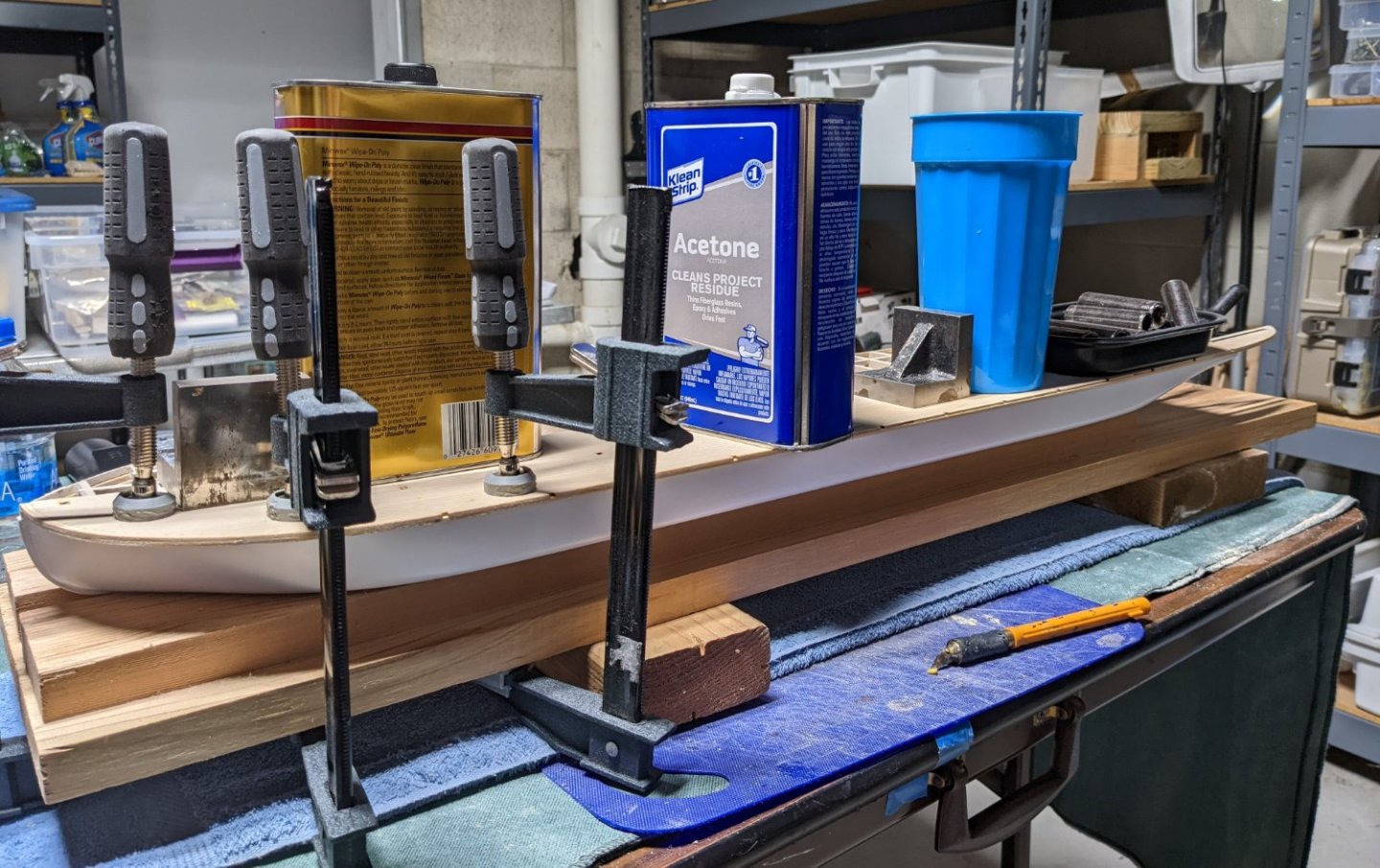
-
Brian,
Thanks for that link. It is interesting to see all the changes over the years. Speaking of links, the link you sent me in a previous conversation showing the 3D virtual walkthrough of the Chaperon is fantastic. I really like it. Anyone building the Chaperon and wanted to know what it really looked like need to visit that link.
https://www.jensmittelbach.de/steamboats/chaperon/index.html
Actually, in the above link is shows the forward compartment walls. Looks like the builder of the real Chaperon also followed the written instructions and reversed the parts in the diagram. 🙂
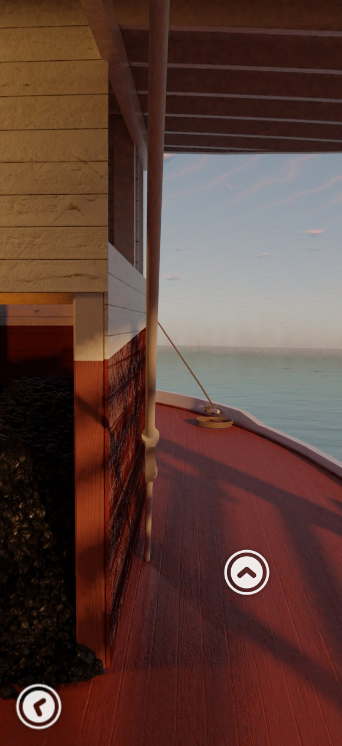
Not much else to report other than the final coat of paint is on the hull. I am ready to put on the deck. Like in your build, I plan to plank the first two decks. I think a planked deck looks better than an etched deck. Beside, "why do something easy when you can make it hard"? Actually I say that, but planking the deck should be pretty straight forward. I have the 1/32"x1/8" planking ready to do. Just need to keep track of all the notches in the deck.
It is amazing what some filler and a few coats of paint will do to a model. Covers a lot of sins... and lack of planking skills 🙂
Actually,,,, now that I look at it.... it probably is too good for a riverboat. I am sure the real Chaperon never was this smooth. I probably should have left a few plank lines 🙂
-
Eric and Brian,
I really appreciate both of you taking the time to respond. I was looking at brucealanevans build log and looks like he followed the written instructions and reversed the pieces in the diagram as it appears his walls are on the outside of the posts.
Now that I have had time to think about this I do not think it is critical either way - just depends on what look you want. When I get to that point and start dry fitting the pieces one way or the other will call my name.
Again I really appreciate your responses.
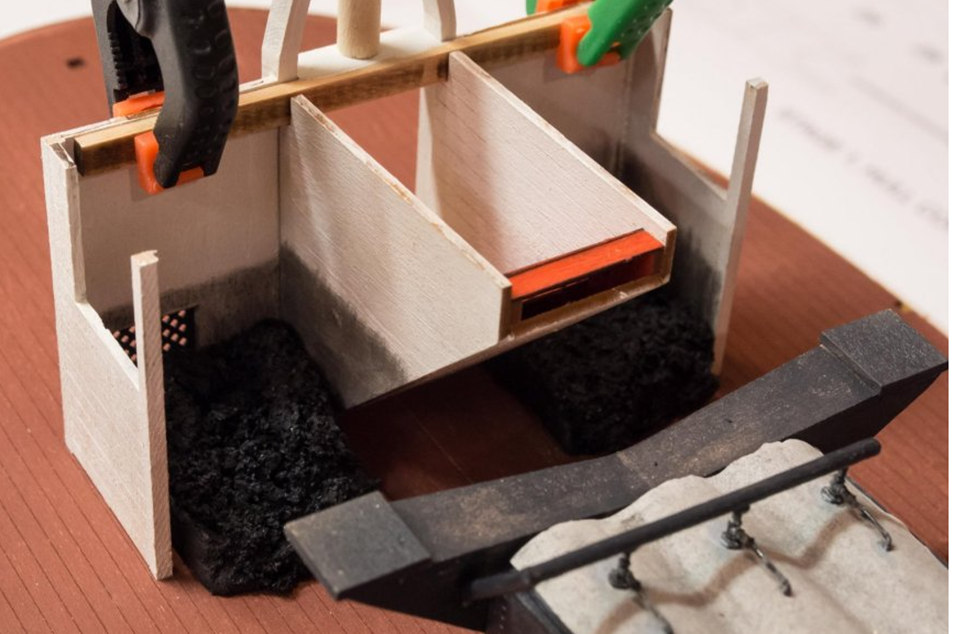
Brian,
Thanks for heads up on parts 37P/S and the picture of the vent pipe for the safety valves. Both will save me some headaches down the road.
-
Boiler tank doors have been added along with what I call handles to the doors.
Steam bar, mud tray, and backward facing dials have been added. At this point I am going to hold off on the safety valves. What I would like to do is have them attached to a pipe that winds around and eventually connect to the smoke stacks. The challenge here (or me anyway) will be to get three holes drilled in a 3/32" pipe and have it bend around to connect to the smoke stack. I plan to create that bent pipe and if successful then attach the safety valves to the pipe. That might be easier than first gluing the safety valves to the boilers and then try to bend the pipe to match the valves. All that will come a little later, I need to get back to completing the hull painting.
But before I do that, I was looking ahead and it would seen there is a little issue with the foreword compartment diagram. Either that of I am totally confused....
I know I am not going to explain this well, but I will give it a shot. Please ask questions if I am unclear.
In the below diagram I am only talking about part 38P, but it applies to 38S also.
The written instructions are show below in italics.
Begin by gluing 3/32" square strips to parts 38P and 38S. Do this
over the full size plan shown on plan sheet 1. Note that the outboard
sides of 38P/S will be down during this step.The questionable part of above is there it says "Note that the outboard sides of 38P/S will be down during this step."
Problem is, in the diagram below, it looks like it is showing 38P with the outboard side up.
To me in order to maintain the correct angles for 38P/S, they should be reversed. That is piece 38P should be layed (outboard side down) on the diagram labeled "38S Full Size" and piece 38S should be layed (outboard side down) on the diagram labeled "38P Full Size".
Brian and Cathead.....Am I correct or really confused at to what I am doing here?
- Cathead and bobandlucy
-
 2
2
-
I just noticed on the 1/64" wood sheet (LC-24) there are three pieces with the name CHAPERON laser etched. On all three pieces the name CHAPERON is missing the "N". Not a big deal as I can somewhat easily add the missing "N", but since it is laser etched and all it would not look the same. A quick note to Model Expo and a new part was quickly shipped out. I really like that policy of Model Expo.
I am finally almost completed the hull. Looks like I have one more final coat of paint to apply as there are still a few rough spots, but all and all, for a novice like myself, the hull is looking pretty good.
On the bottom you will notice I added two extra keep parts. Even though I play to screw the hull to the frame I made earlier to work on, in the end I plan to mount the final ship on a glass shelf with no pedestals. My other models in the glass case all just sit on the glass, so I figured this one would too. Thus in order for the hull to lay flat on the glass, the two extra keels were required
All work on the boat is constantly monitored and supervised by a pair of watchful eyes.
While last last set of paint dries I have started playing with the boiler. Note in the making of the main boiler frame I added some extra strips of wood inside just to give me a little extra gluing area. Not really required and way overkill, but it sure makes gluing walls easy when you have a little more gluing surface
Here I also added two cross pieces, as the thin wood walls tended bend in. These keep the wall straight before the bottom was glued on.
On the bottom of the boiler nails are to be use to simulate support feet for the boiler. There are two problems here. One is that the boiler walls are only 1/16" thick. There is no way someone of my skill would be able to drive a nail into the side of a 1/16" piece of wood. The other problem is that the supplied nails are too short. The distance between the bottom of the boiler and the floor is only a little longer that the supplied nails. Only solution I could figure out was to add a small wood strip on both sides of the boiler. That way you have a much larger area to nail into and the distance between the boiler and the floor will be a little less - thus allowing more room to drive the nail into.
Moving on to the smoke manifold, instructions call to start by gluing part 74 to 73. From there you build the other parts (75,76,77) around them. Problem I felt with that approach is that the most important part of the smoke manifold is part 75. It must be perfectly flat to later on accept the smoke stack on top of it. With all the weird angles involved with the smoke manifold, starting with 74 to 73 and building around them would make it pretty easy to end up with part 75 not flat. Thus I started with gluing part 75 to 73, insured that was flat, and then build the other parts around them.
Thus the final smoke manifold.
Then after a little filler and paint,,,
One additional touch I wanted to add was the simulated top of the three boiler tanks as others have done. It is a neat look. Basically it involves cutting 3/16" strip off a 3/4" dowel rod. Problem is, I do not have a table saw, but even if I did, I kind of like my fingers and not sure I wanted to take the challenge.
Happily I had a close friend who has a table saw and not really in love with his fingers. He took on the challenge. For those interested, below are some pictures as to how we was able to complete this and keep all 10 fingers.
Get some very strong double sided tape.
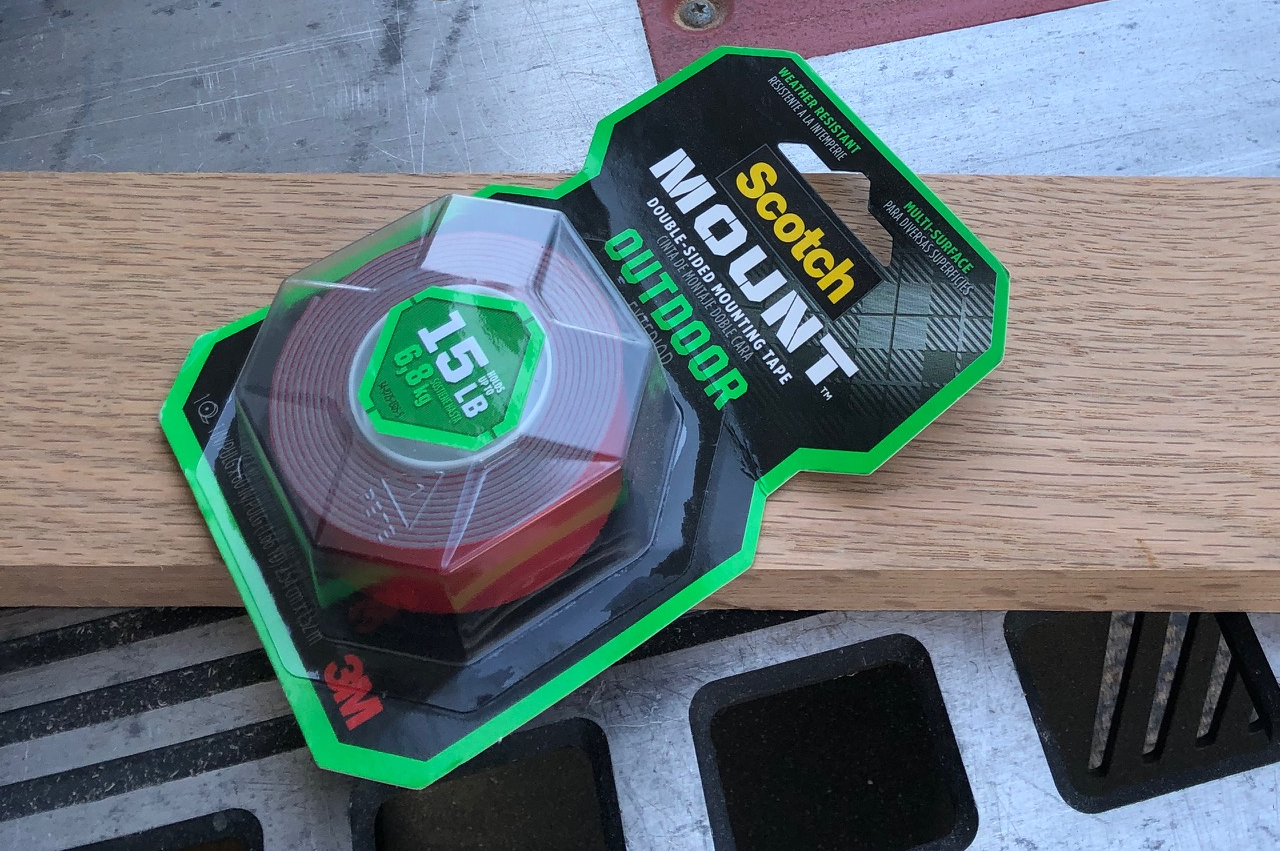
Attach the tape to one side of a straight board
Peel off the protective coating
Stick the 3/4" dowel rod to the tape.
Then run it though the table saw - cutting 3/16" off the dowel rod. Again,,,, this tape has to be strong. We are not talking scotch tape here.
From there, cut the cutoff piece into 3 - 5 3/4" pieces. Below shows the pieces attached to the boiler.
In front of the boiler doors is documented as ash pan, but the instructions only show a flat surface. In order to keep the ashes from spilling out onto the floor, I added some little walls around the ash pan.
After a little paint, I see the extra piece of wood attached to the bottom of the boiler (with the feet attached) is coming loose. I just now noticed that. That probably happened when I was adjusting the nails to be all the same length. Nothing a little more glue can't handle.
Now I just need to add the smoke manifold, boiler doors, steam gages, and safety values that this should be ready to go. It will be awhile before the ship is ready for the boiler, but I wanted to get this little side project going while I was working on the hull.
-
Brian,
If you are happy with the filler you use, I might suggest you stick with it. I can not really say Filla in-a-bag is better or worse than what you are using - just different. I have had great success with Elmer's Carpenter's Wood Filler too. And in some ways, for quick litter filler applications, Elmers is much easier and quicker to use.
Back to the build
Later on in the build, once the deck is installed, a 1/16"x/1/4" rub rail strip is to be glued around the entire deck. Problem is the deck (1/16" thick) overlaps the hull by about 1/8" on each side. Thus the rub rail will will hang down from the deck with only 1/16" to glue the rub rail.
For someone with my limited skill that will pose a problem. Probably way overkill, but for me it makes sense to increase the edge of the deck to better accept this rub rail. I decided to use a 1/16"x1/8" strips to increase the outer edge of the deck. The 1/8" plank around the decking pretty much takes up all the extra overhang space.
In the below pictures it shows the 1/16"x1/8" wrapped around the curved parts of the bow and stern, just to get the overall curve. Once dry, they will be glued just inside the decking to make a better gluing surface for the later rub rail.
Once dry the curved pieces are glued onto the outside edge of the bottom side of each deck section. Below shows the end result. I have not seen this done in any of the other logs, so I guess this really is overkill, but it makes sense to me.
- Cathead, John Ruy, bobandlucy and 3 others
-
 6
6
-
After soaking and drying the keel, it was applied to the hull and a light sanding.
It would seem the keel at the very end did not go on straight... Not sure it is worth tearing up and fixing as no-one will see the bottom of the hull, but we'll see what happens when I take a closer look at it later on.
I mentioned earlier about the stern of the boat and being a little "untidy" looking. Even after some sanding it still does not look right. And even though the paddlewheel will cover most of it up... Just feels wrong to not plank it.
I know I said earlier I would not overlay this with planking,,,, but I just could not help myself.
Now on to the filler. In may case the filler I use is called Gork's Goodfilla FIlla in-a-bag
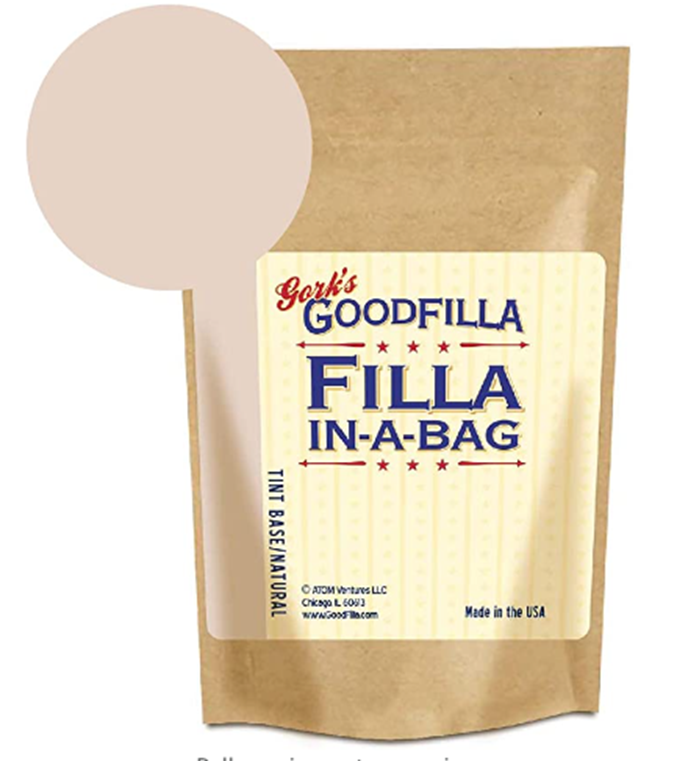
It comes is a number of colors, but in my case I just choose Natural. One thing I like about it is that it is water soluble and goes on very smooth. To get a really smooth finish after application you can wet your fingers and rub over the filler spots. The filler will re-activate and you can get a glass like finish. Of course after it dries you it is also very easy to sand.
- mbp521, bruce d, Ryland Craze and 3 others
-
 6
6
-
Brian,
Thanks for bringing me back to reality.... To me looking at the stern of the hull, even before final sanding, it looks pretty rough. But I forgot...while this may be the end of the hull, it is not the end of the ship. That paddle wheel comes after the end of the hull. So you are correct.... after final sanding the the addition of the paddle wheel, it will not be noticeable.
Starting soaking and bending the keel to fit the hull. A few handy clamps and rubber band easily set up the keel for bending around the front of the boat.
As I mentioned earlier, the etching on the pieces that are supposed to simulate planking is really thin. Not sure if it was just my model, but any coat of paint would easily fill in the groves. I have been thinking (and worrying) since the start of the build about these thin etched planks and how to make the etch lines looks like planking with out filling them up with paint.
A more experienced modeler knows all this stuff, but for me it is new. Sent a note to Brian (mbp521) asking about this and he mentioned the solution is to use a scribing tool to enhance the etched lines. Seems like a simple solution, but it was news to me. Below is the etching tool I used. It is a slow process, and you have to etch every time between paint coats, but in the end, the simulated planking looks pretty good.
Below are the pieces for the rear cabin structure. The pock marks on the lower right wall are my fault. After sanding, I use paint thinner too clean up the pieces before painting. I normally use this as it dries fast and you can paint it fairly quickly..... Problem was,,,, I did not wait long enough as I assume there was still paint thinner residue as the next coat of paint really balled up and had to be sanded down again. Looks like I still need another sanding and coat of paint.
As for the CHPERON letters,,,, they are still a work in progress. At this time I masked them off as a block and spray painted the white around them. I have since gone in with a very small brush and added only one coat of white paint between the letters. I need to add a couple more coats of white and then fill in the red and black letters. It will take a small brush and steady hand to complete those letters,,,, We will see how it goes, but so far I like the result
And with letters filled in. We had some very close friends over for the weekend and when she found out what I was doing she volunteered to add the Red, Black, and White for the letters. Needless to say she has a very steady hand.
Below are the forward compartment walls. One on the top left has the same issue as the larger wall above,,,, human error on my part with paint thinner. Still need to work on that one, but the others seem ready to roll
-
Did I mention before that this will be a painfully slow log.... Summer is here and it seems the boat building business has ground to a snails pace.
With the side of the hull planking complete, time to start planking the bottom of the hull with 1/2" x 1/16" planks. Starting with the middle and work you way outwards. Again very little bending and trimming of these planks to complete the bottom. They more or less just fall into place.
just keep working your way outward...
Note the two holes in the bottom for the previously mentioned screws to connect model to the base stand.
Only regret here, as you have noticed, I did not stagger the bottom planks. At the time I thought about it, but figured it was the bottom of the hull and it would be painted (no one would see it) so I thought I would just line up the planks. Again, not a big deal, but the straight line just seem wrong. I should have staggered the planks.
Only part that requires any effort at all are the remaining pieces (below) to fill in the bottom of the hull. But will a little patience and sanding, these pieces also fall easily into place
Below shows hull bottom complete and after an initial light sanding. I still need to add the keel so I held off on a full sanding until the keel has been mounted.
One item I noticed as the very end of the hull where the planking meets the end part of the hull (part 29A) looks kind of rough... Even later on after a full sanding that area will probably still look unfinished. I am not sure yet, but probably the solution would be to overlay this area with at 5/16" plank,, just to make it look like one piece.
I will see what it looks like later on after filling and sanding.
-
-
I am back,,,,,,, Early on I mentioned this would be a painfully slow log, but I did not realize just how slow it would be. With Spring in the air all sorts for outdoor clean-up tasks have been pulling me away for the boatyard. Seems the workers have gone on strike.
Have completed planking to row 11. As other logs have indicated, with 1/8" planking, the planking effort is a breeze. With only a minimum amount of soaking, they ben very easily. Although for the first 10 rows they do not need to be bent very much. Even around the bow and stern sections, just wet, bend and clamp the planks until dry. After that they easily are glued into place. Only rows 10-13 require some real bending and twisting at the bow area.
With the planks that are to be bent around a curve (bow/stern sections), be sure to trim the lower inside edge of each plank so they fit together better around the curve
At this point
A few bow shots
And a few stern shots
Here is one of the planks a the bow section in row 11.... Did I mention earlier they had some bend/twist to them?
All 13 rows have been completed.... Next need to trim up the stern section and start laying the bottom 1/2" planks
Did I mention "you can never have enough clamps"?
This clamps with the screws really worked well keeping the stern planks in place.
- gsdpic, DanB, Prowler901 and 5 others
-
 8
8
-
-
23 hours ago, mbp521 said:
Guilty, on every wooden model I have ever built. Something about the lure of creating sawdust and seeing the uneven planks laying there tempts me to get them sanded immediately. I just can’t help myself. I’m going to have to look into those clamps. I like the pointed ends on them.
-Brian
Brian,
I only said I have resisted the urge to sand the planks at this point..... I say that now,,,, but I will no doubt be sanding in the near future. I too have never been successful holding off sanding the hull until all planks have been laid. Just can not help looking at those uneven planks and resist,,, "just a little sanding". That is what I tell myself each time,,, and then end up sanding the hull as I go along. 🙂
We will see how far I get into planking before the sandpaper comes out... I can hear it calling my name even now...
john
-
I forgot to mention that on Acme Tools they cost $2.45 each.... If only need a couple the $6.95 may not be worth the cost, but I could not find them anywhere else for anywhere near that price. Be sure to check out Acme Tools (https://www.acmetools.com/plastic-spring-clamp-2-inch-capacity-xcl/091162000687.html). As mentioned earlier they are currently out of stock for online shoppers... 11 of by 12 clamps are waiting on back order... We will see if the 3-5 week wait time they listed is anywhere near accurate.
john
-
Bob,
Glad to have you follow along and feel free to ask me any questions as I go alone... especially if you see a place where I might have made a potential error. I am by no means an expert builder.
Unfortunately this build has turned into one of those painfully slow logs. Spring has come and with that goes all sort or tasks (indoor and outdoor) that now need attention after being ignored all winter. I have not stopped, but updates may be slow in coming.
At this point I have completed the first 4 rows,,,, I have to say, as the instructions indicate, with 1/8 x 1/16 planking, the planking effort is pretty easy. As mentioned above, just soak for a few minutes, pin in place until dry, then glue. Only trimming I did was on the the bottom of the planks (The part that is glued to the bulkhead). Here I just took of the inside edges so the planks would fit better together over the hull bends.
And after the clamps come off,,, I am resisting the urge to do any sanding until all the planks have been laid.
A few dents in the wood here, but being basswood, I am hoping after I apply a little water, that the dents will come out,,,, If not there will be plenty of filled later on before painting,
Since this is not a beginner model, I have a feeling what I am about to say will already be known, but for those of you who are in the market for some more clamps, I would like to point out some really good clamps.
My most recent purchase was some 2 "BESSEY Plastic Spring Clamps. They really are useful for getting into those hard to reach areas.
They are listed a 2" clamps, but as you can see, they are about 4" in length. I assume the 2" refers to the grip. You can get them are various places online, but I found the best price is directly from Acme Tools even with the $6.49 shipping. The shipping charge is not much if you are ordering a bunch of them. I my case I ordered 12, but at this time only have 2. The other 10 are backordered. Supply chain issues,,, Web site says they should ship in 3-5 weeks. That was 2 weeks ago, so we will see how accurate that information is when they actually arrive.
And of course every modeler has these clamps.. If not, you need to get them right away... They are used on every model.
An finally, these clamps are also very useful when planks need some extra (shall we say) "persuasion".
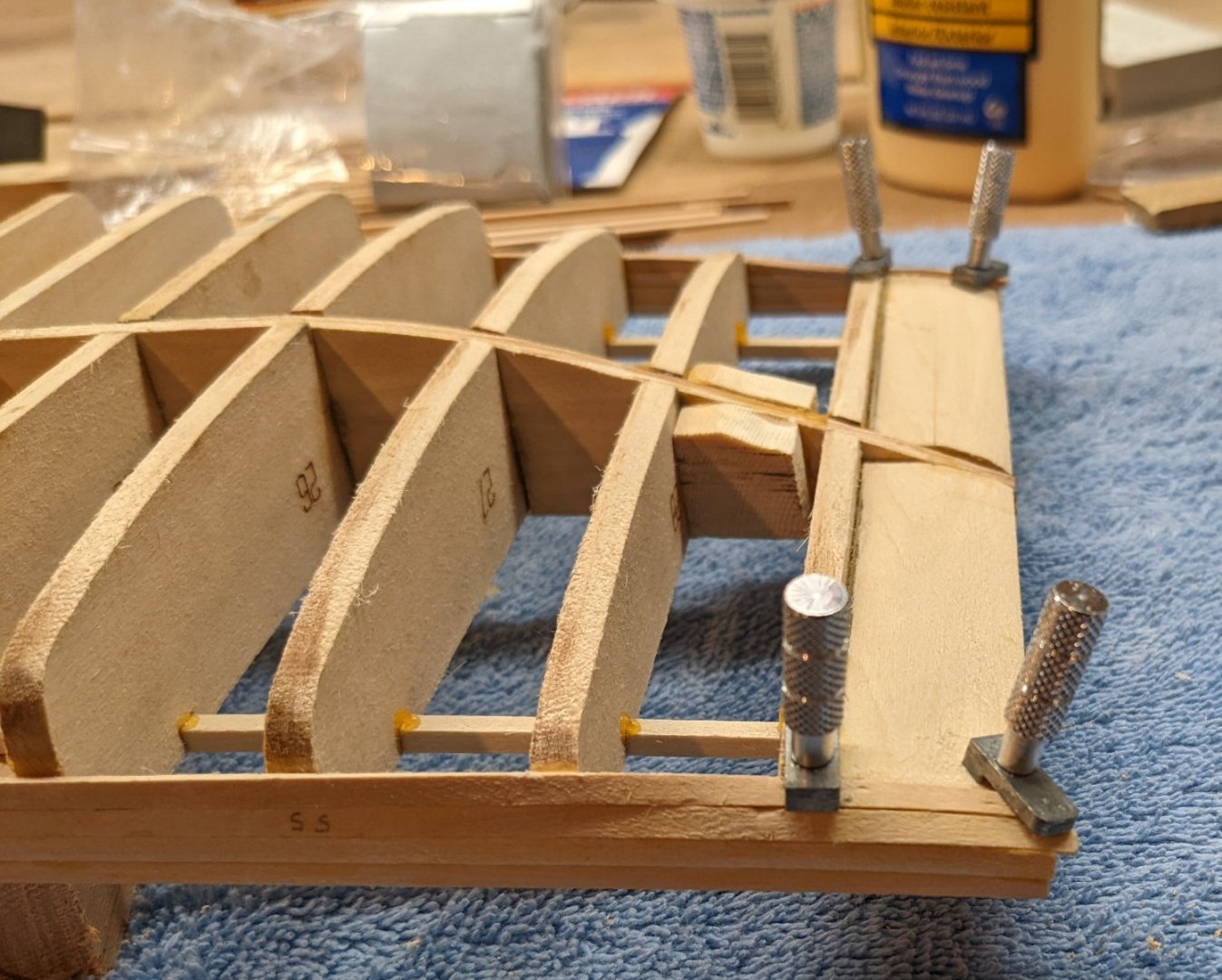
-
Drying over night in my make-shift jig did the trick. The stern piece is now parallel and no longer has a tilt. Stringers are all in and we are ready to roll with planking.
For the planking I have the hull sitting on the temporary stand. It is not bolted in, but it turns out the stand is a very level stable area to hold the hull. Not sure I will plank the entire hull on the stand, but at this point it seems like a good idea.
And so the planking begins.... First two sheer planks at the bow section have been soaked and clamped into place to dry. The 1/8 x 1/16 planking is so thin that only about 10 minutes of soaking is required and the plank is very pliable. With 13 planks, I would expect it to take be about 13 days to complete the planking as each plank needs to be soaked, dry over night, and the glued to the hull. I am not going to rush the drying time as I really do not want to risk the wood (if still wet) to shrink after it is glued to the hull. Even though I plan to fill and paint the hull, I want to do the planking a even as possible with minimum gaps. Practice for other hulls in the future that do not get painted.
-



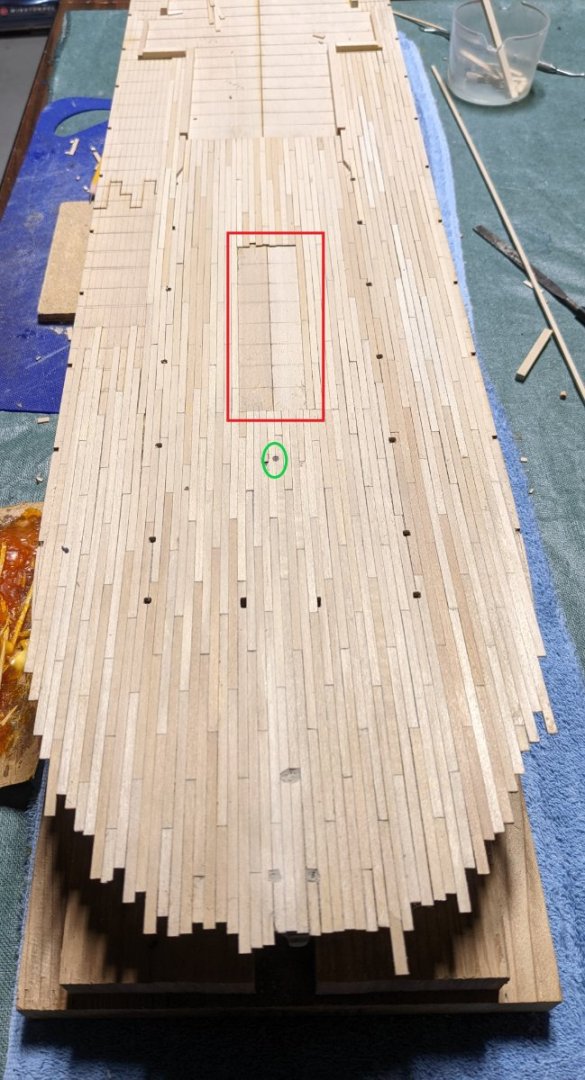
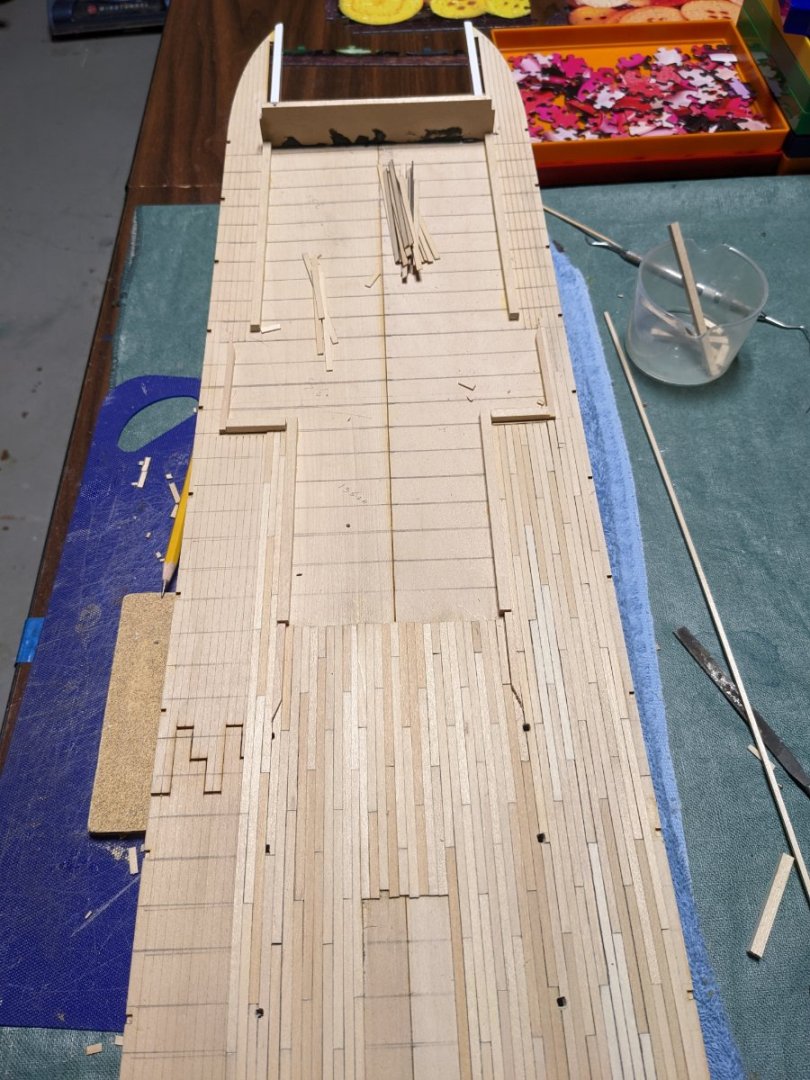
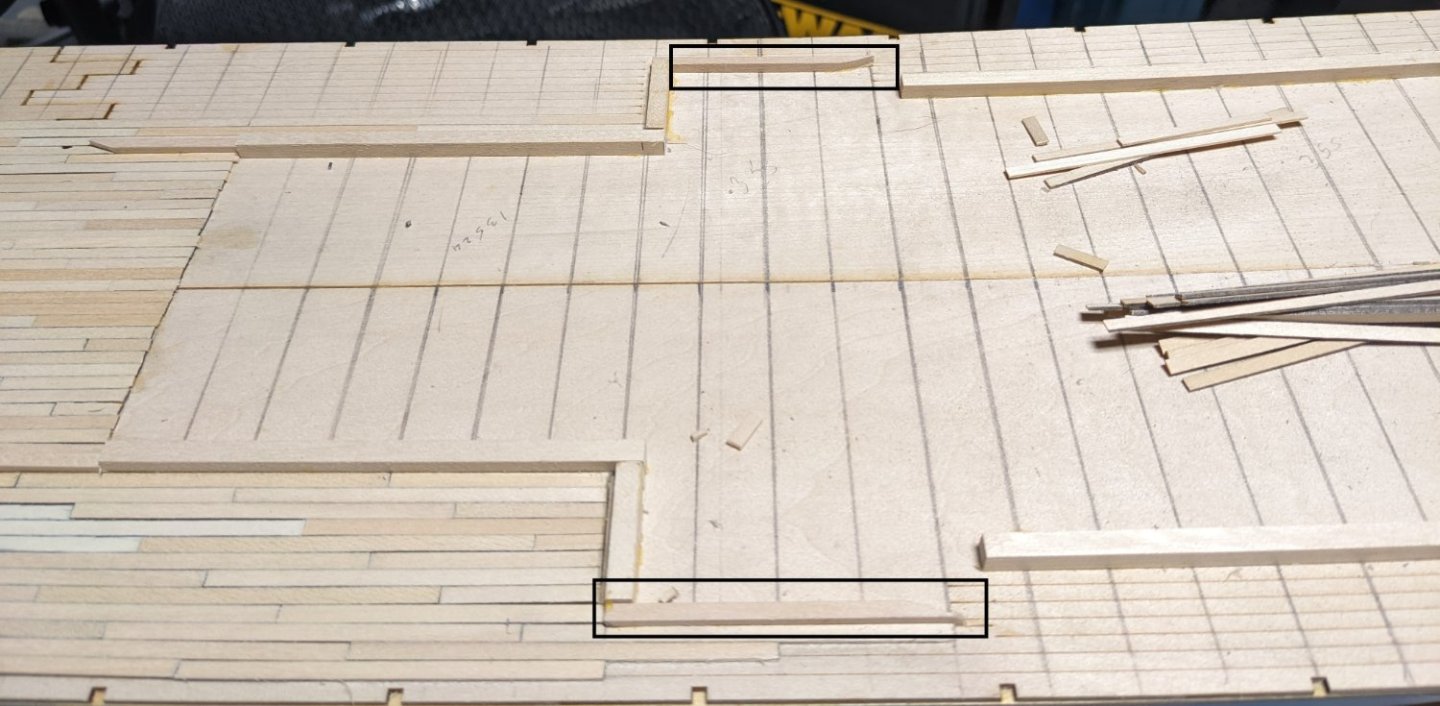
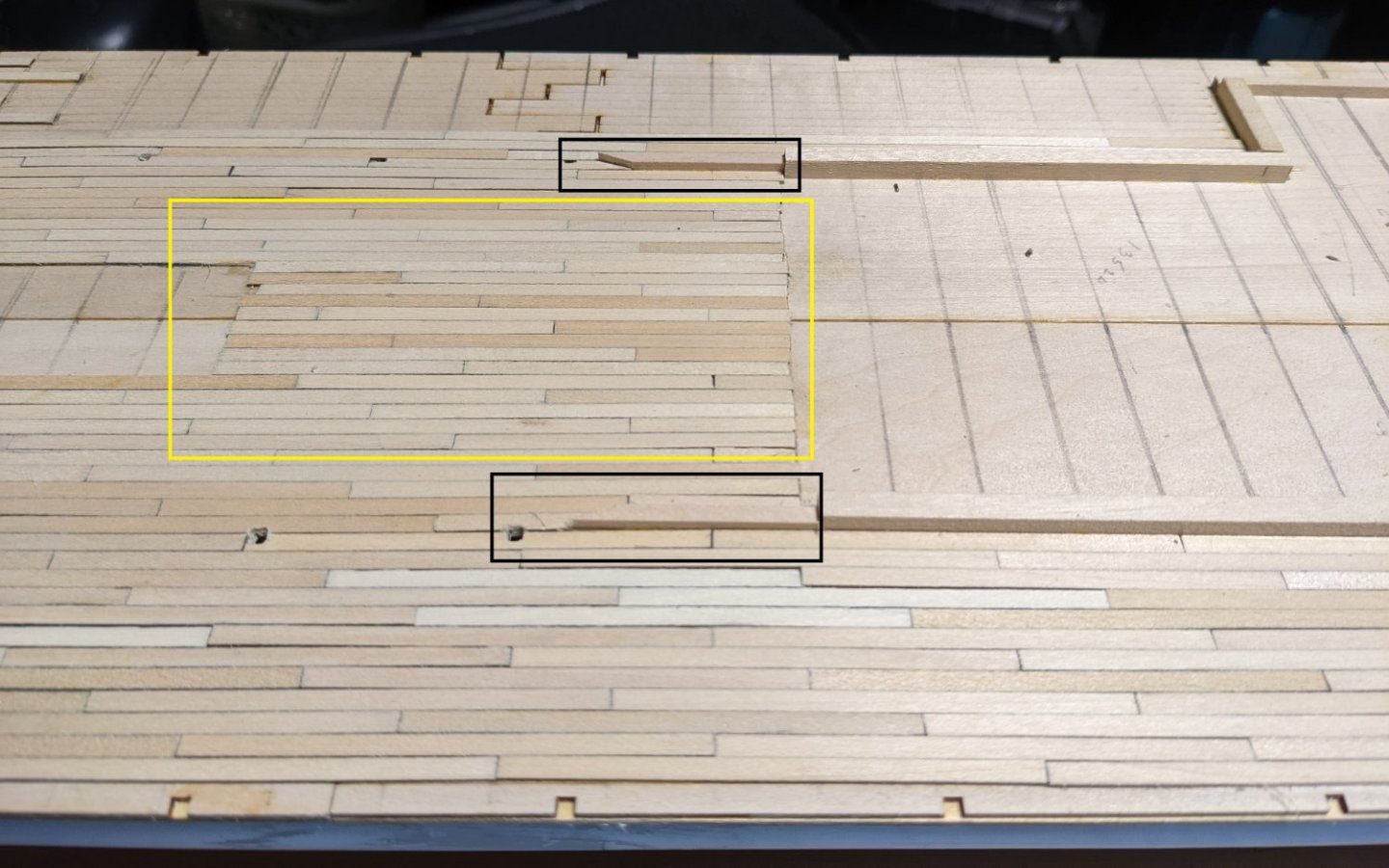
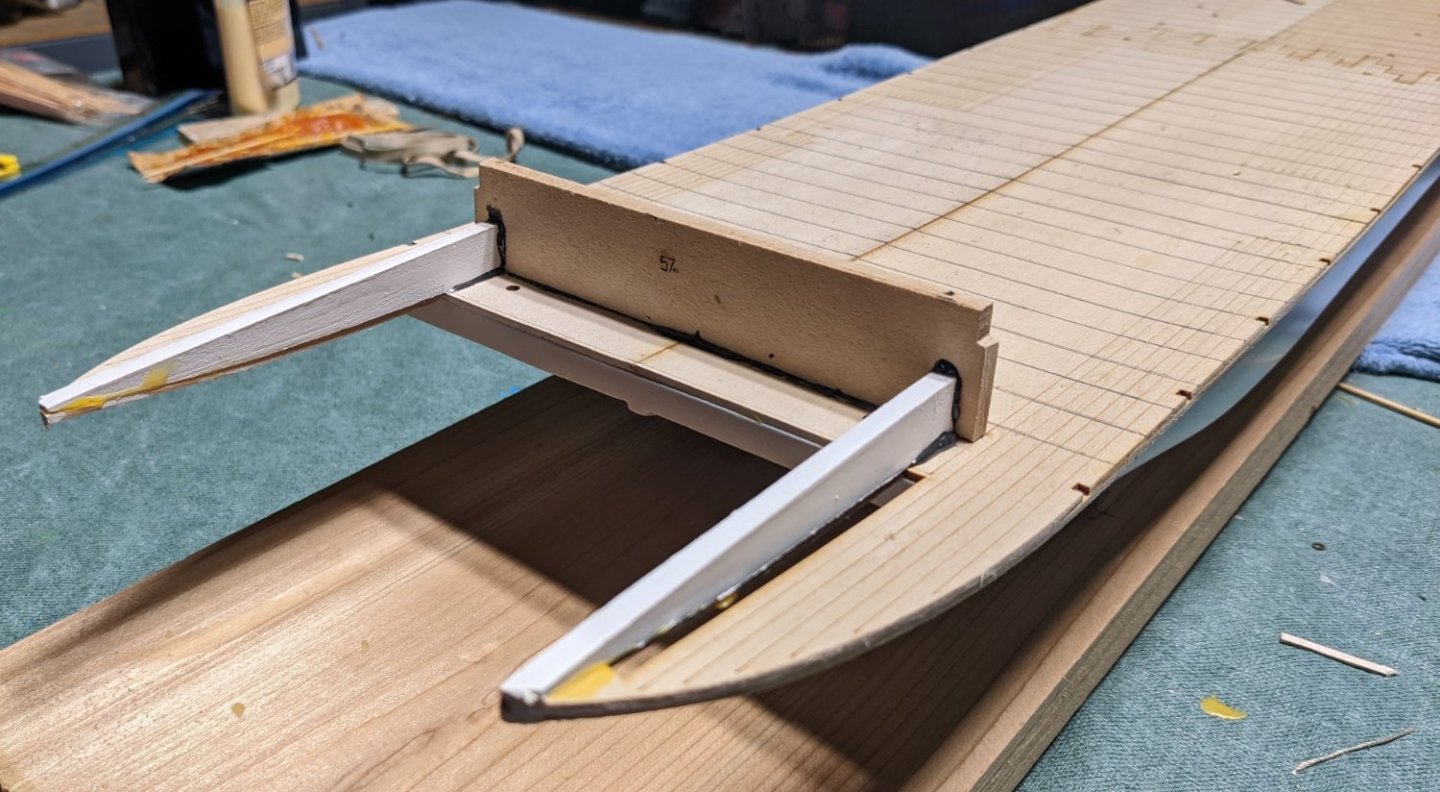
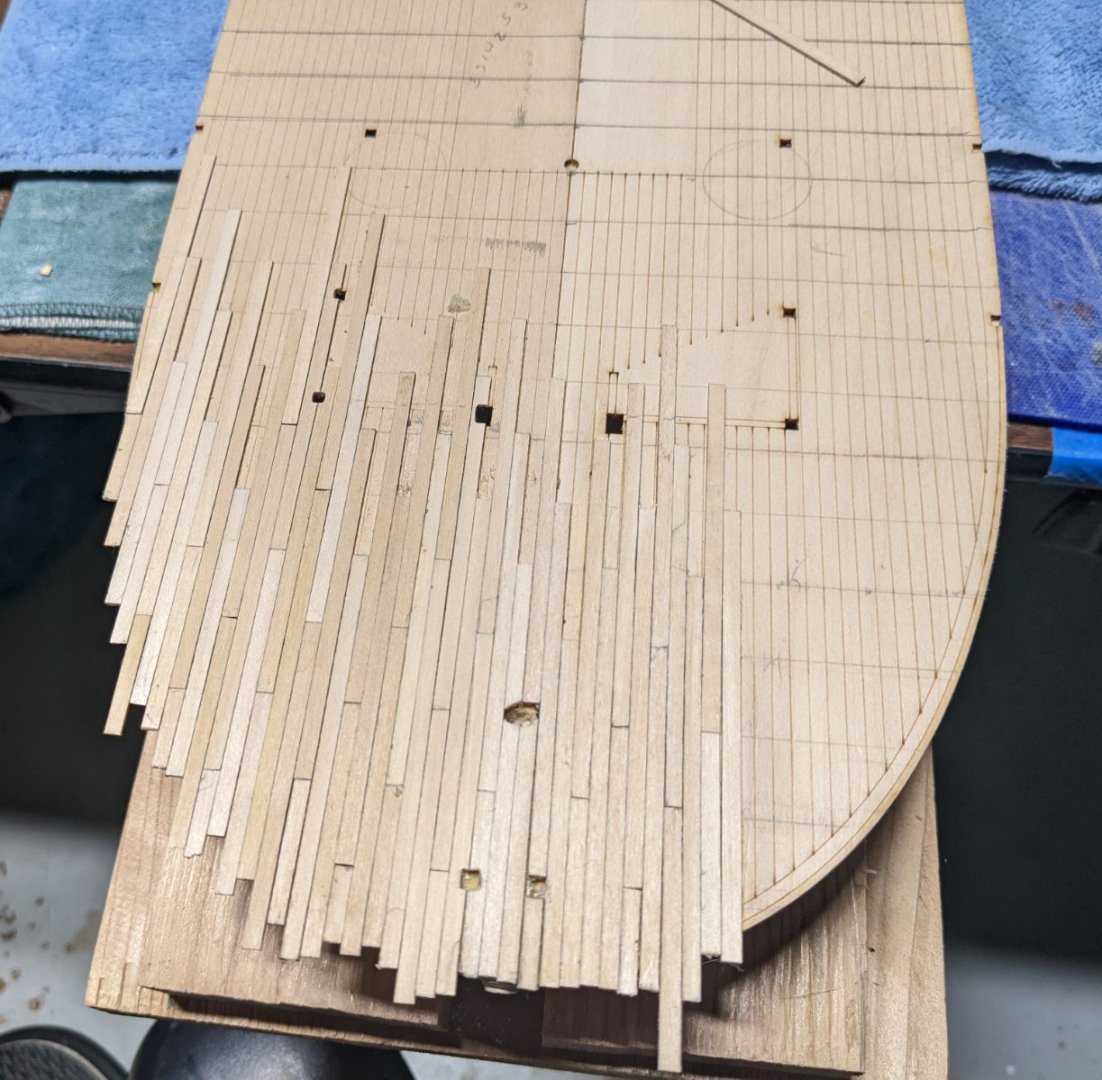



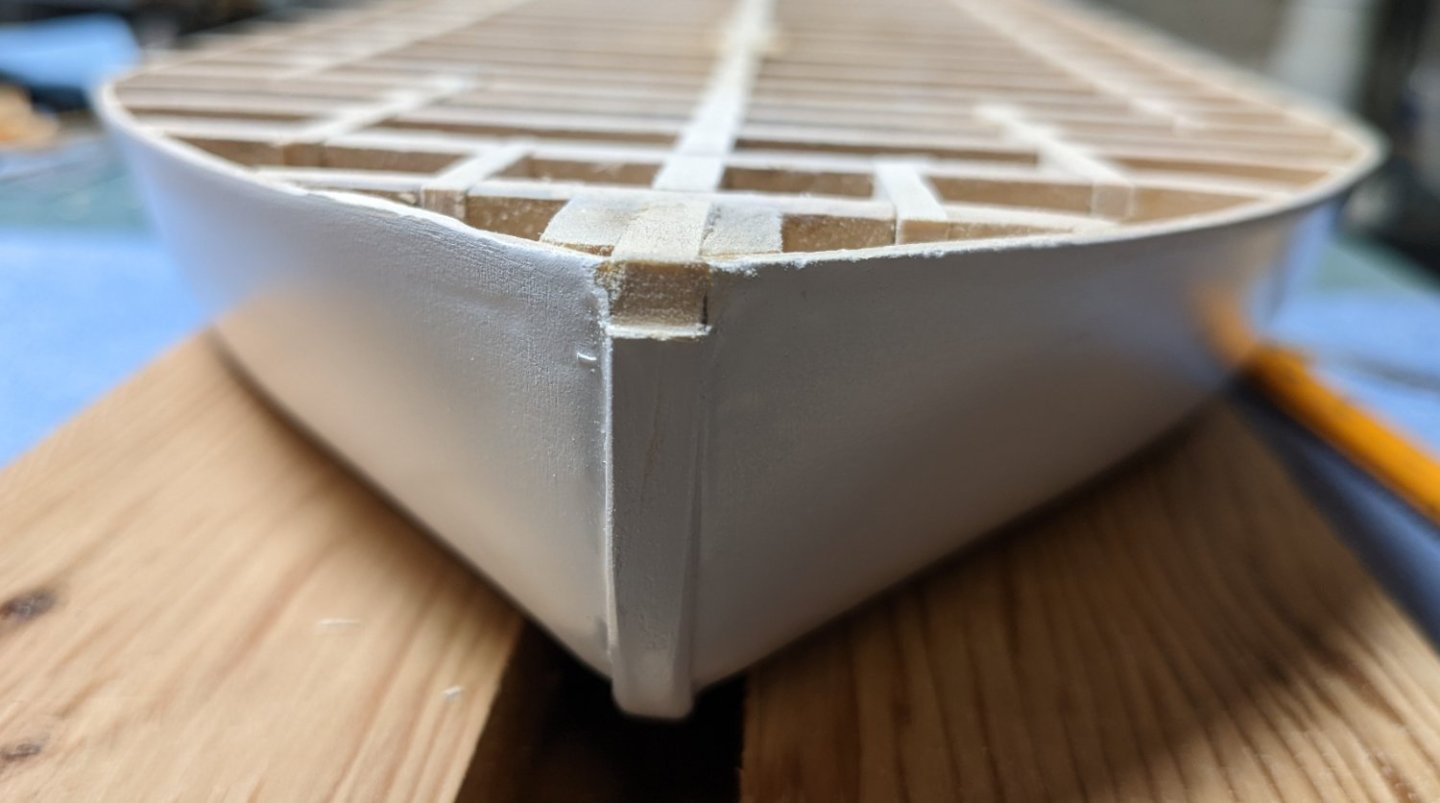
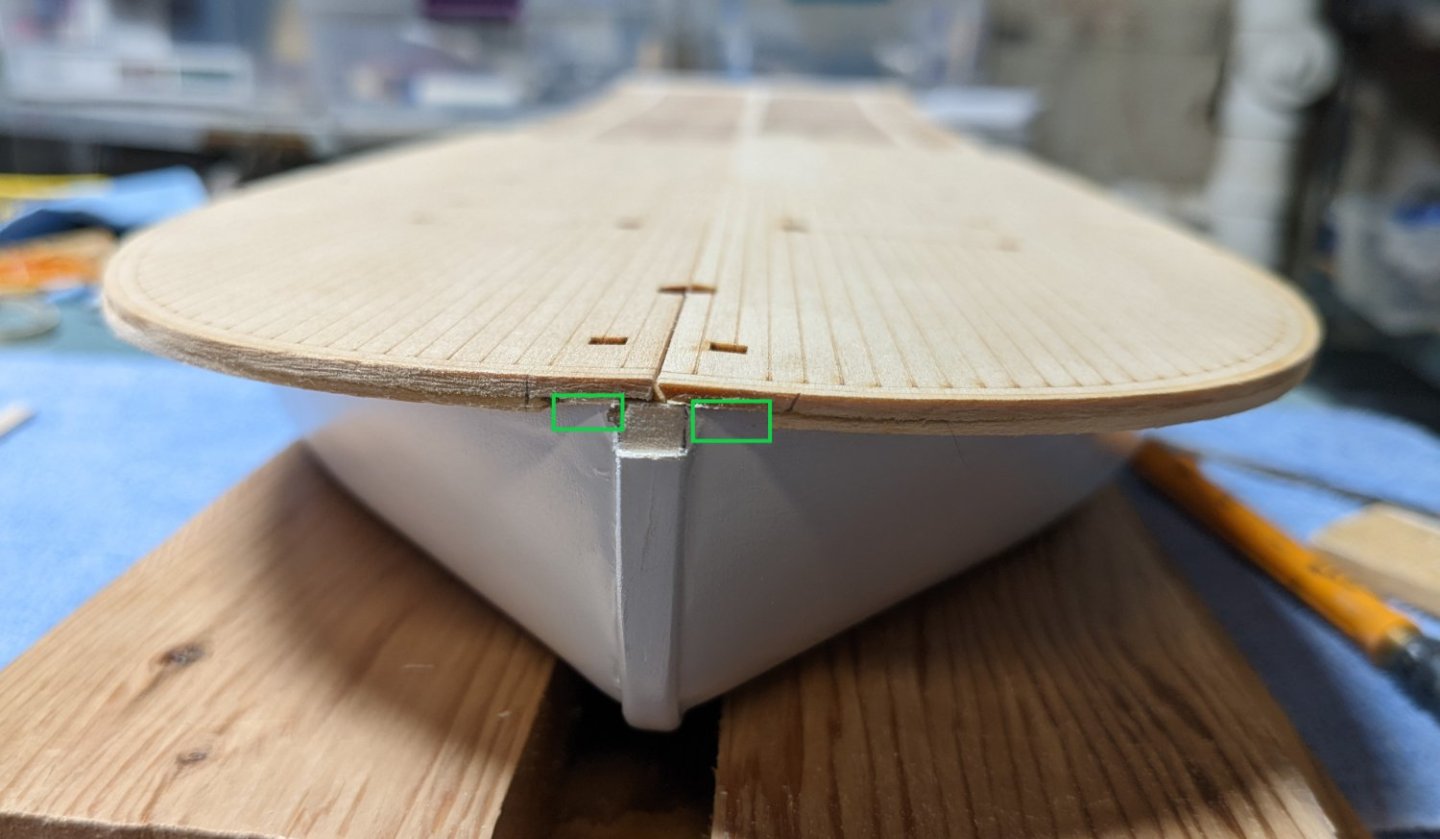
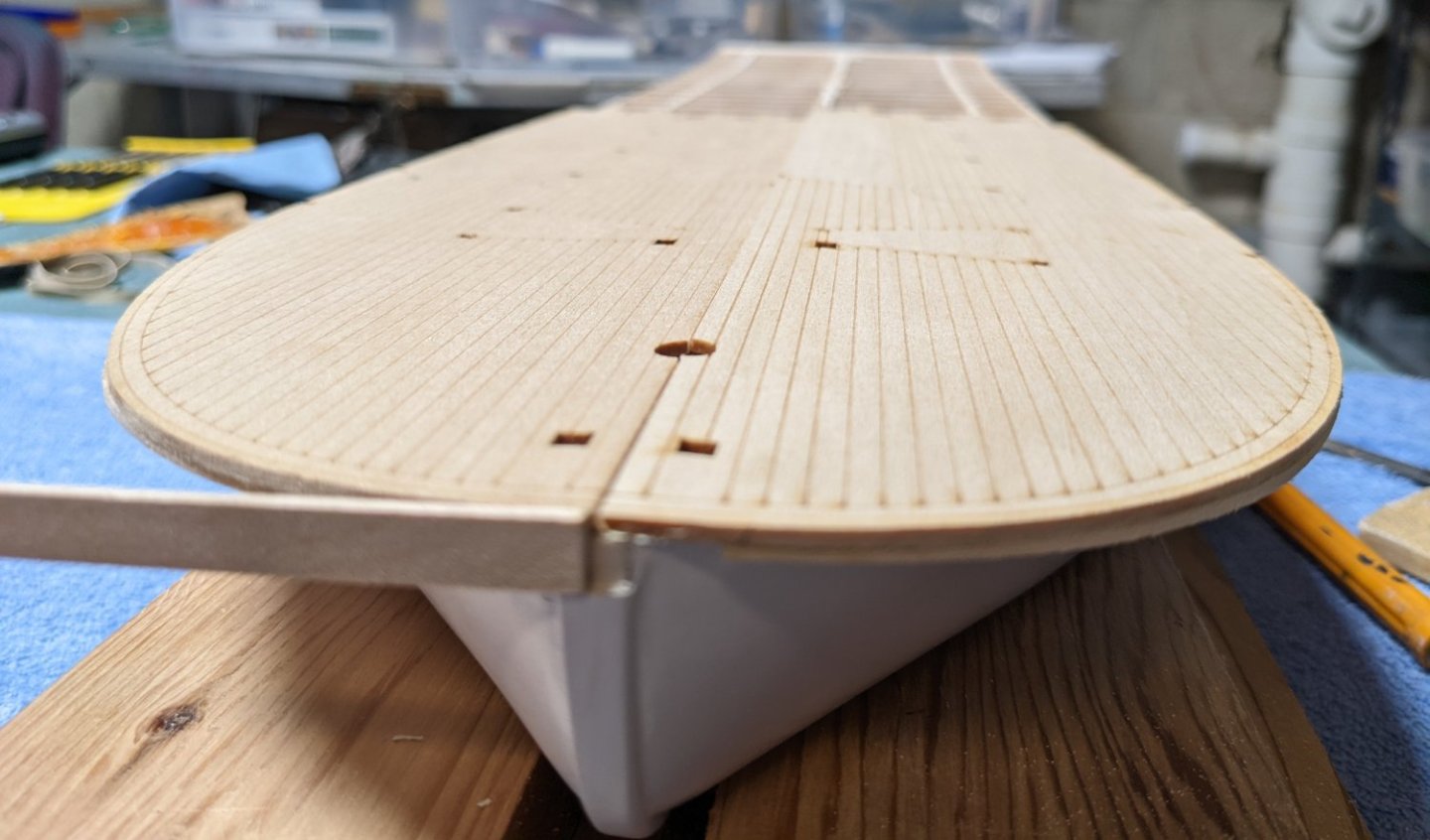
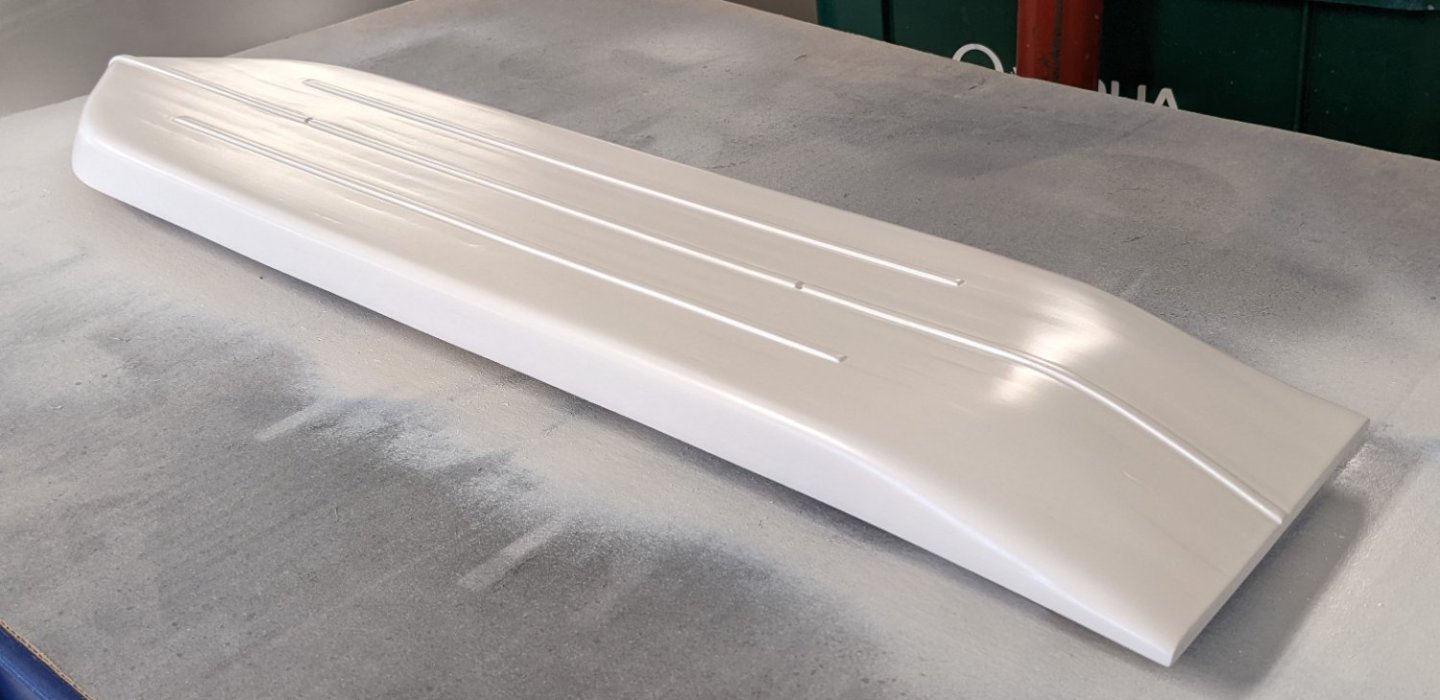
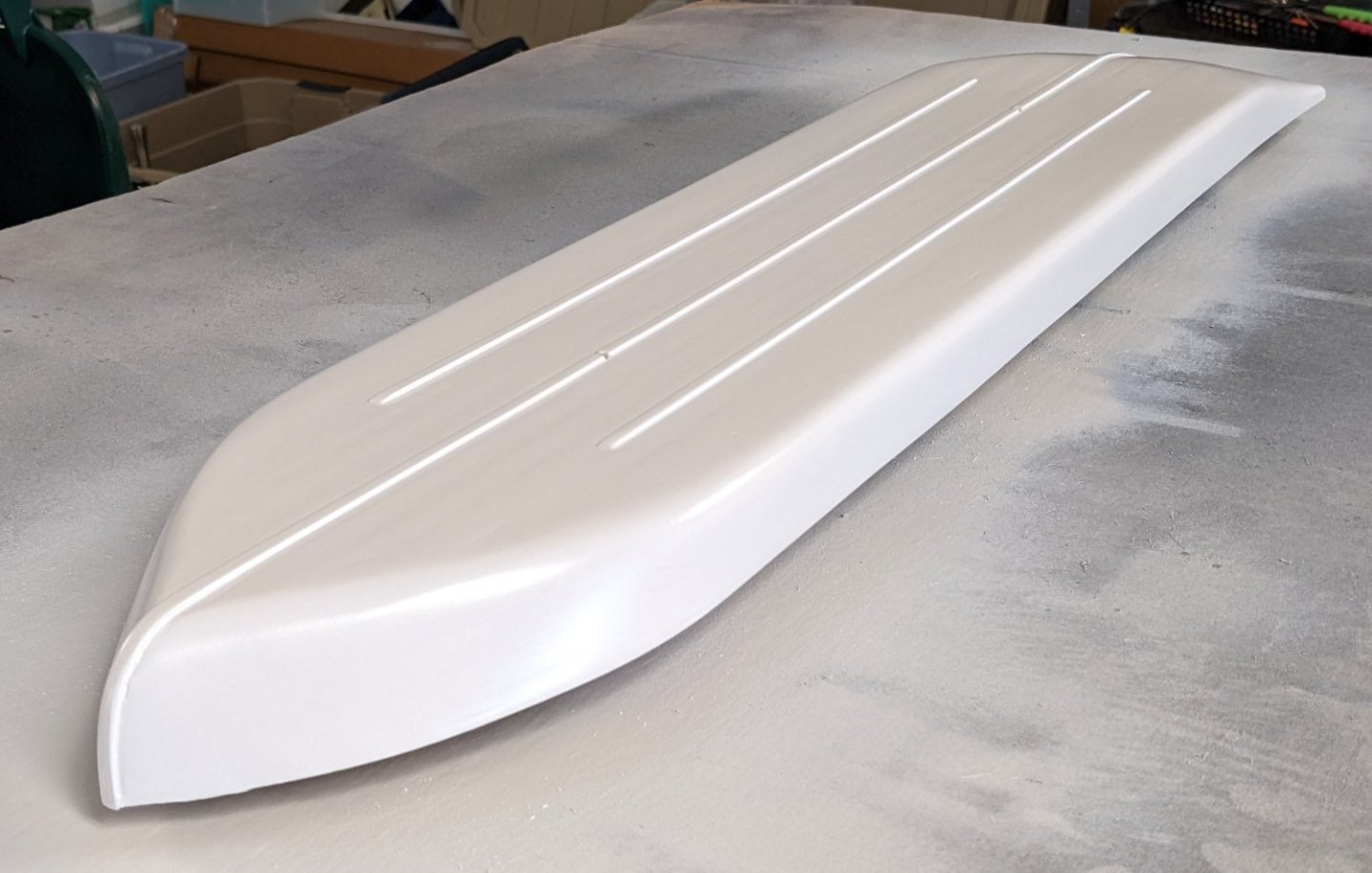
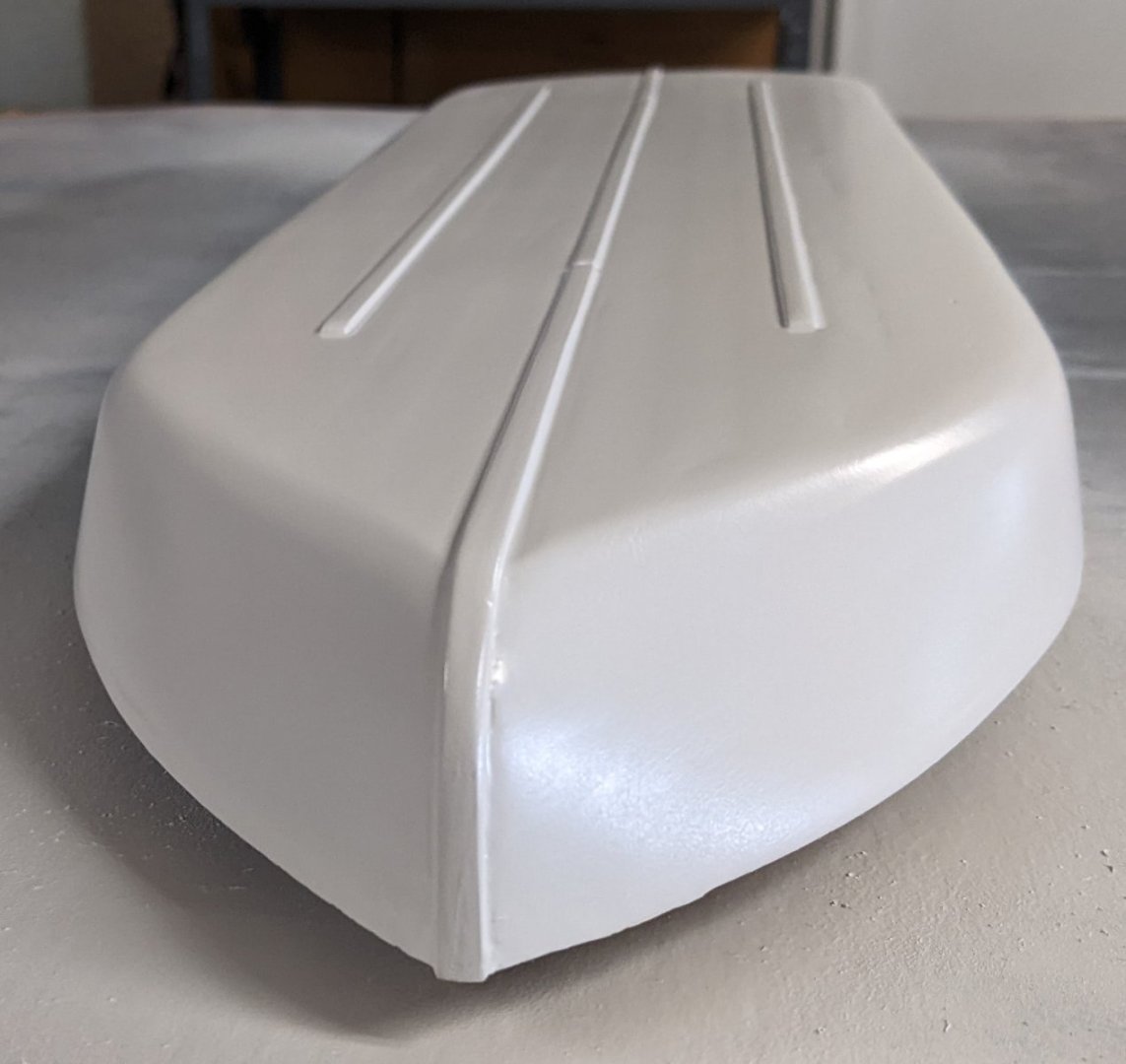

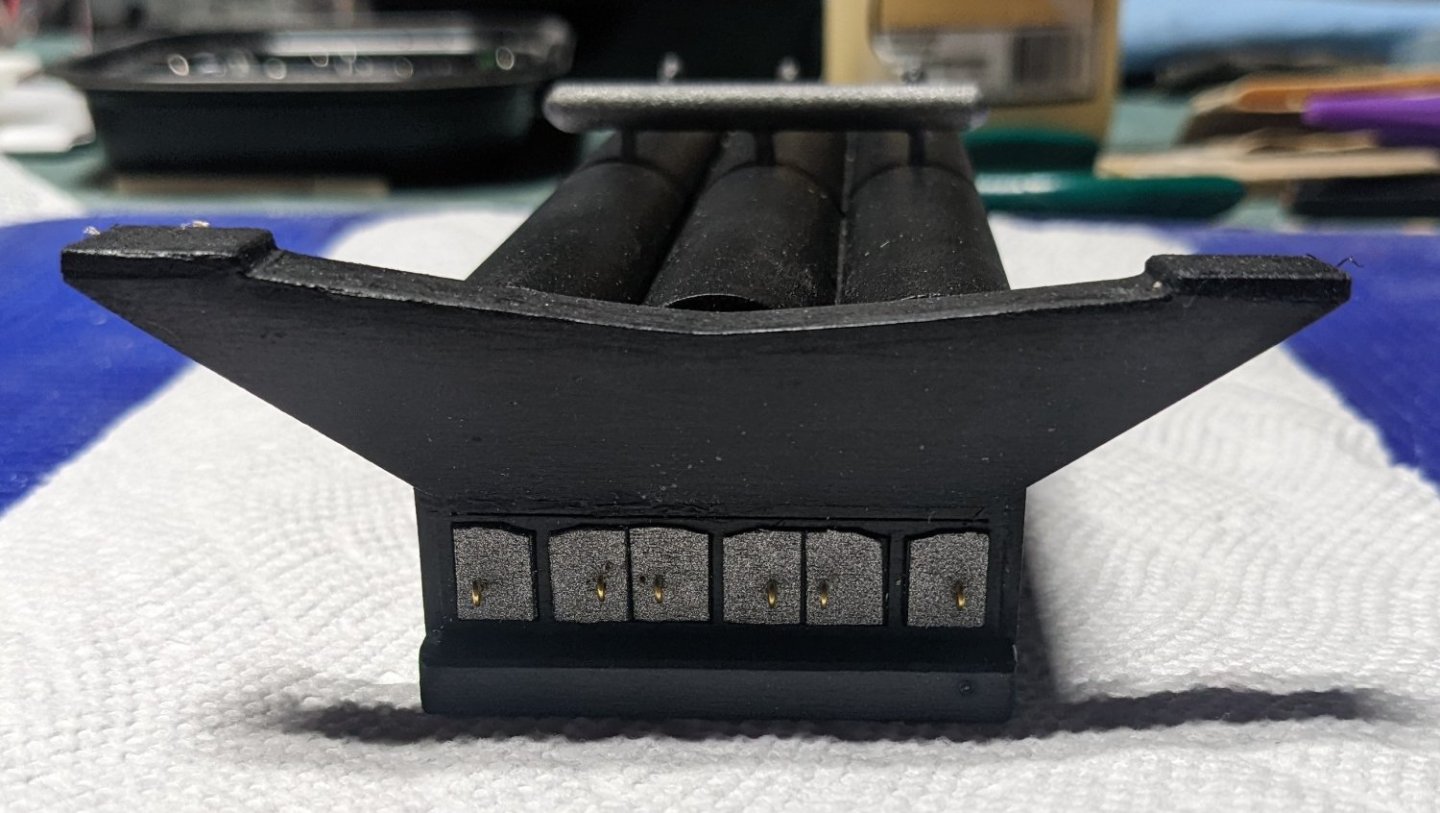
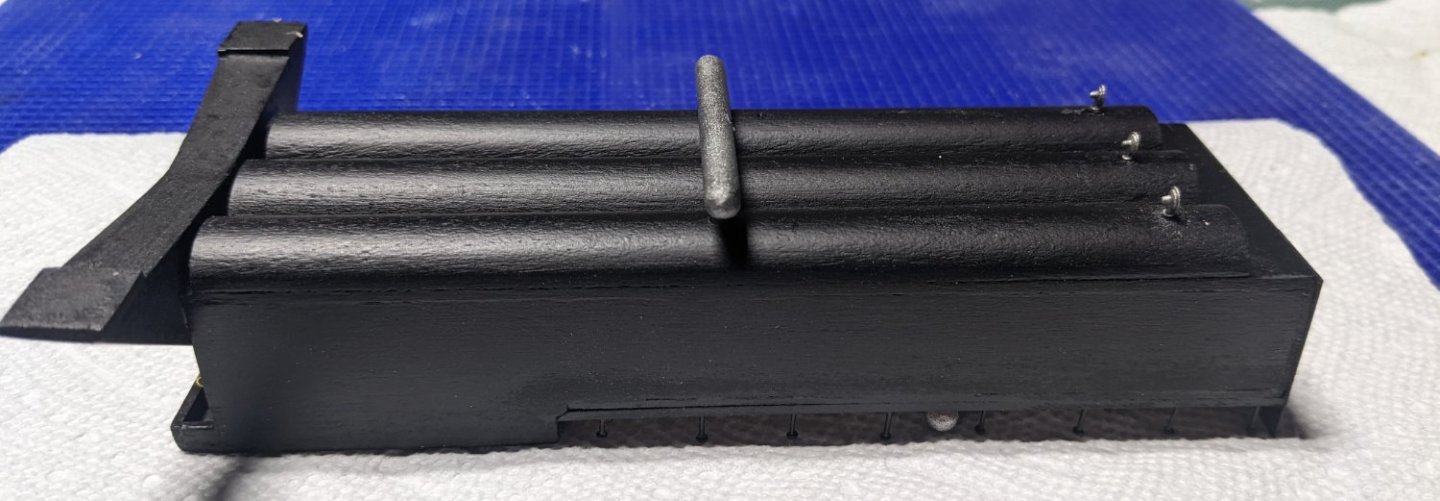
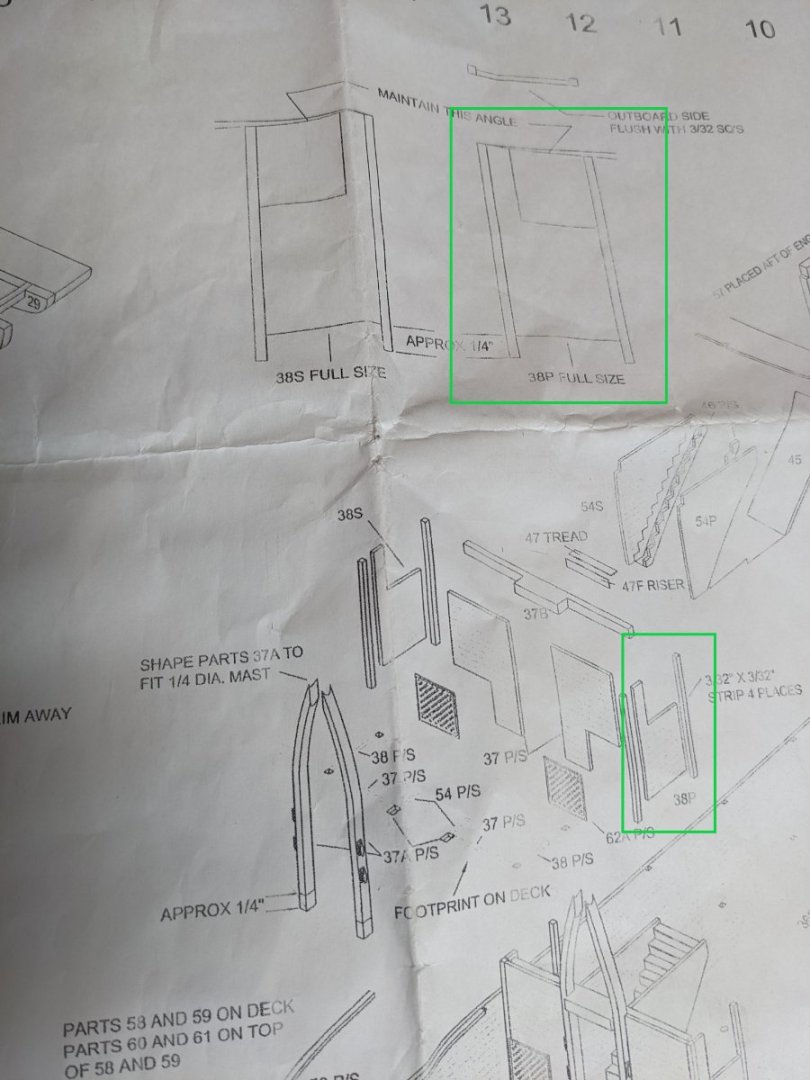
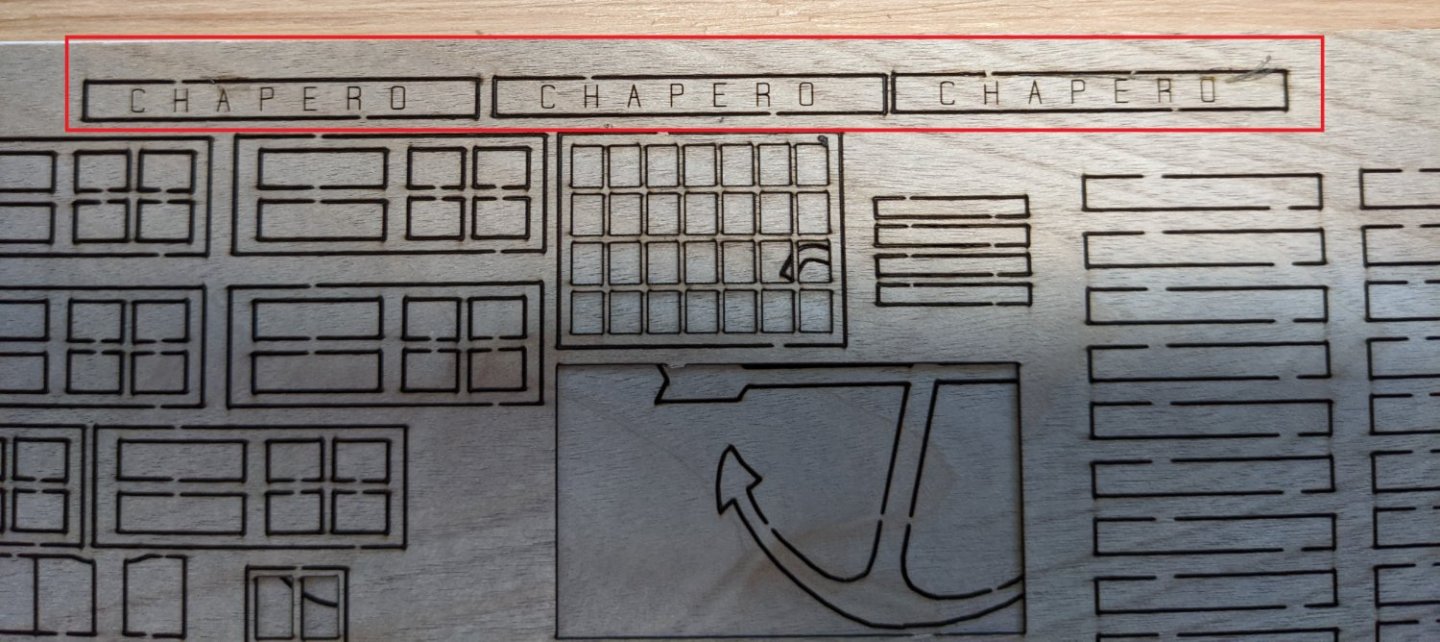
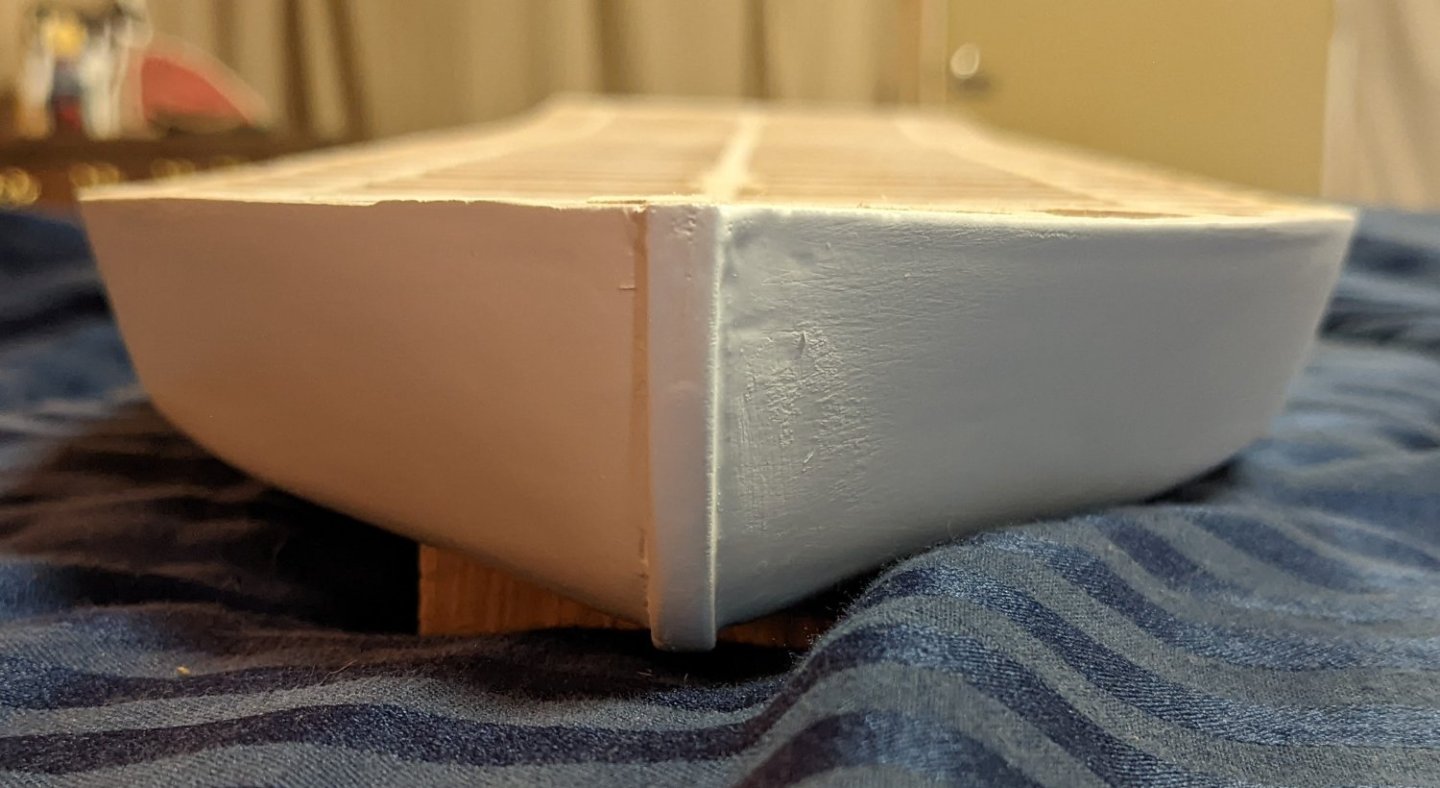
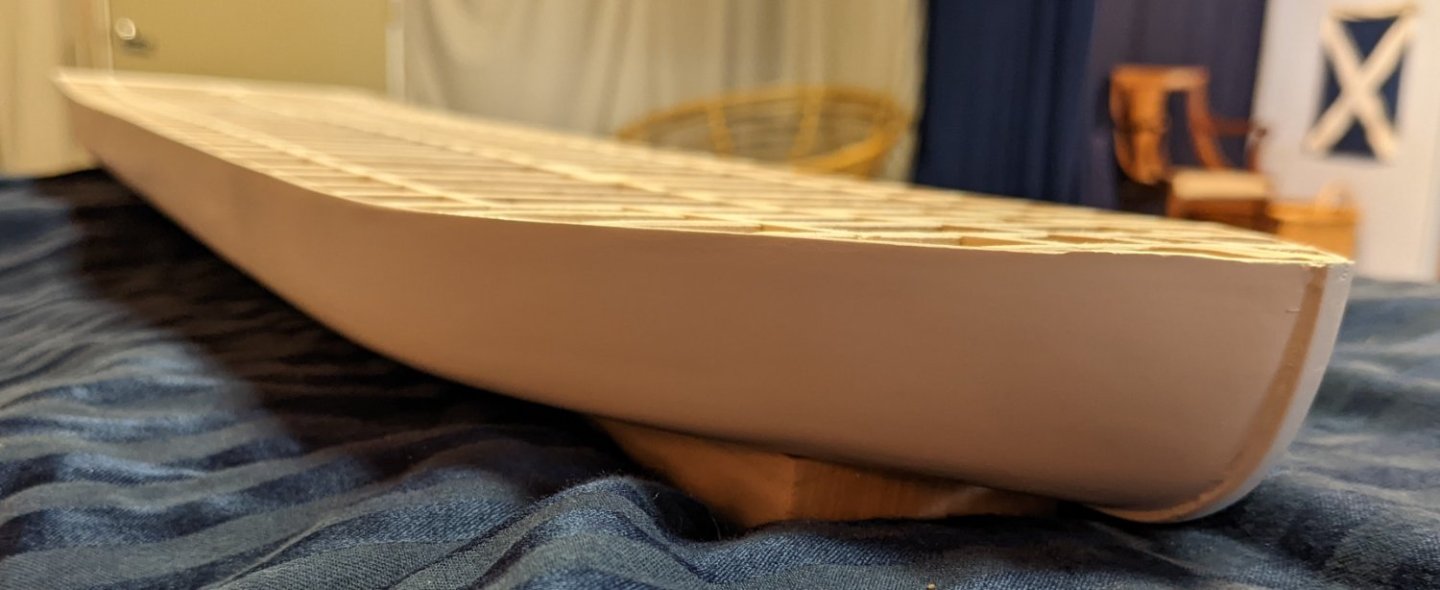
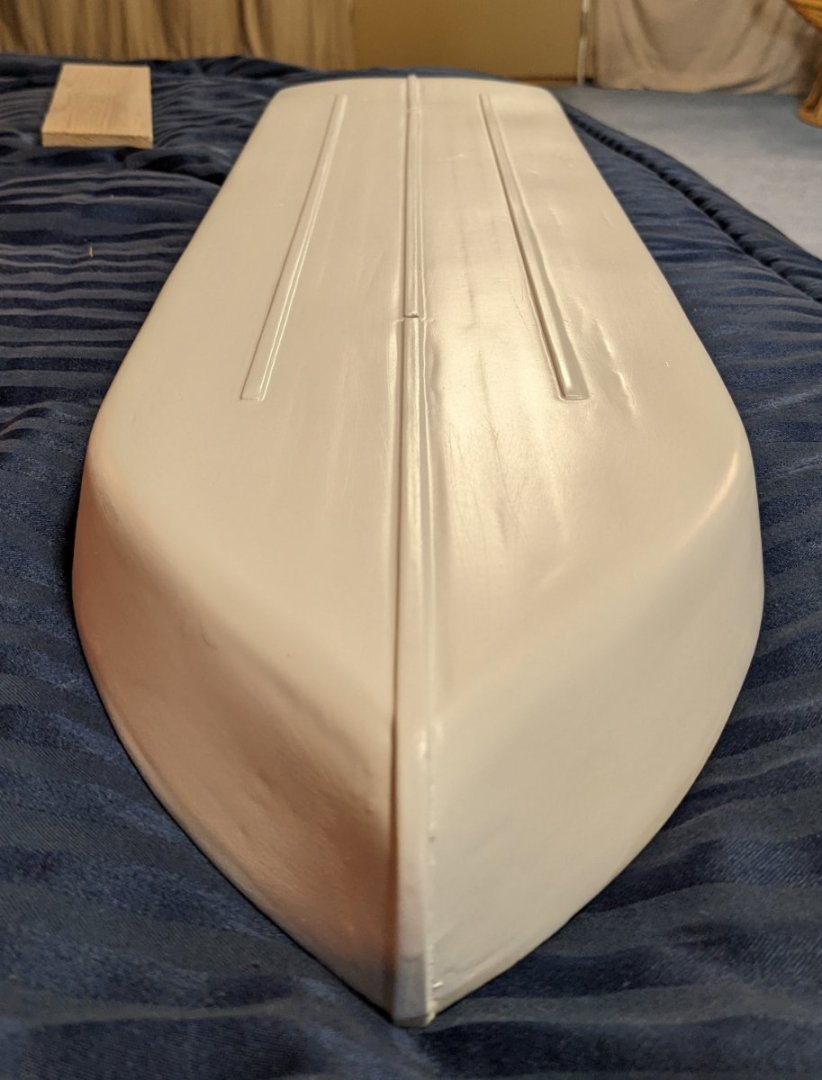
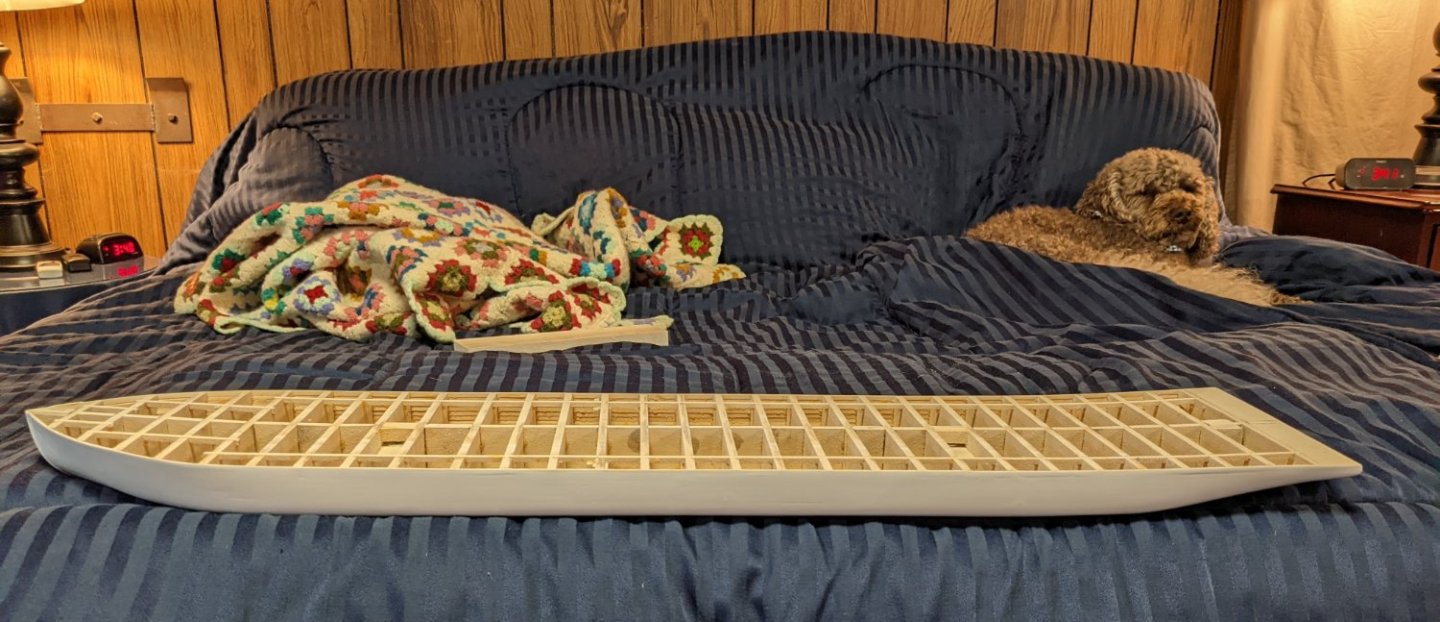
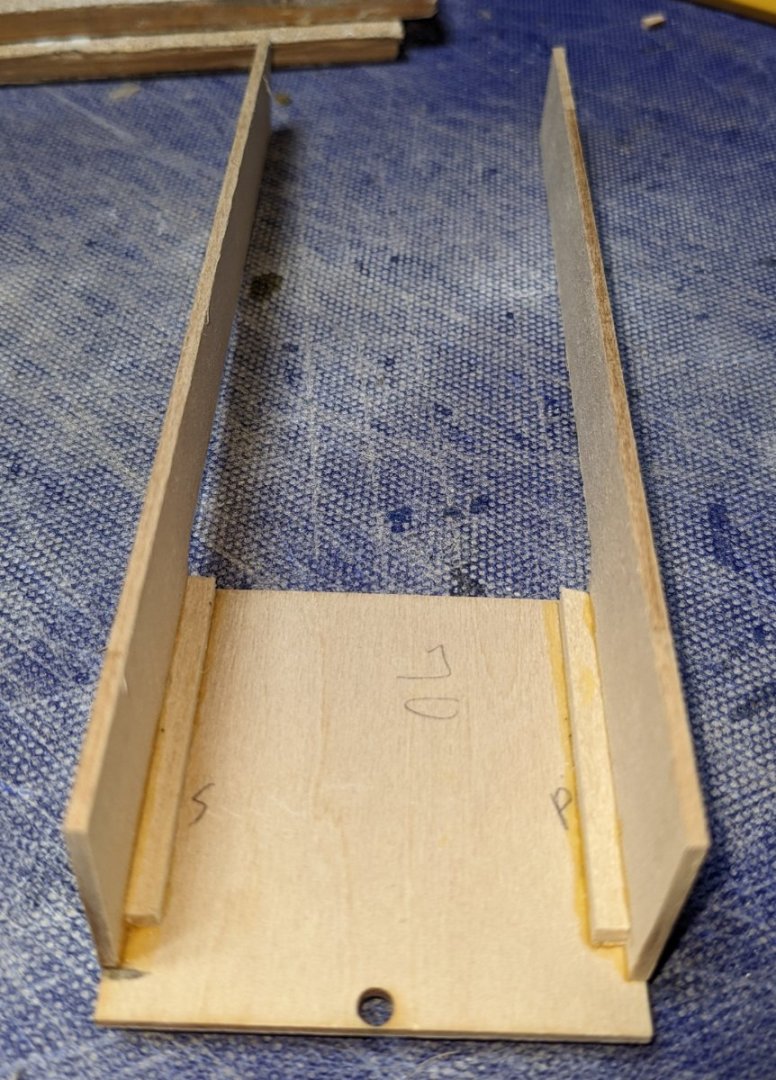
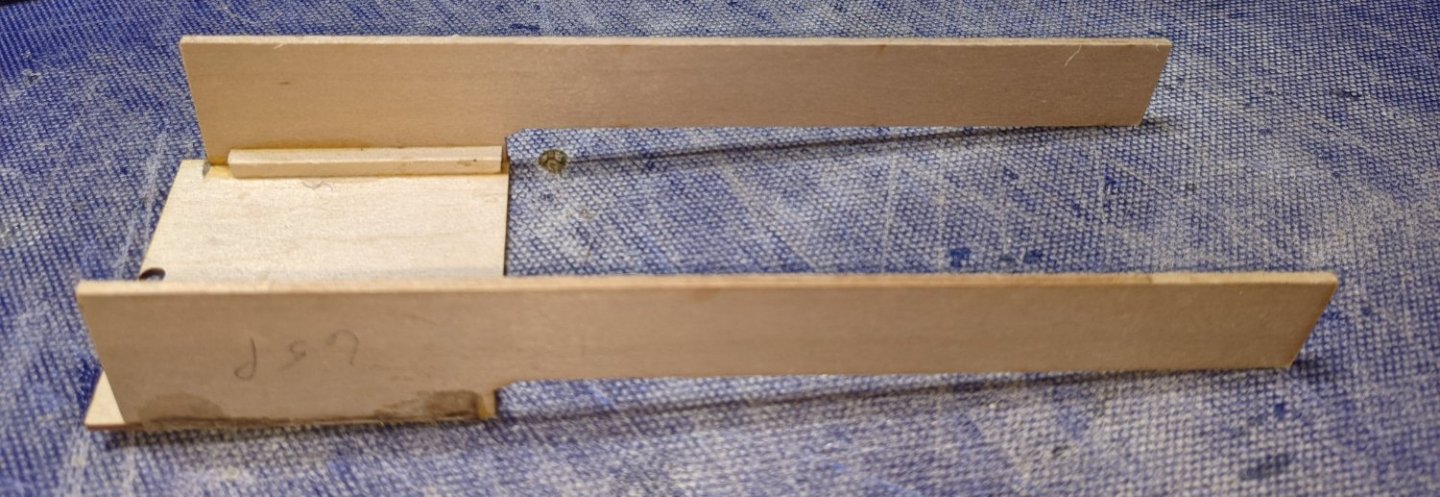

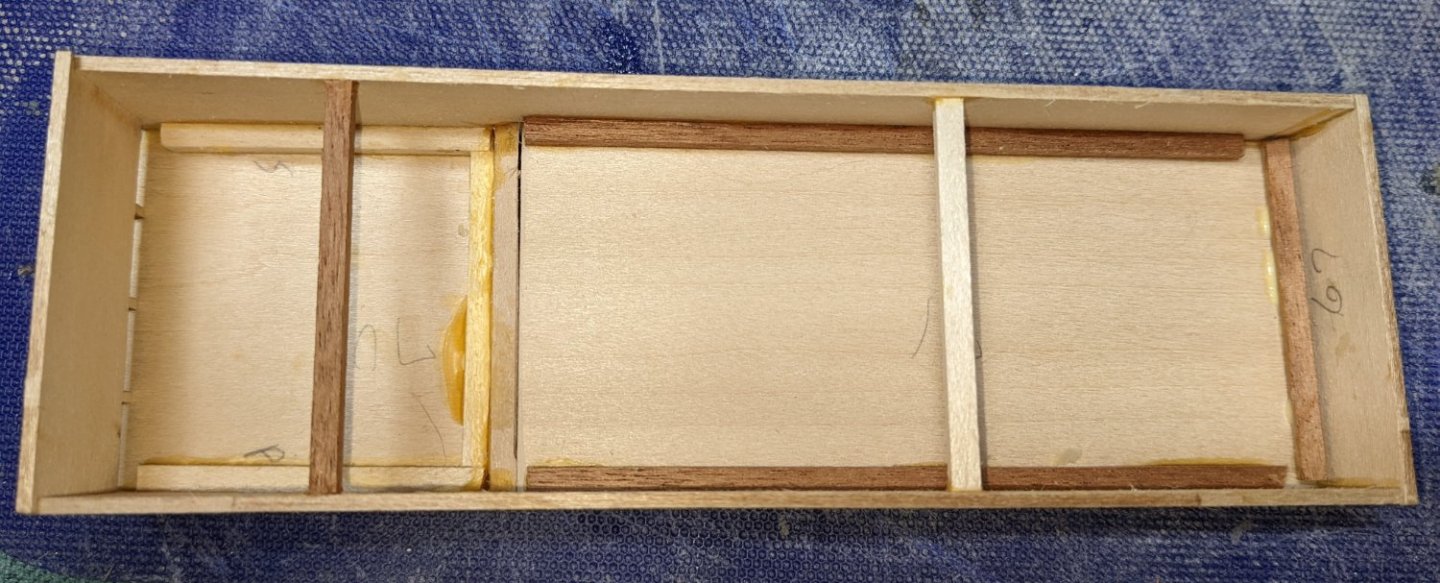
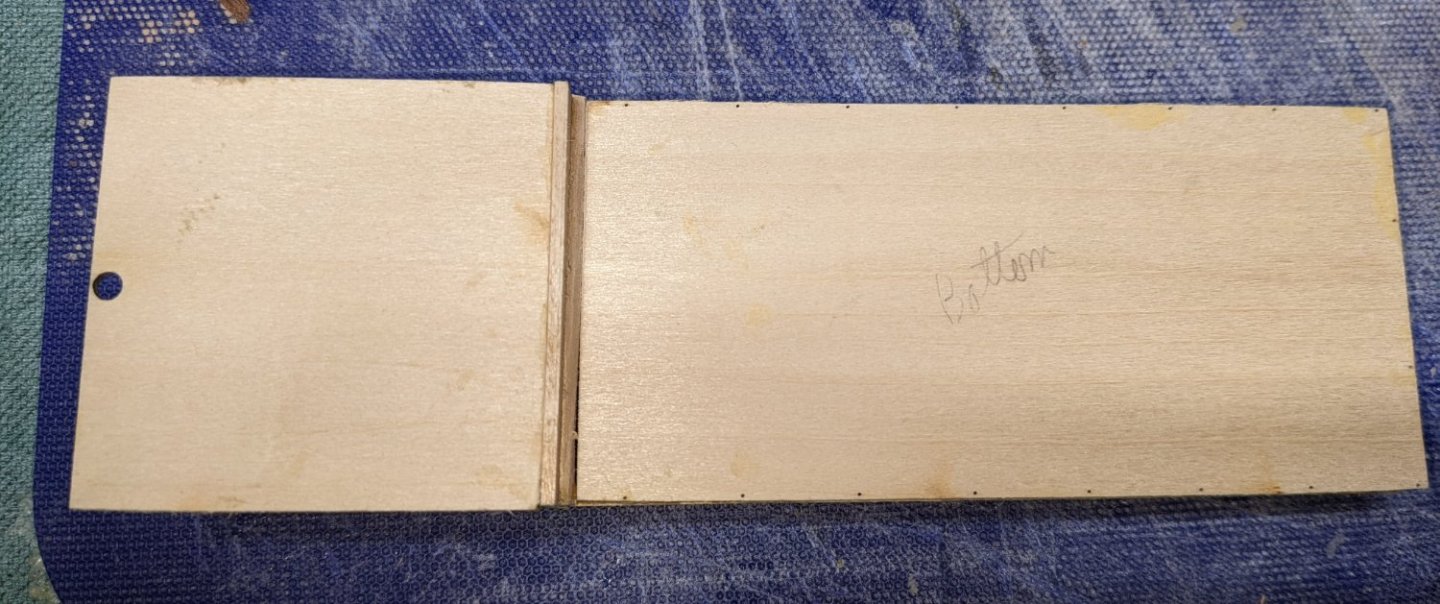

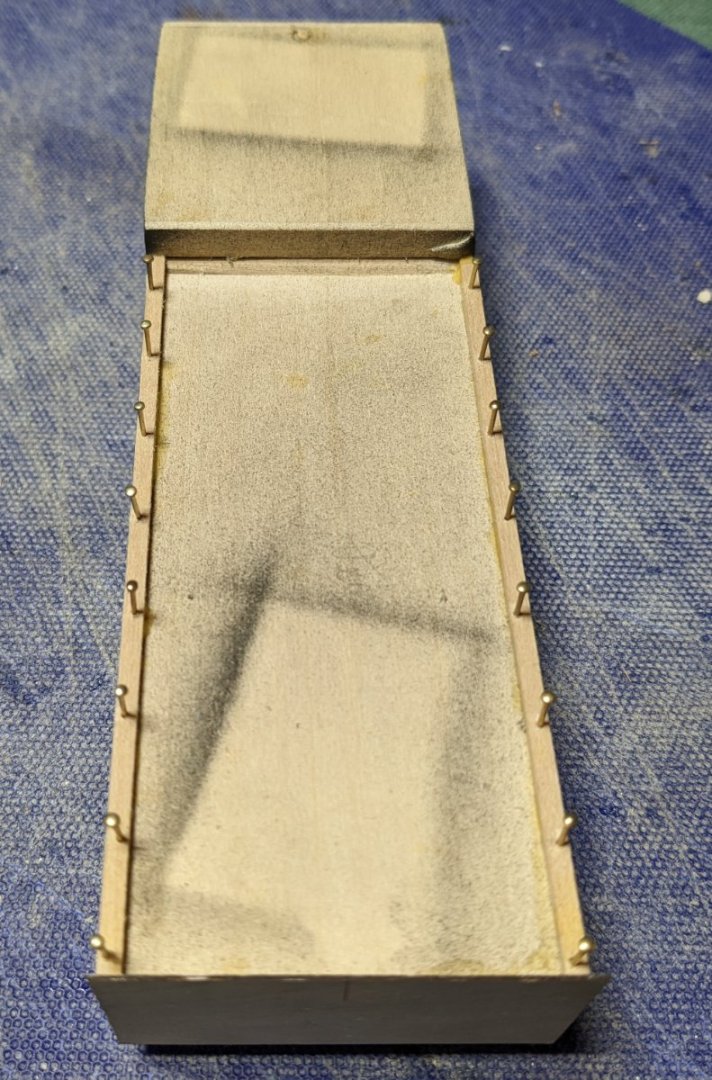
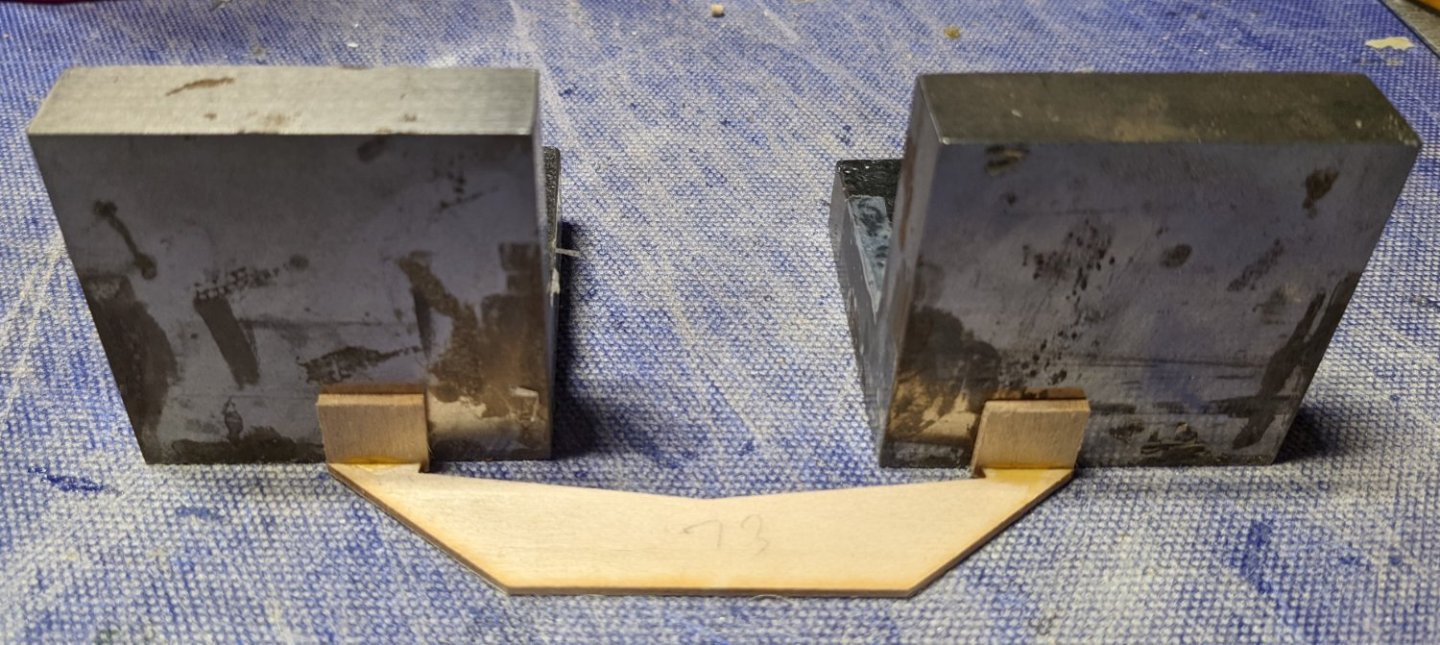
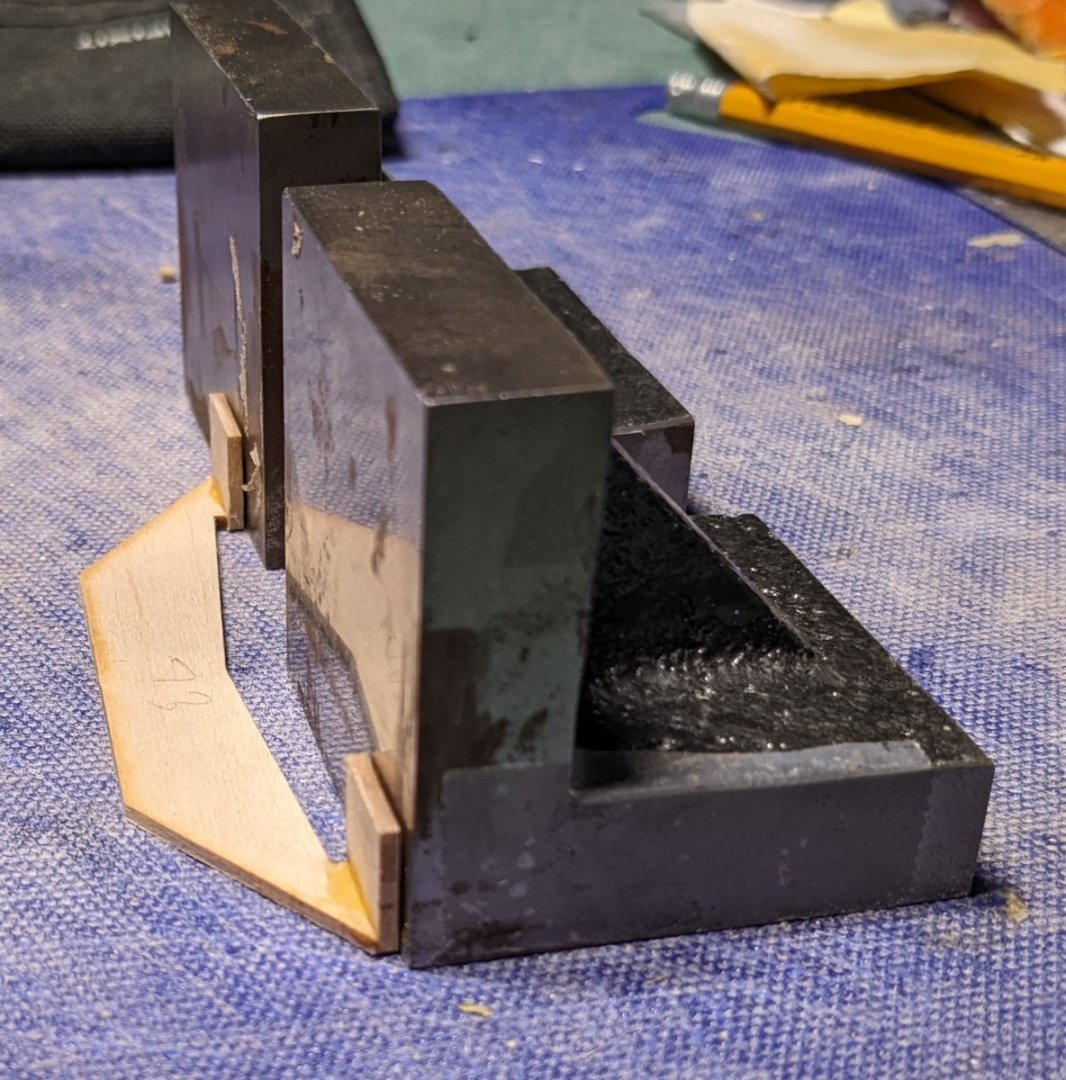
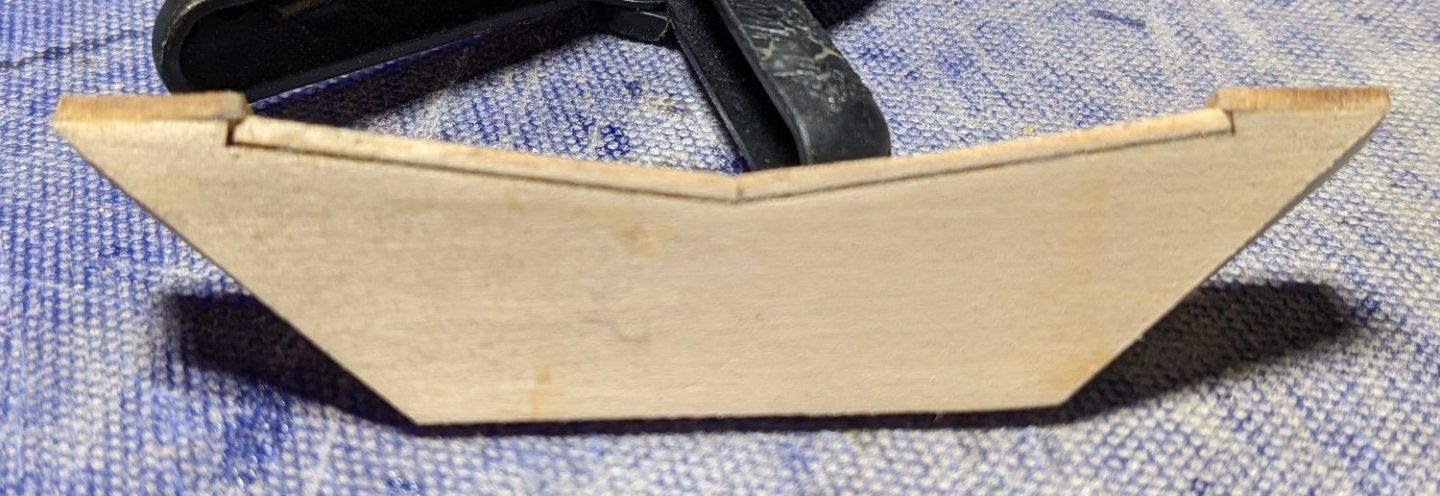
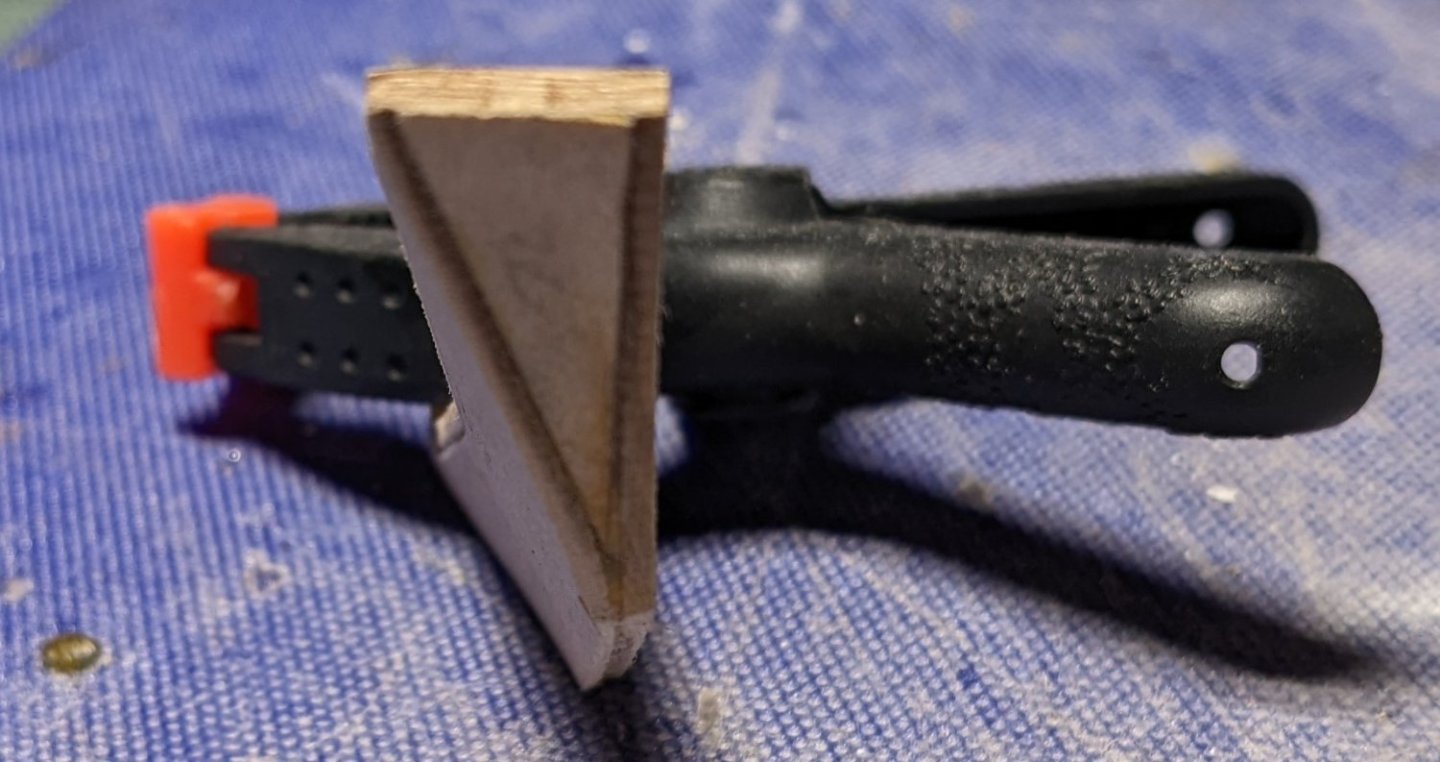
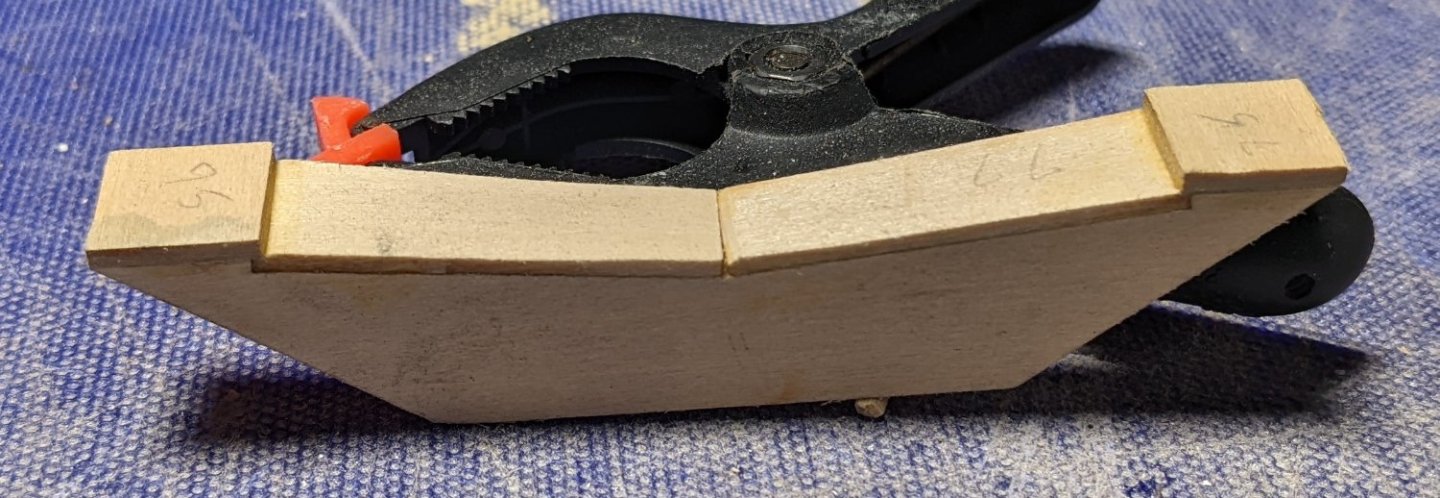
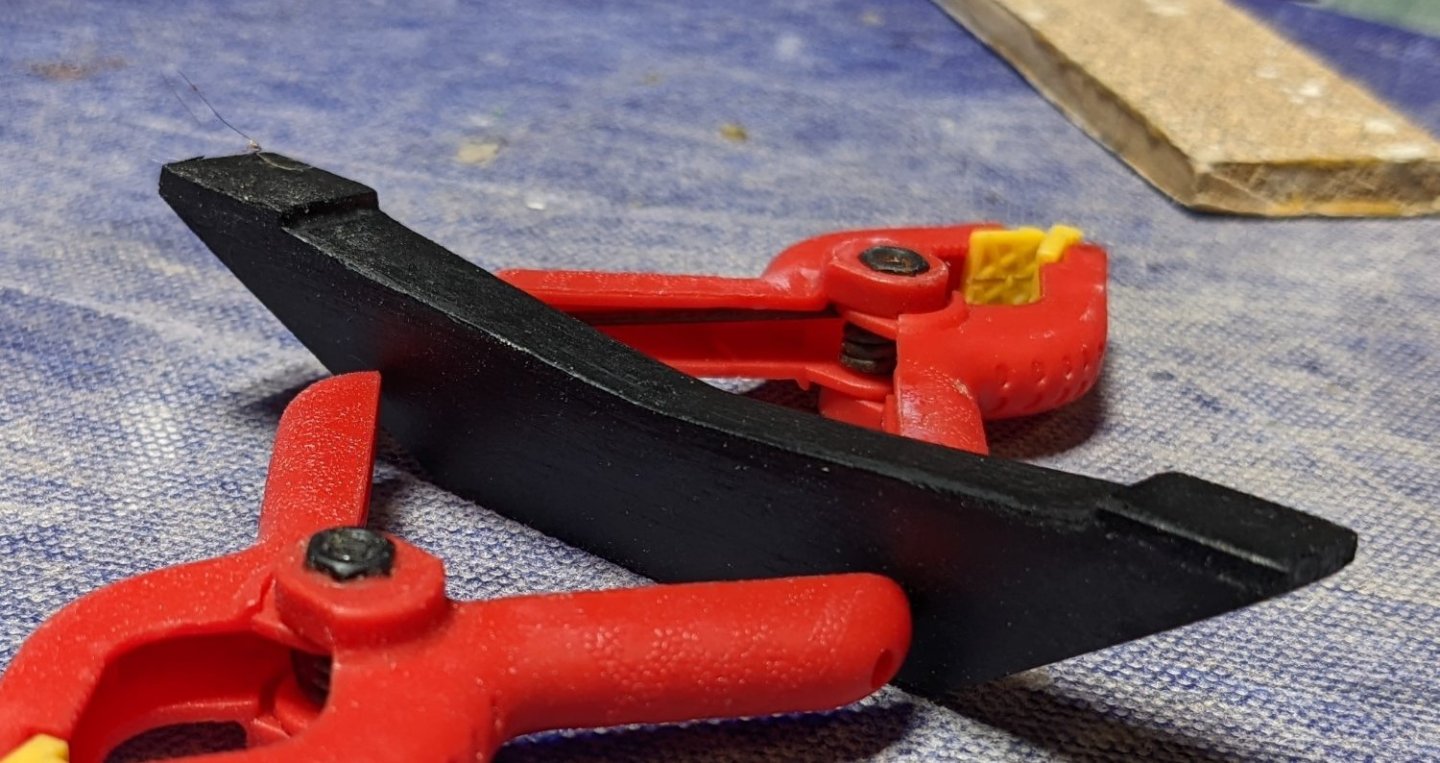

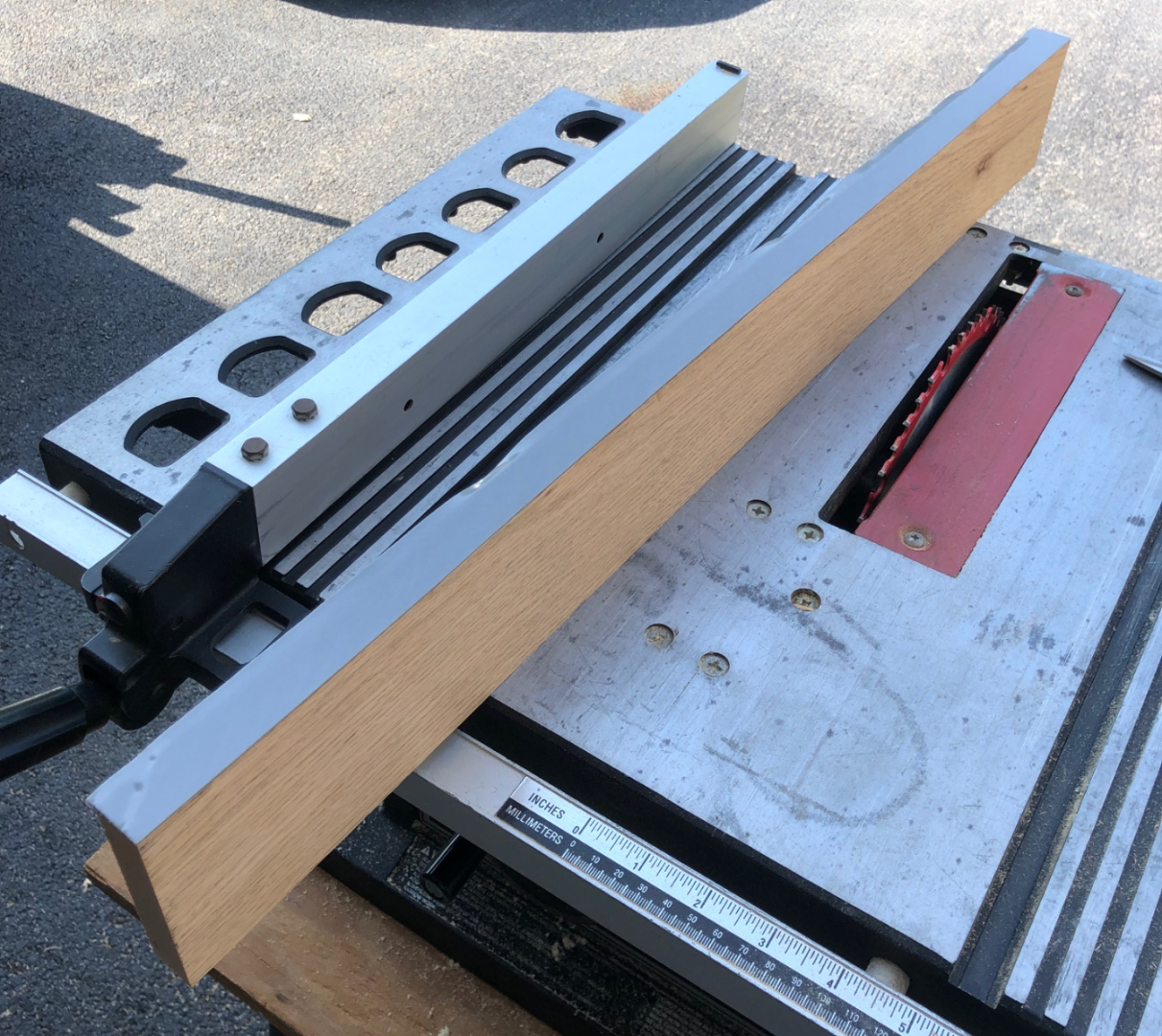
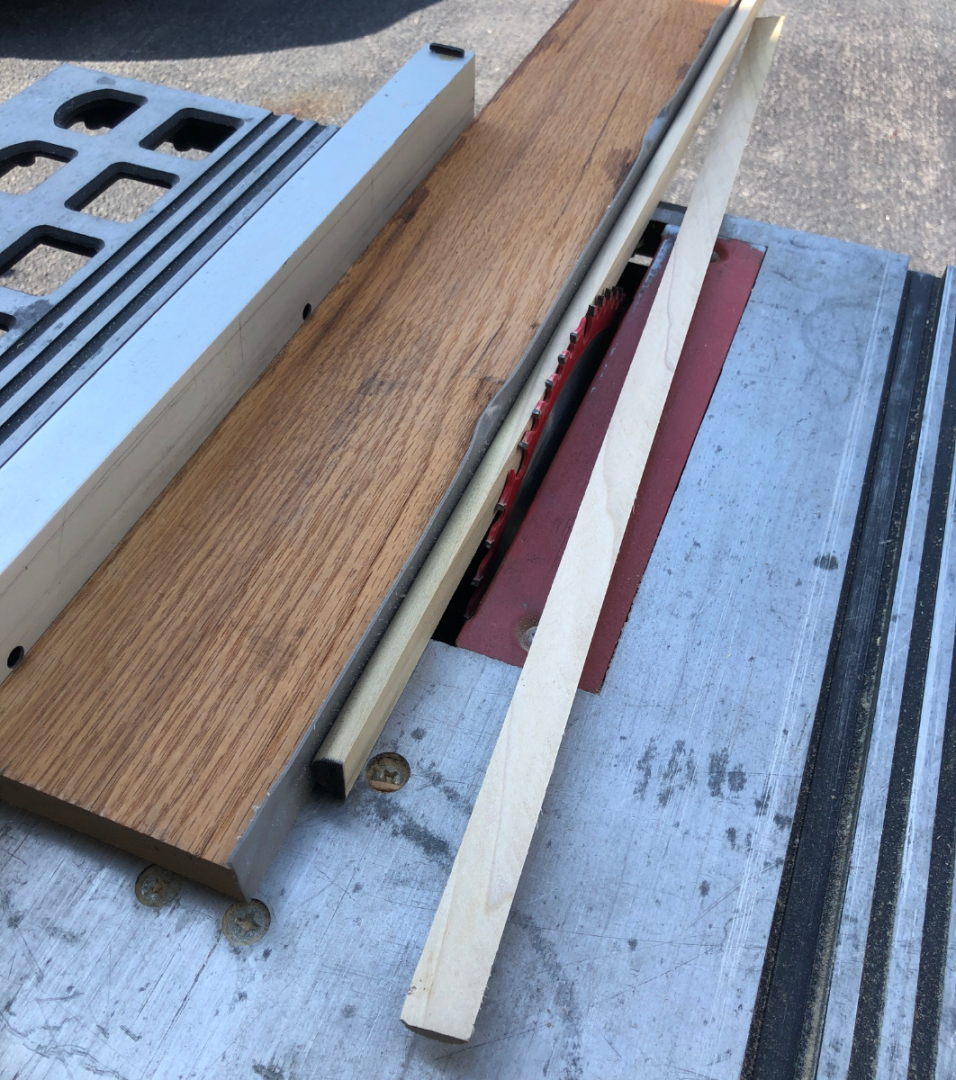
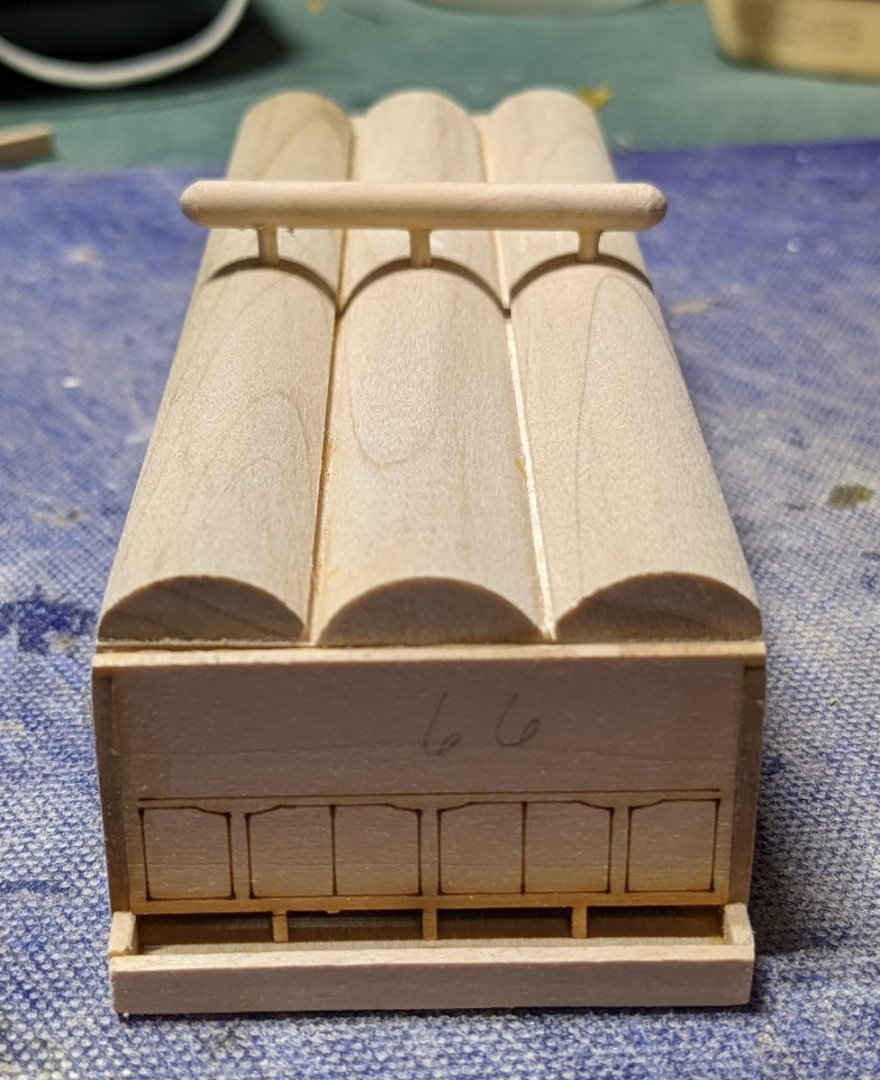
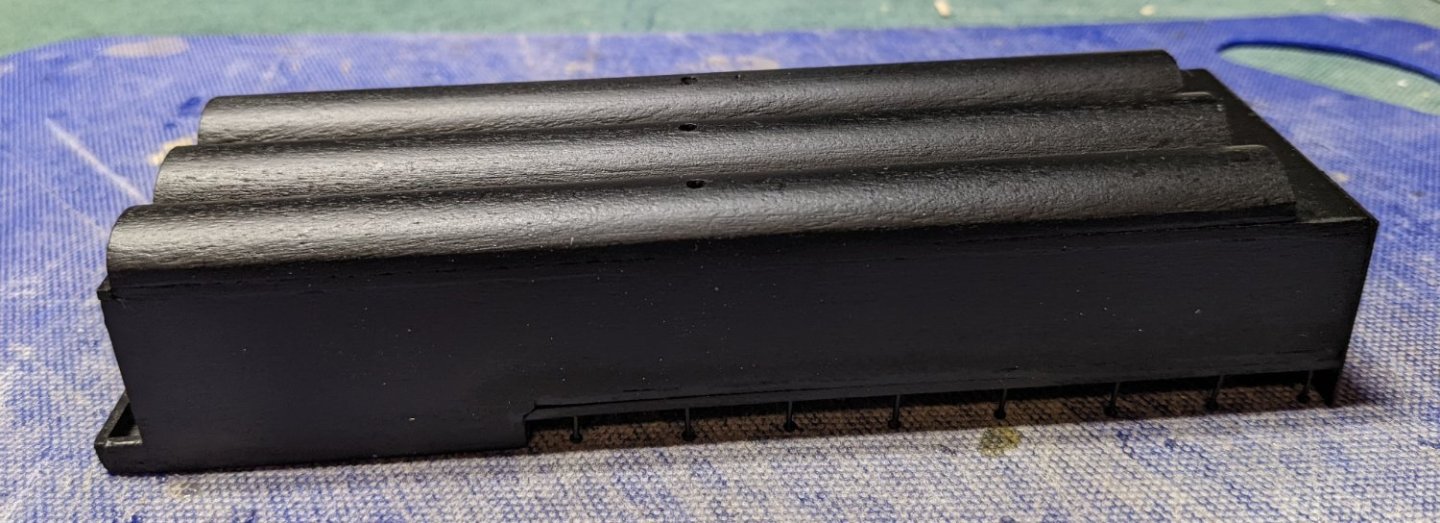
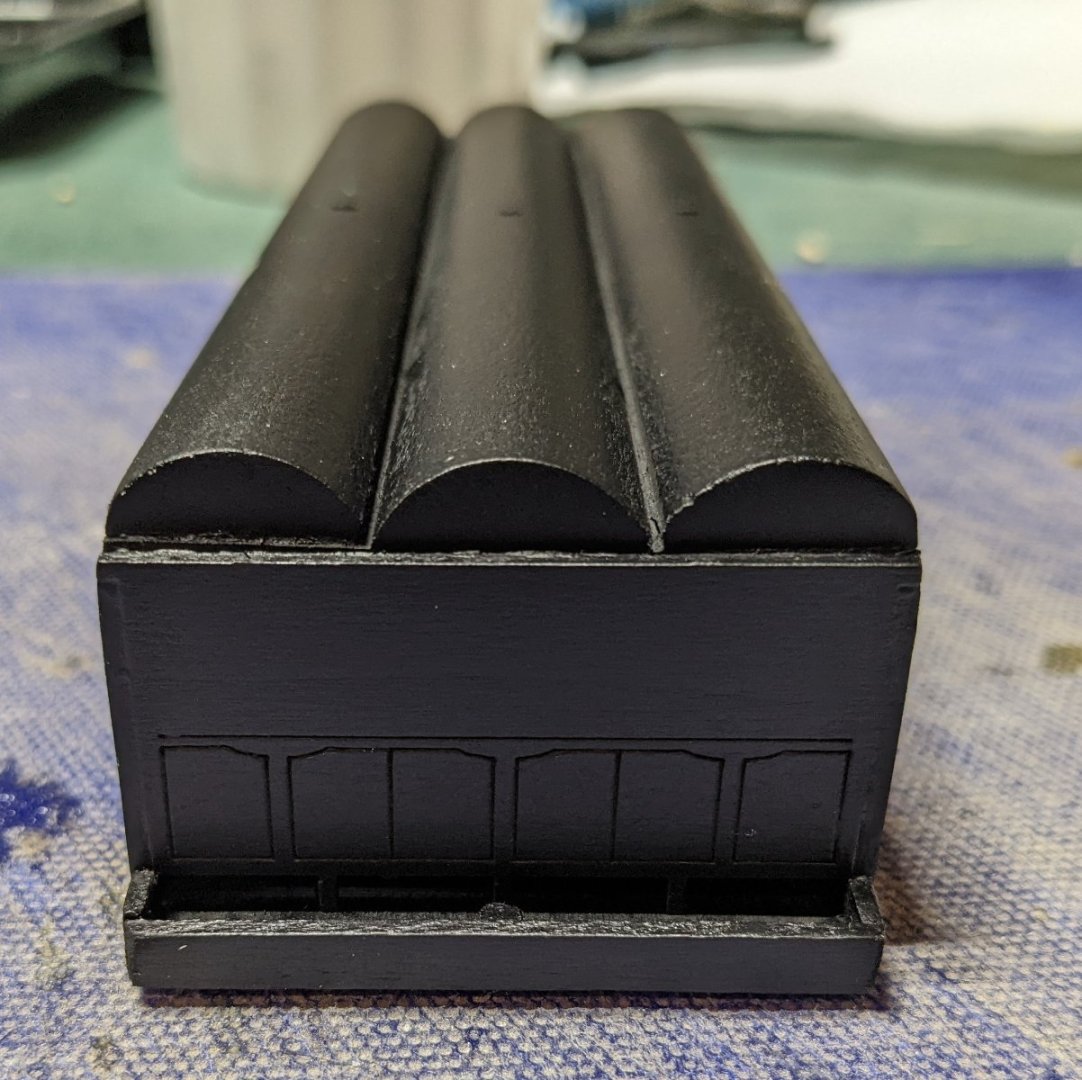
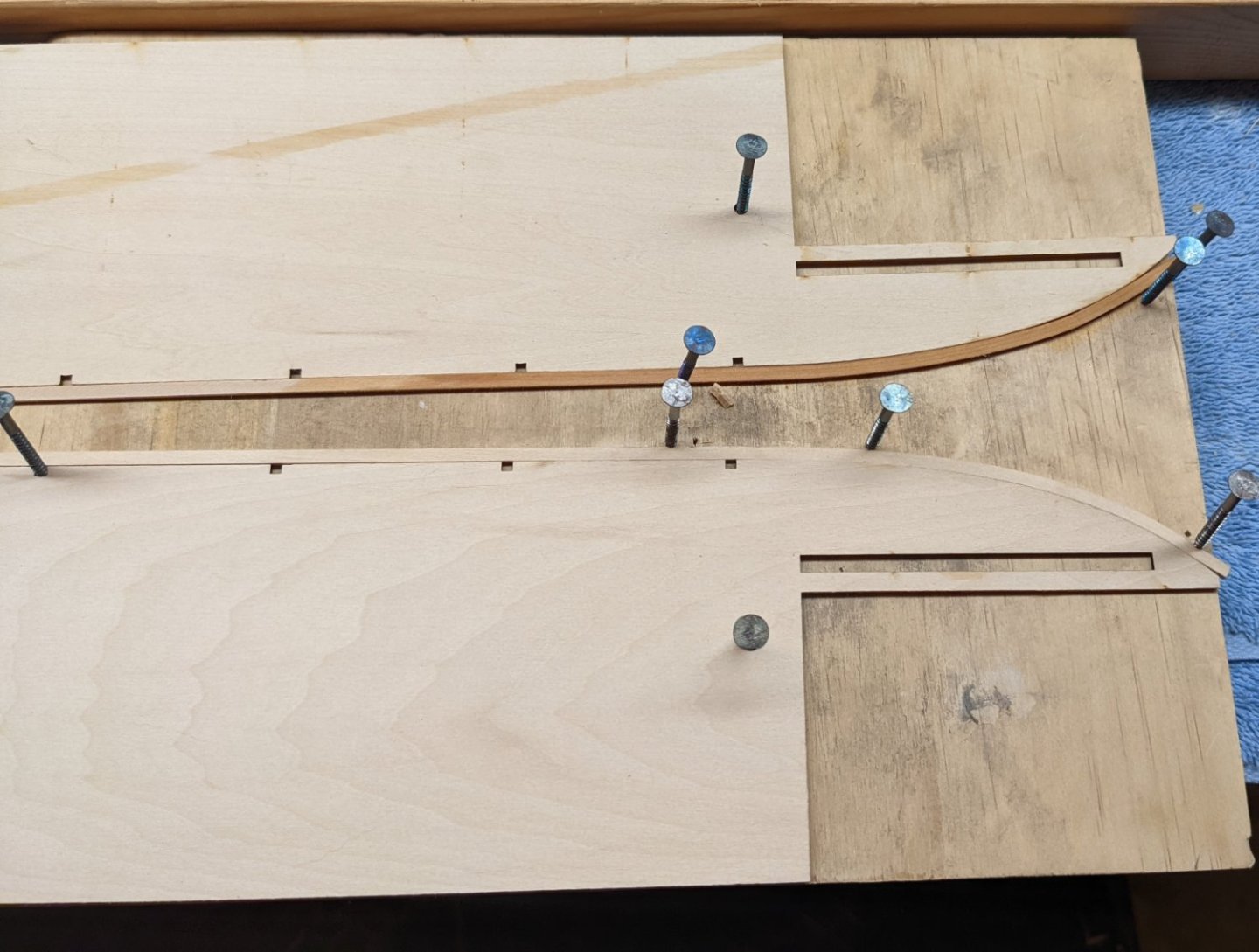
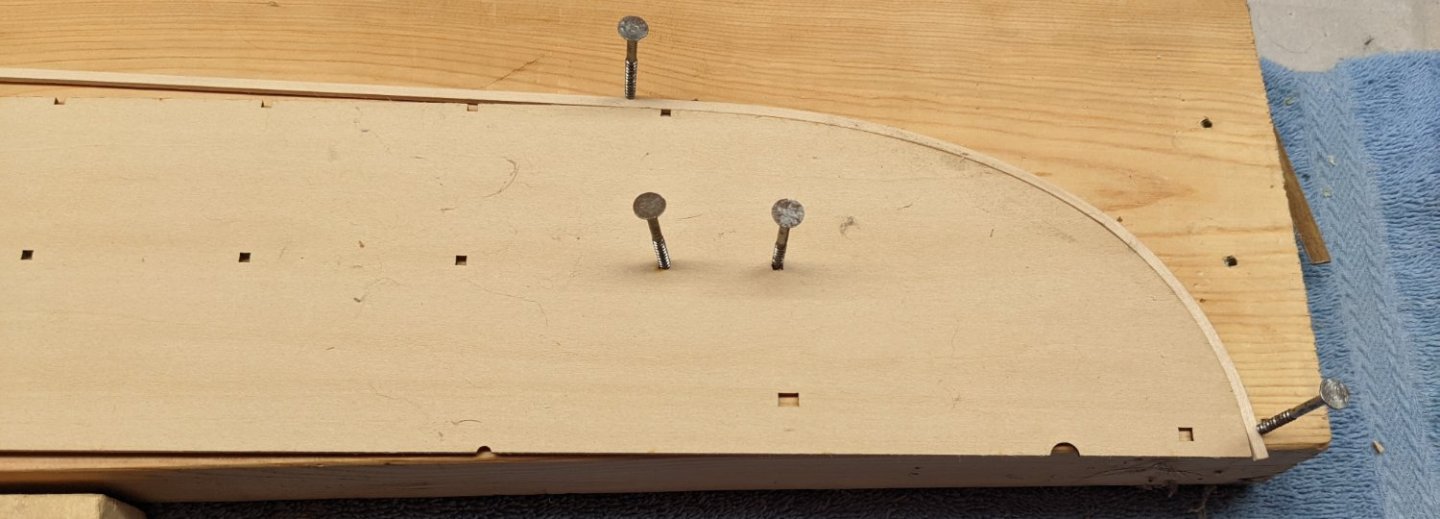
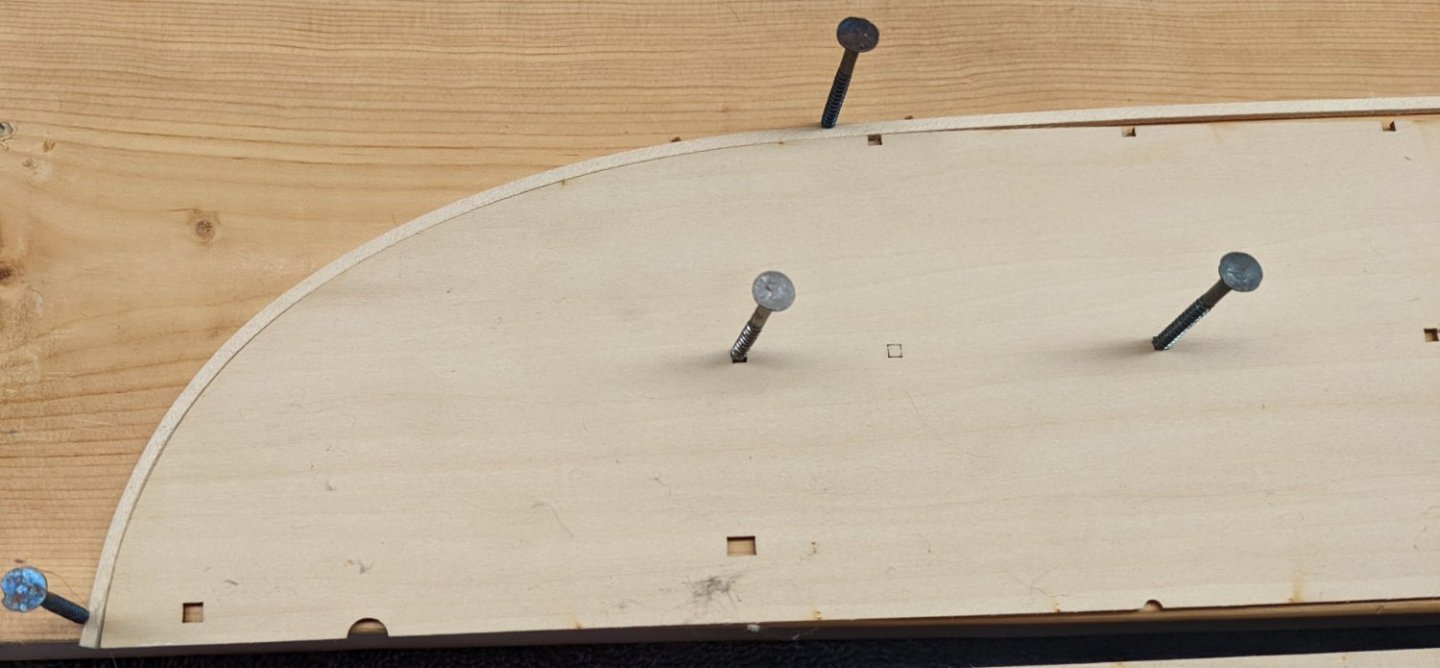
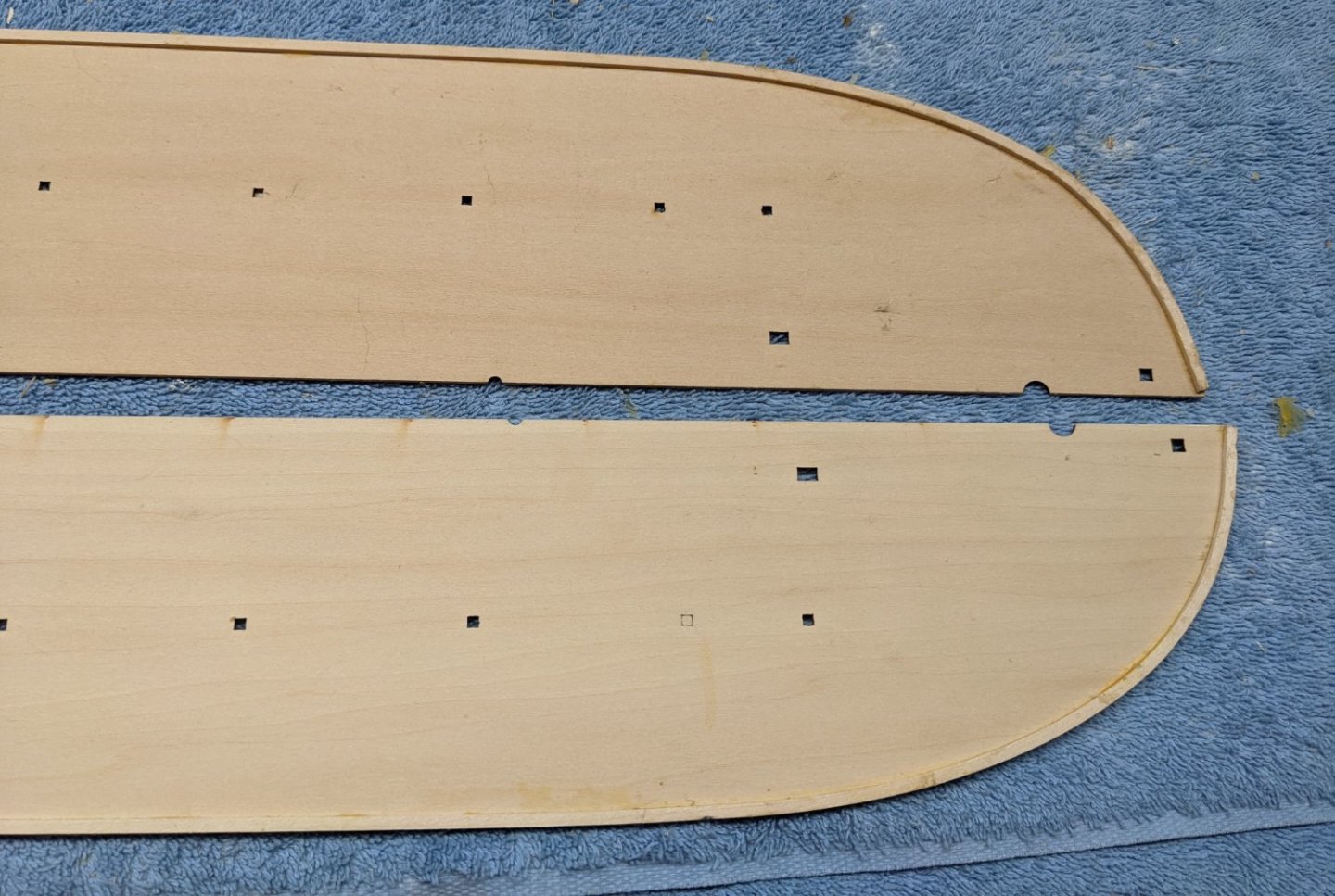
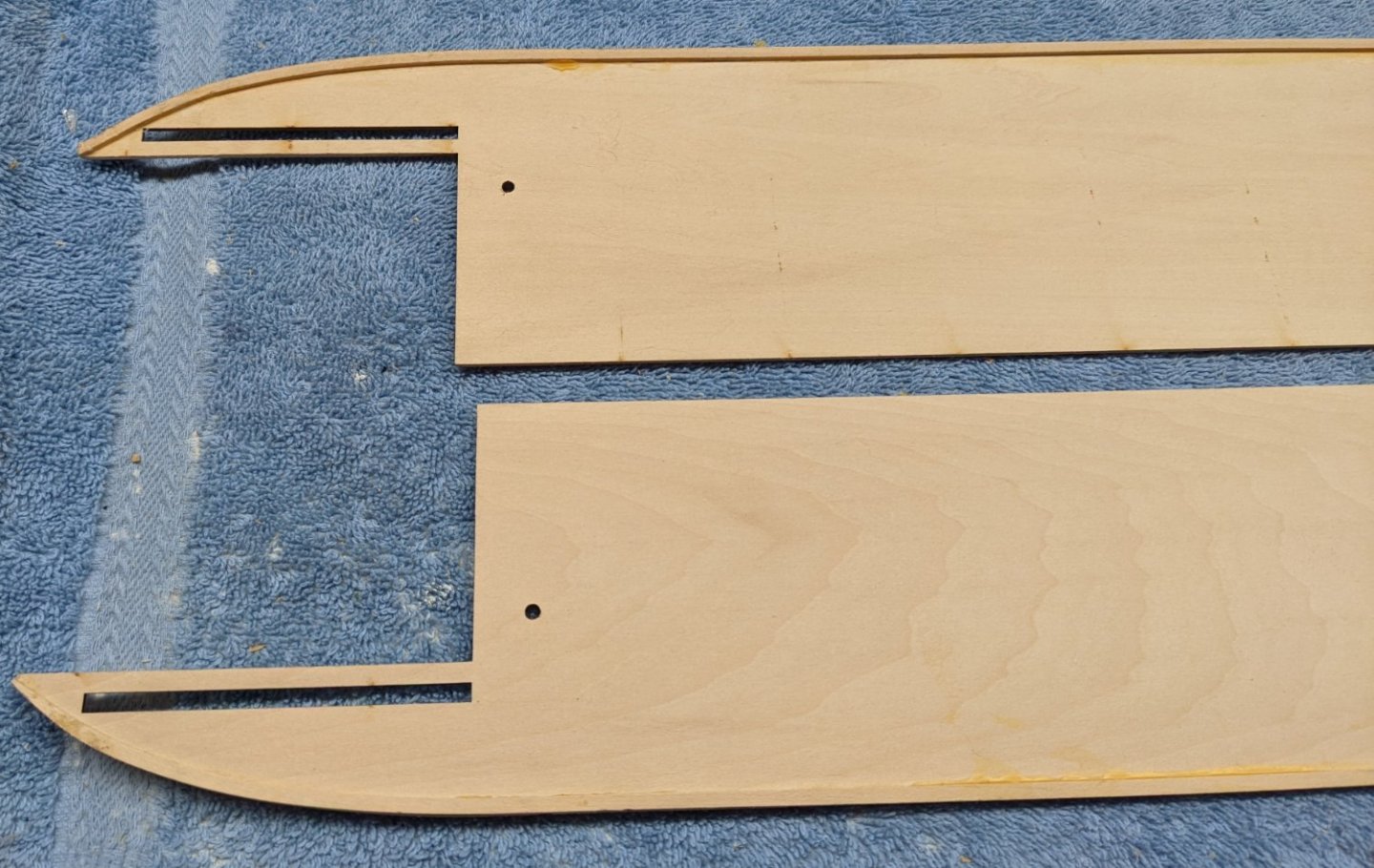
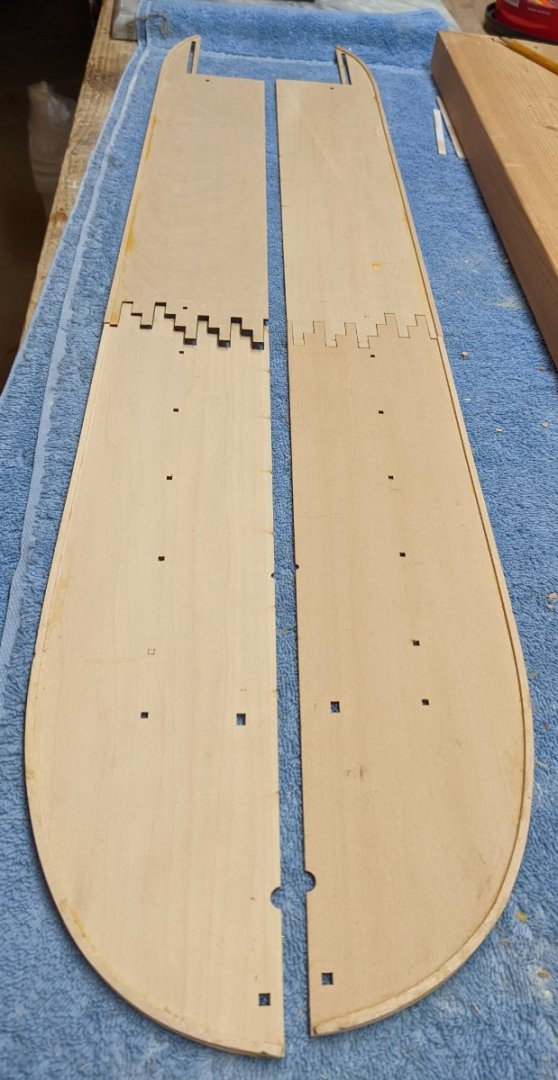
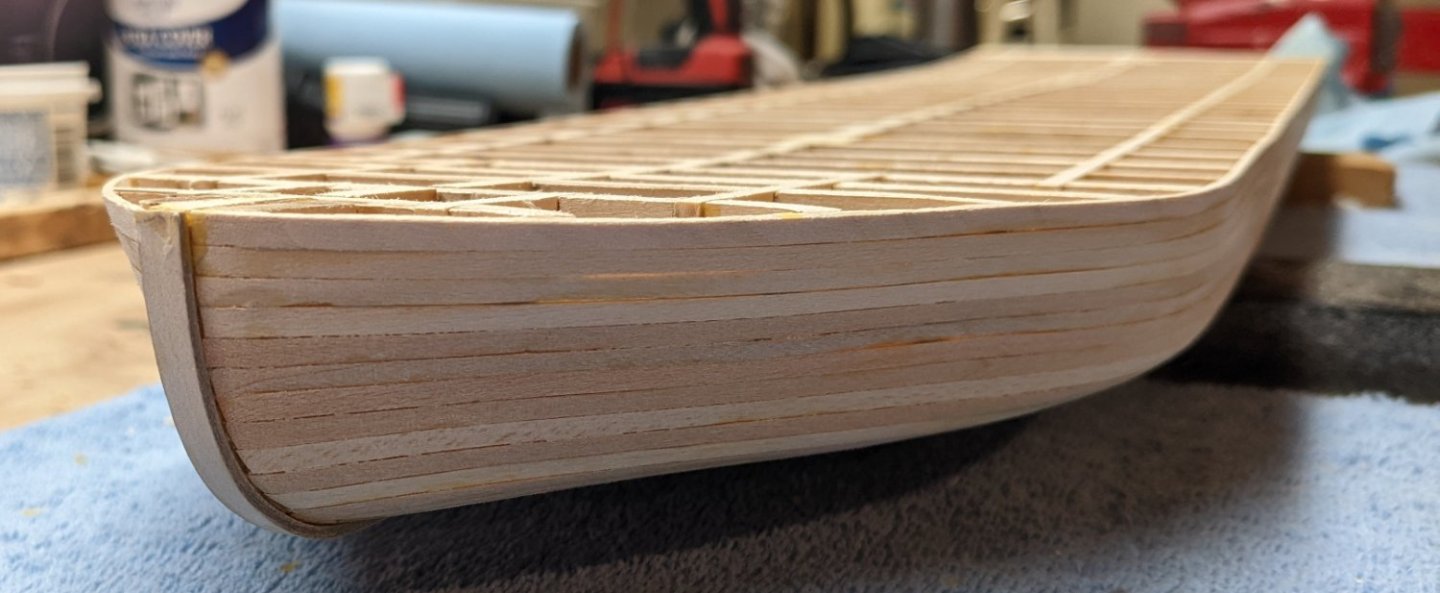

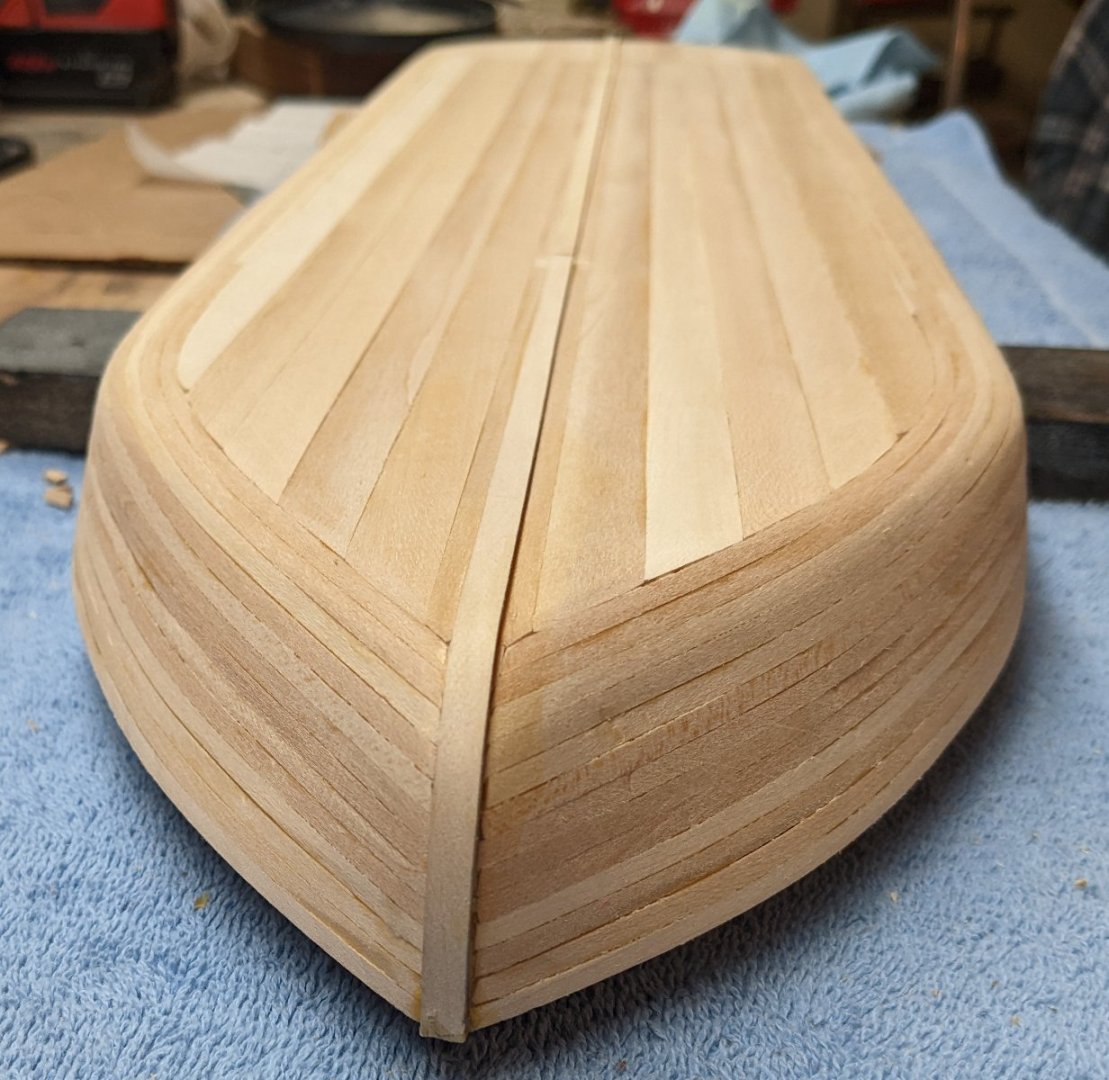
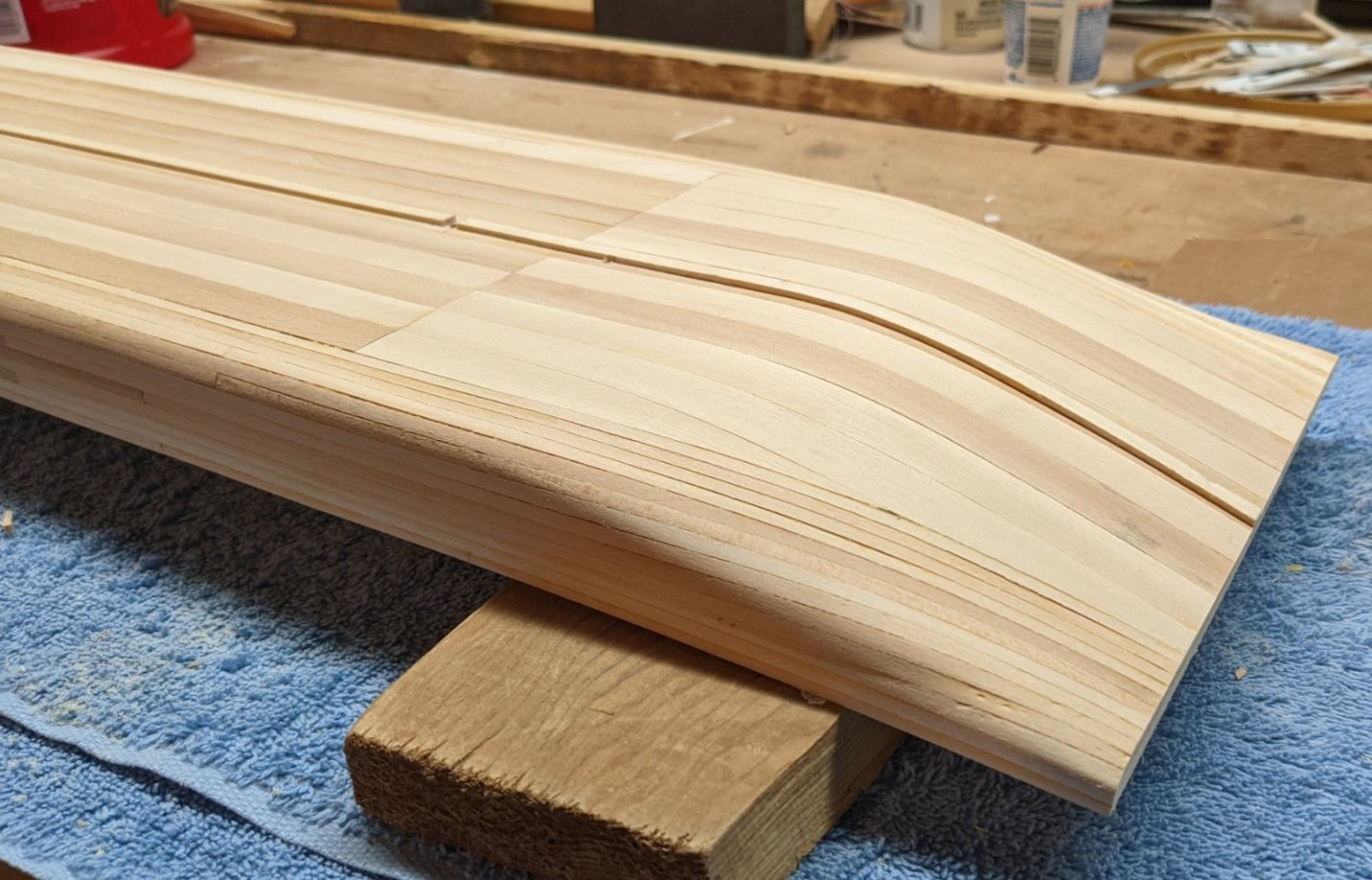
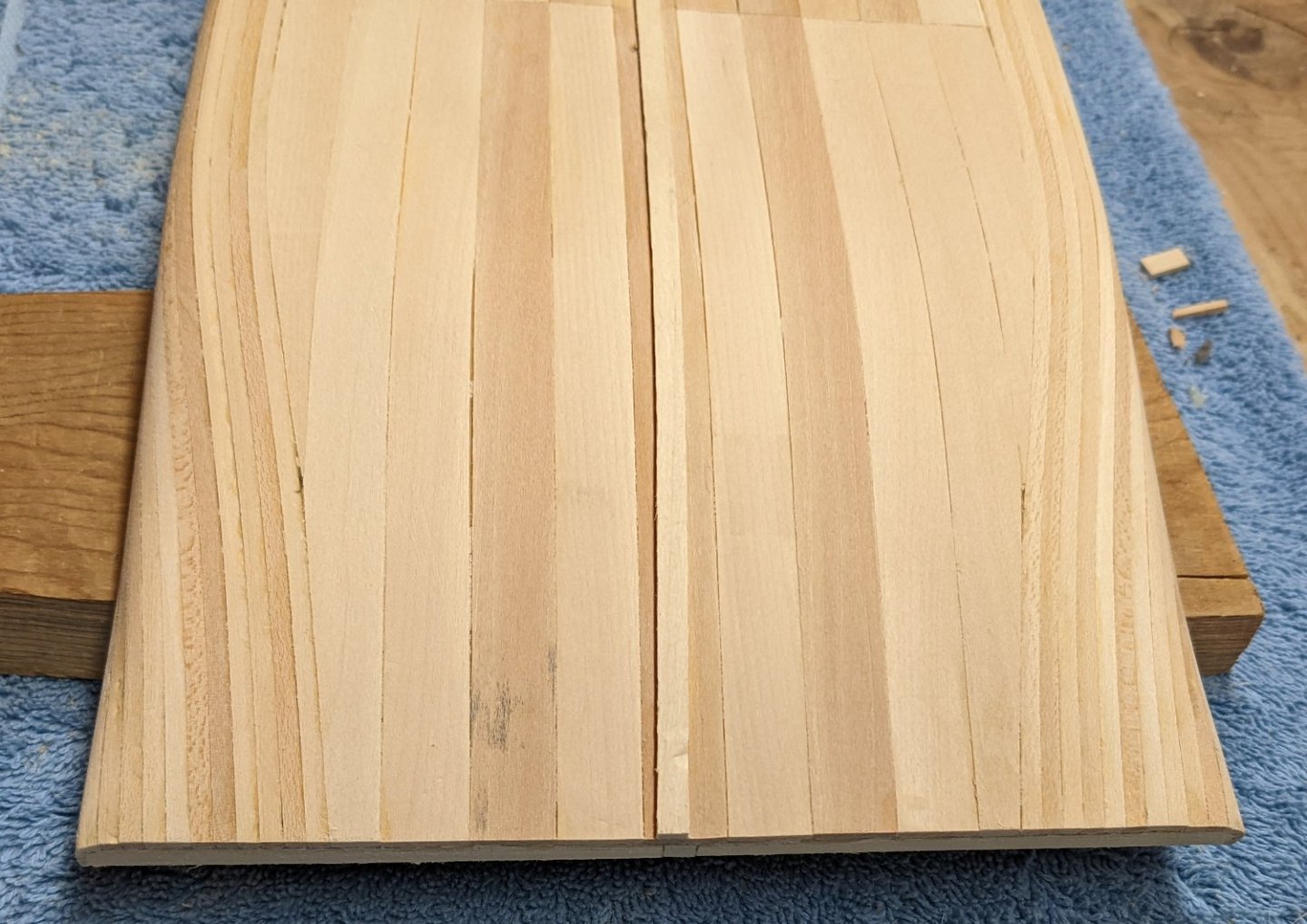
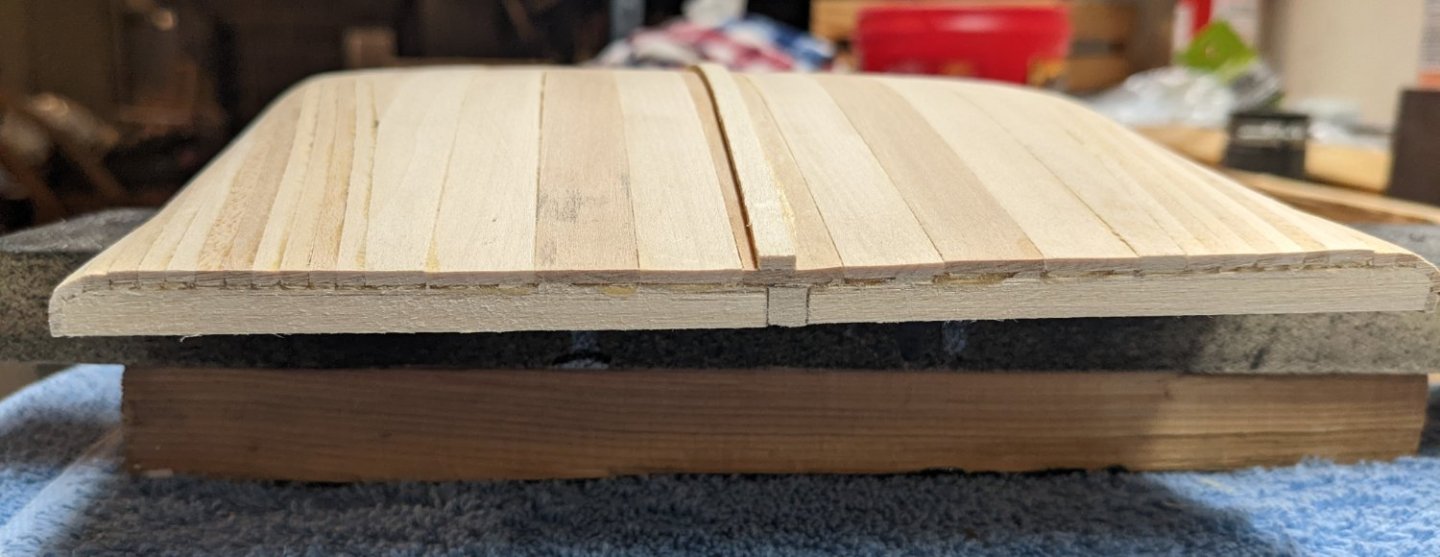
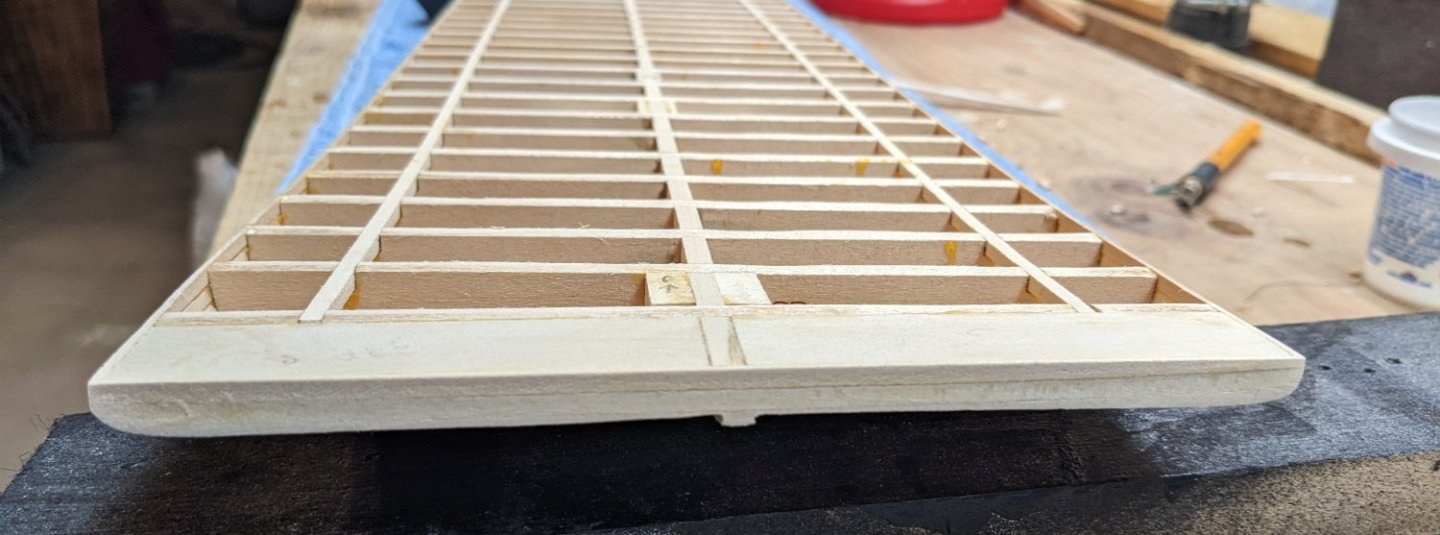
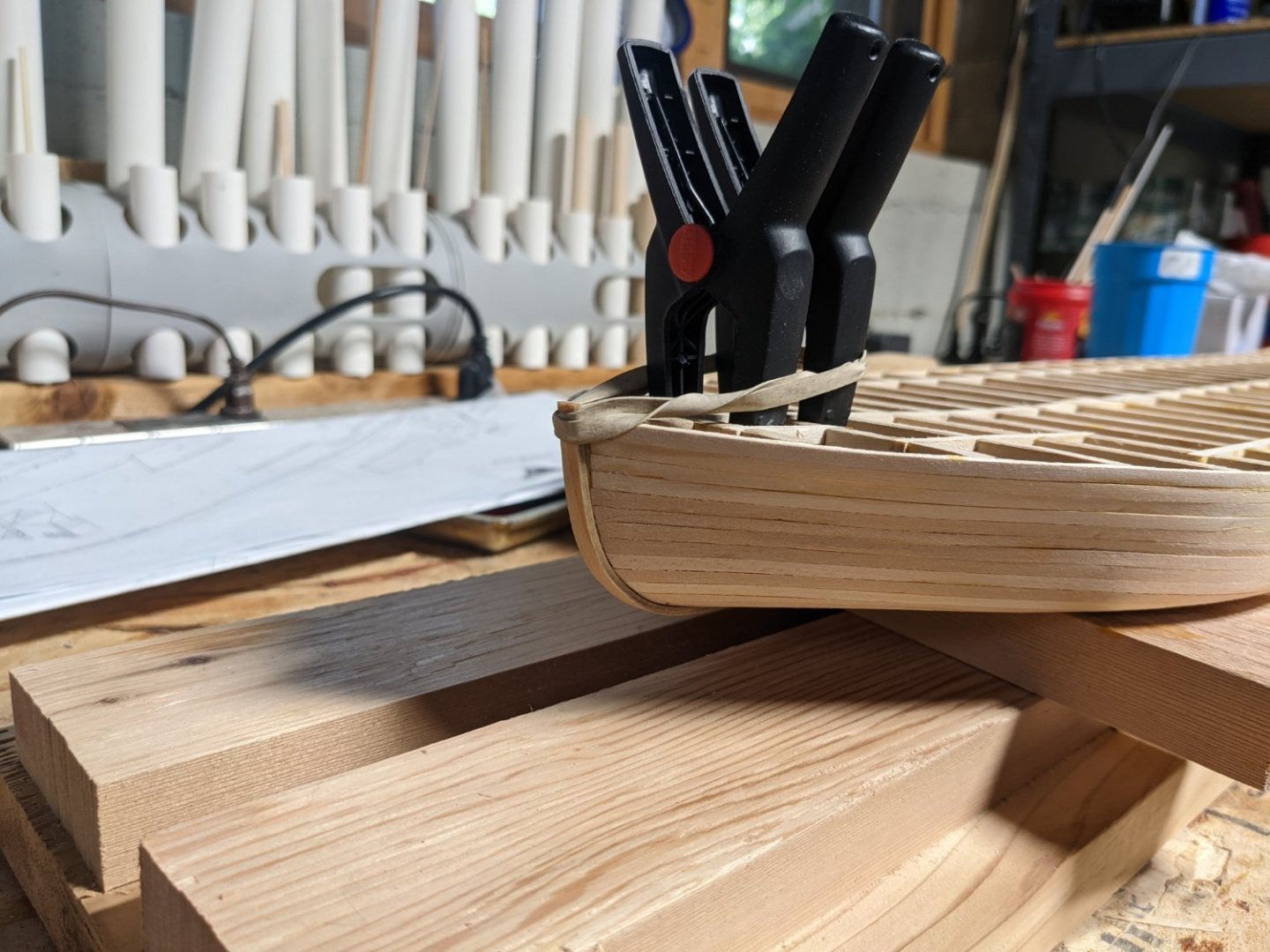

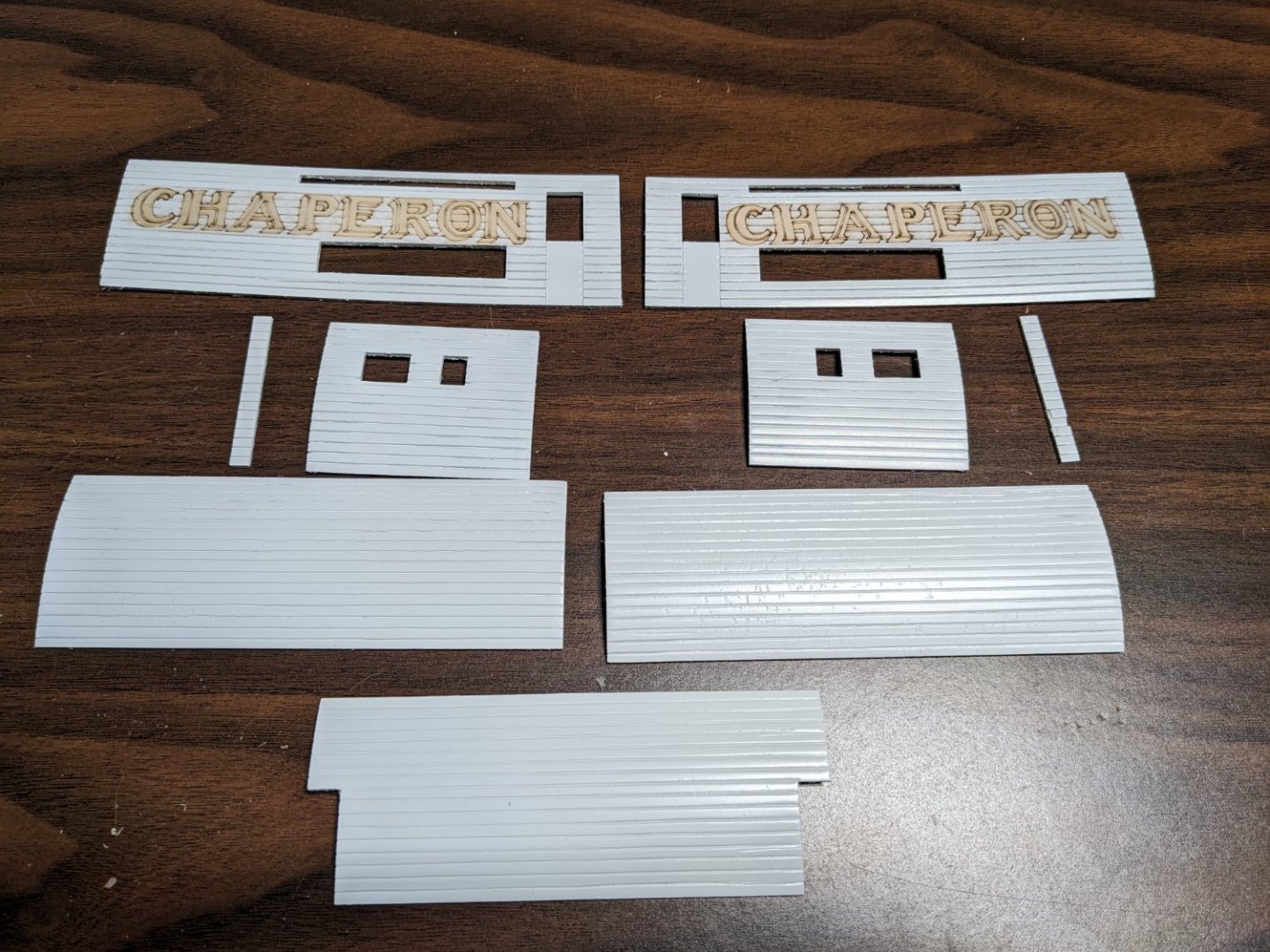
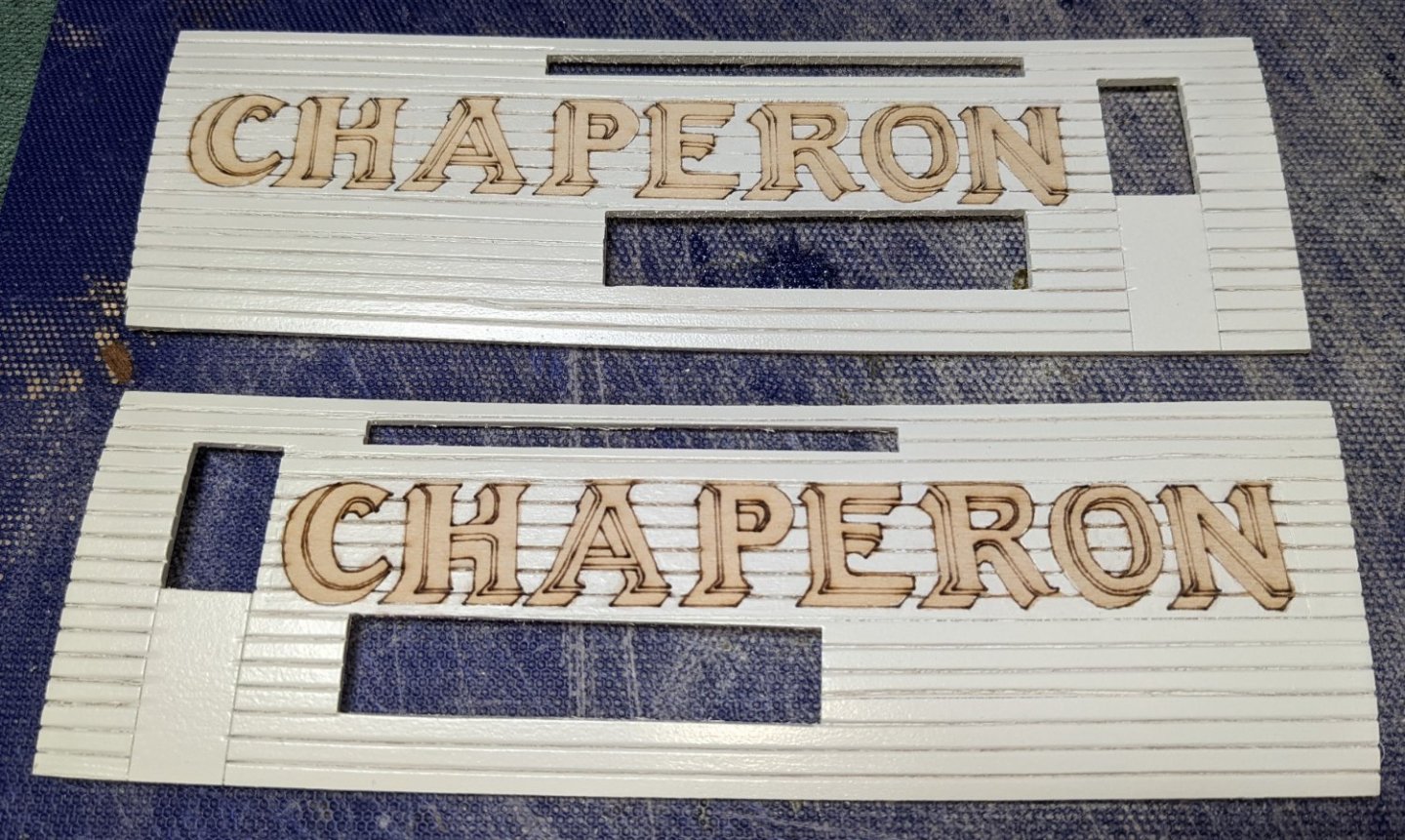
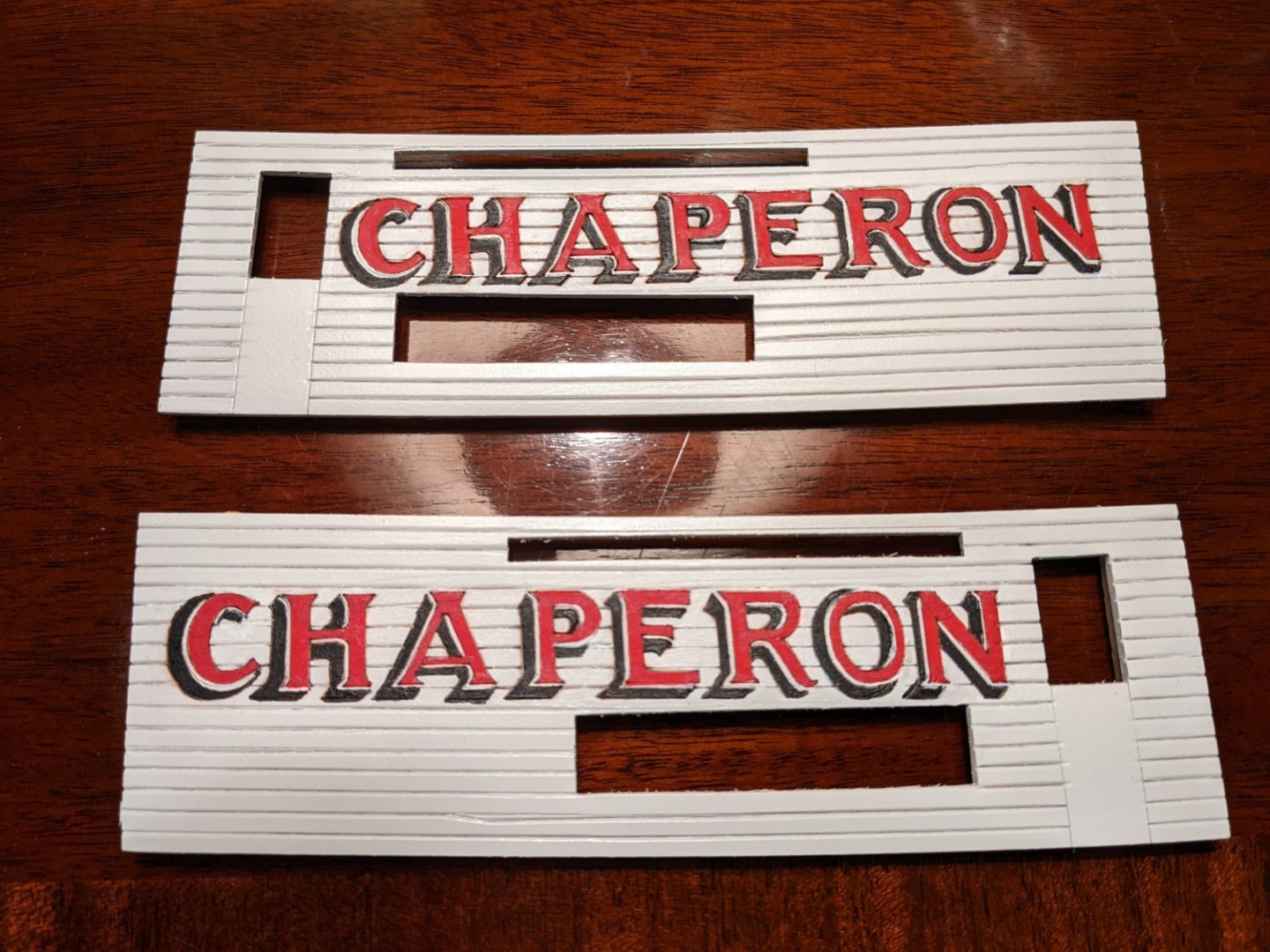
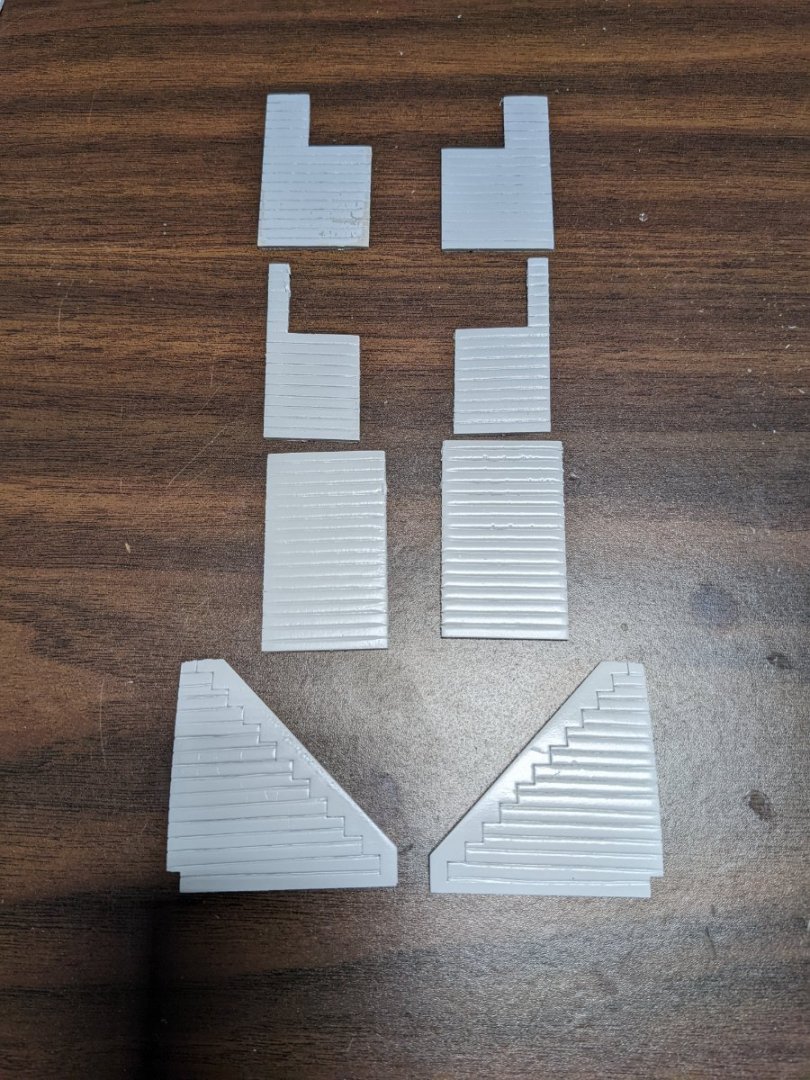
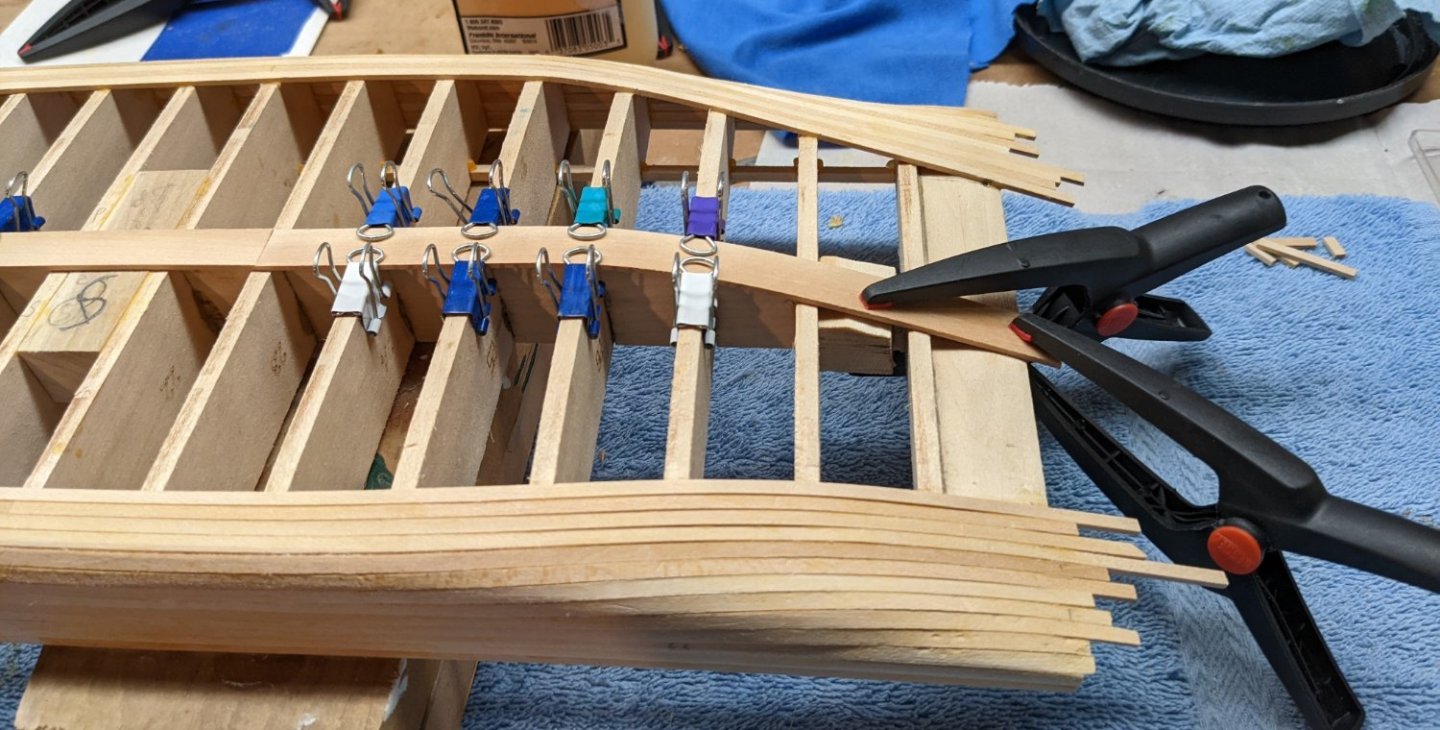
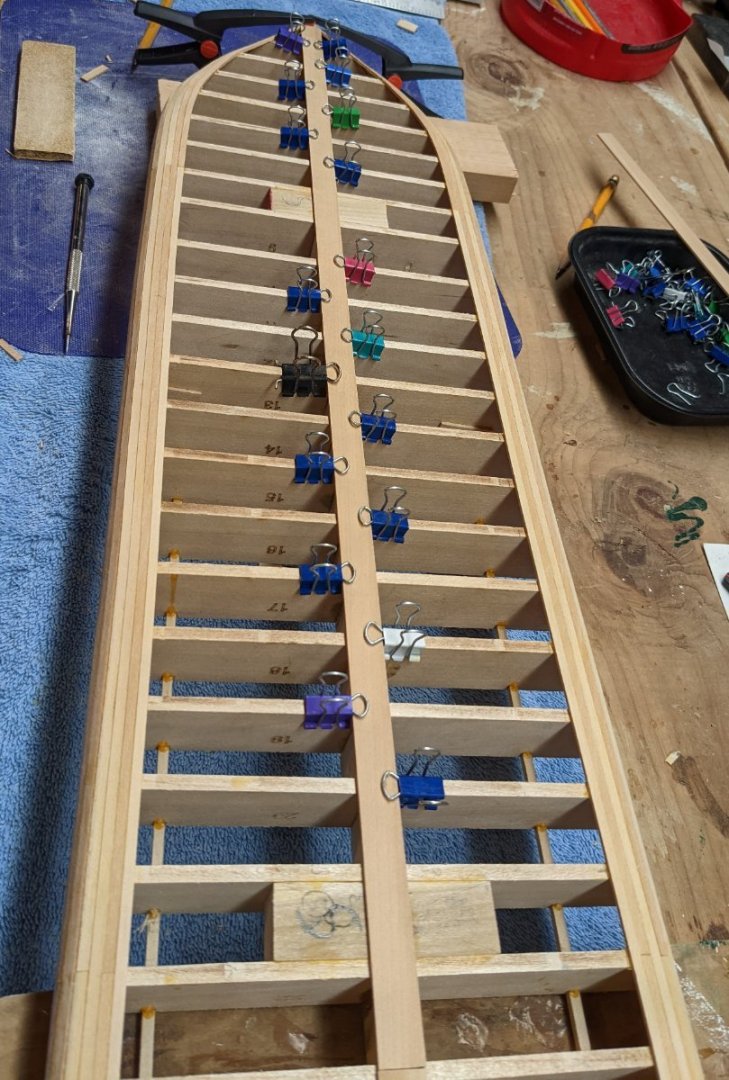
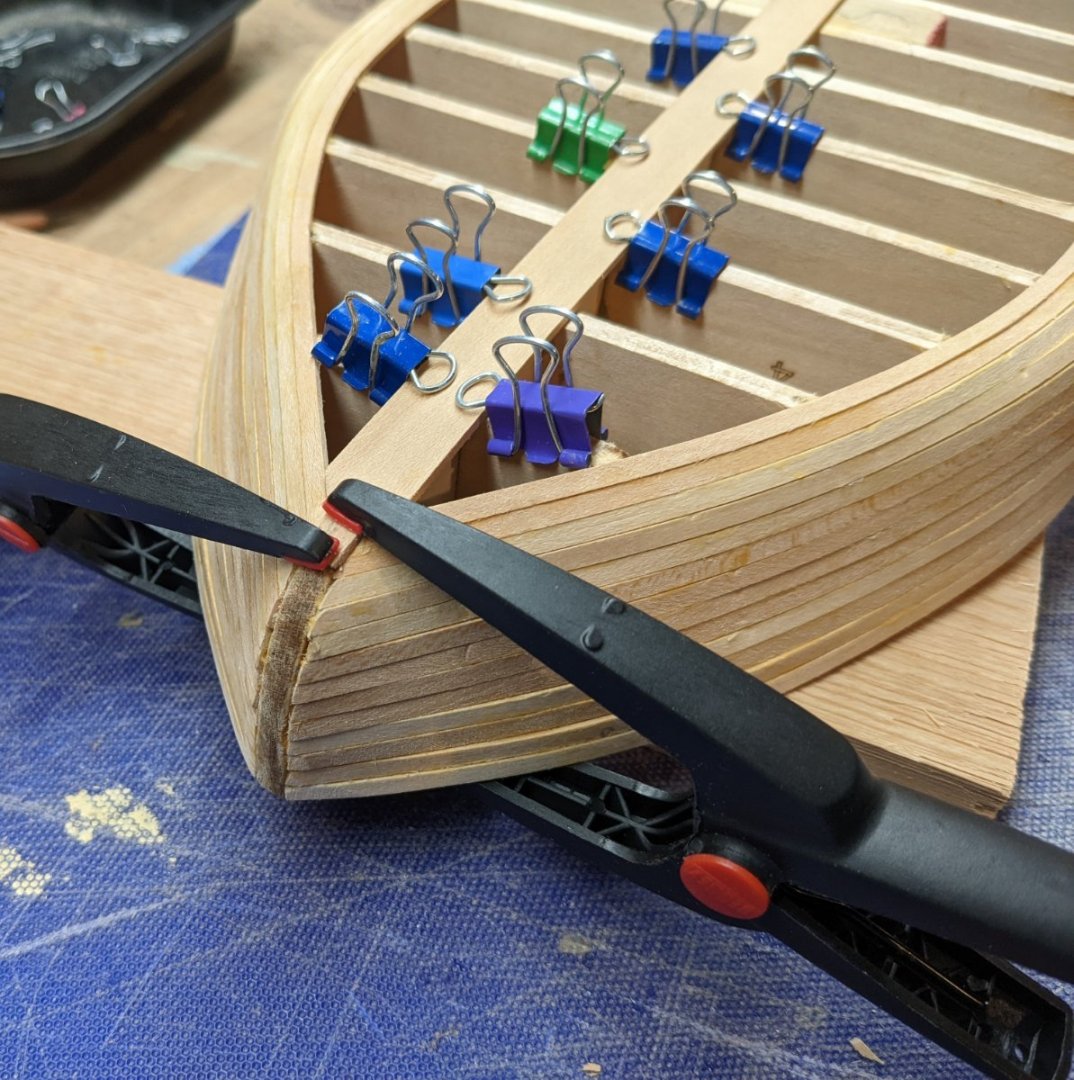
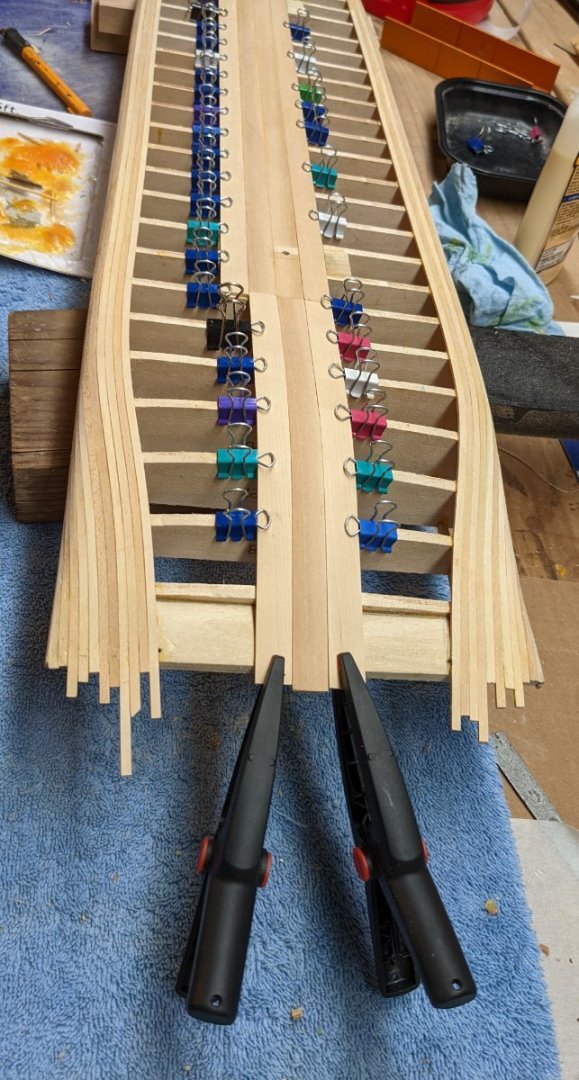
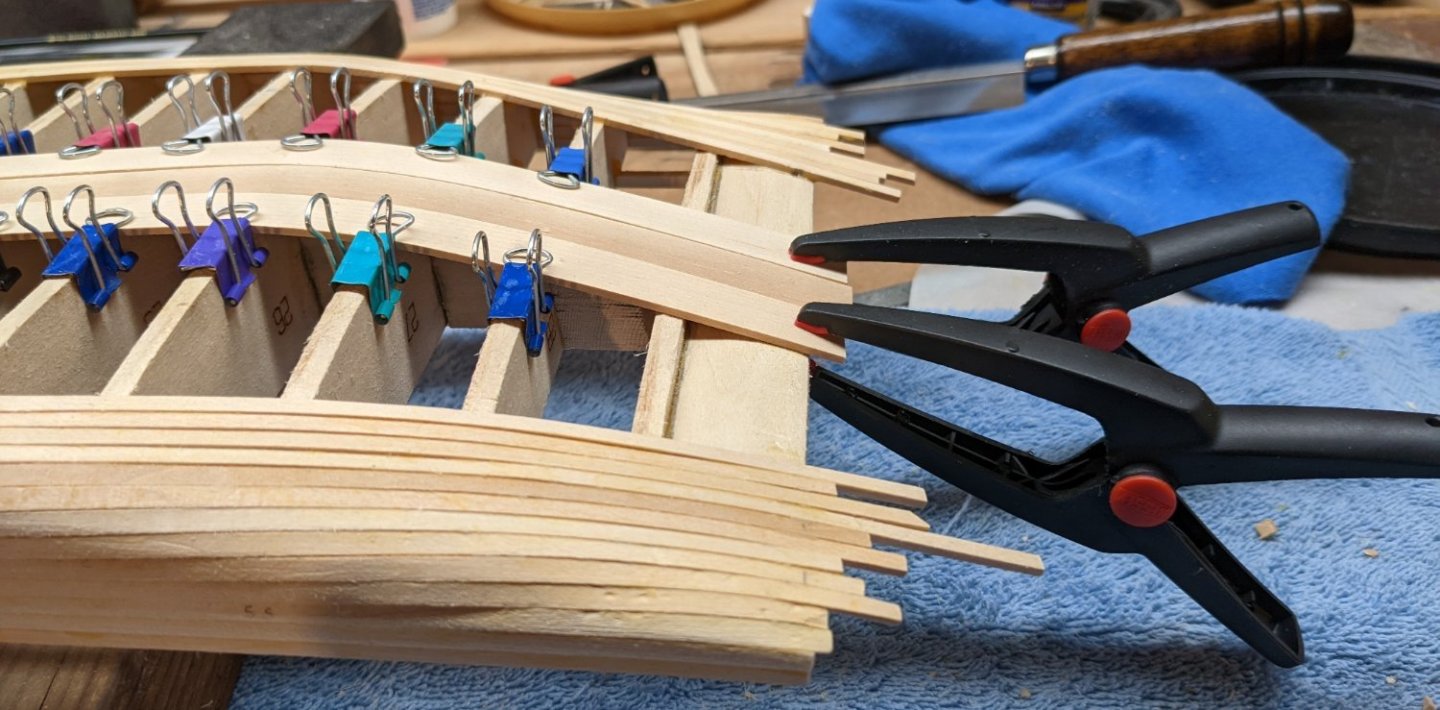
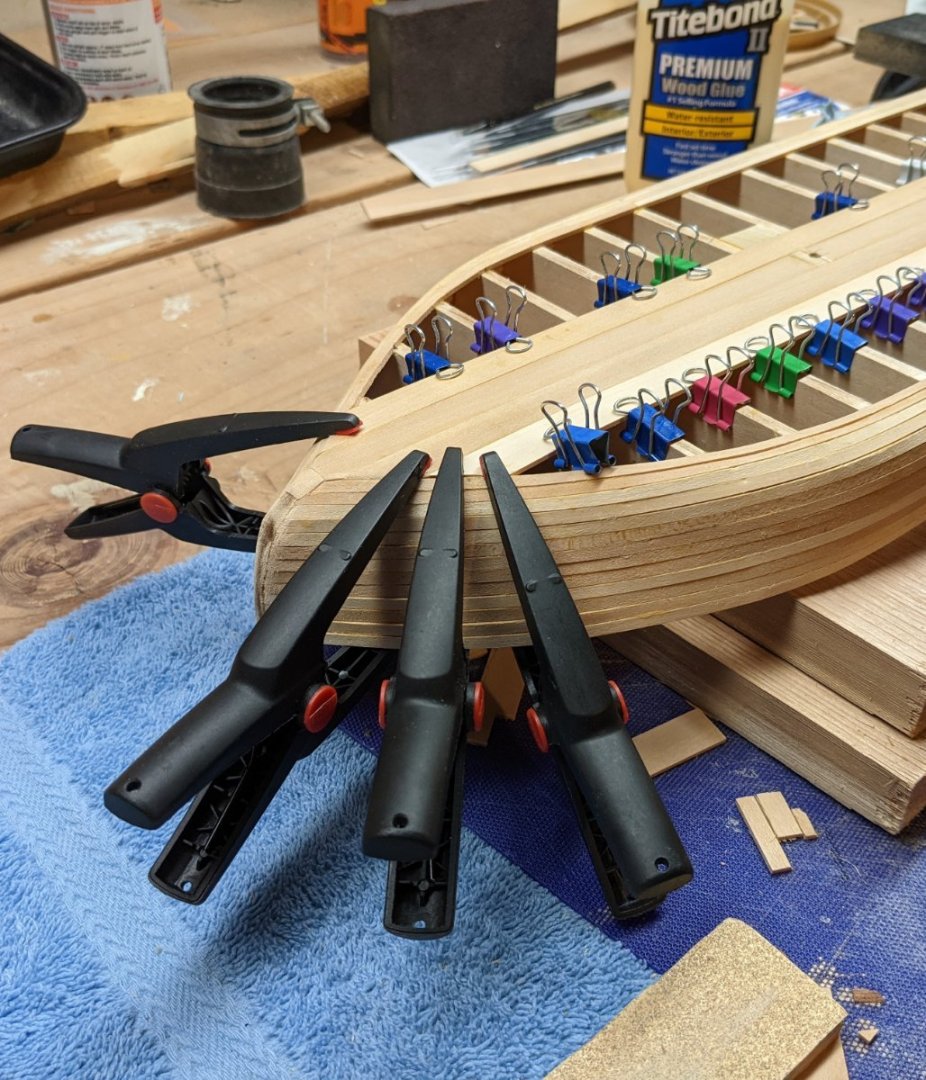
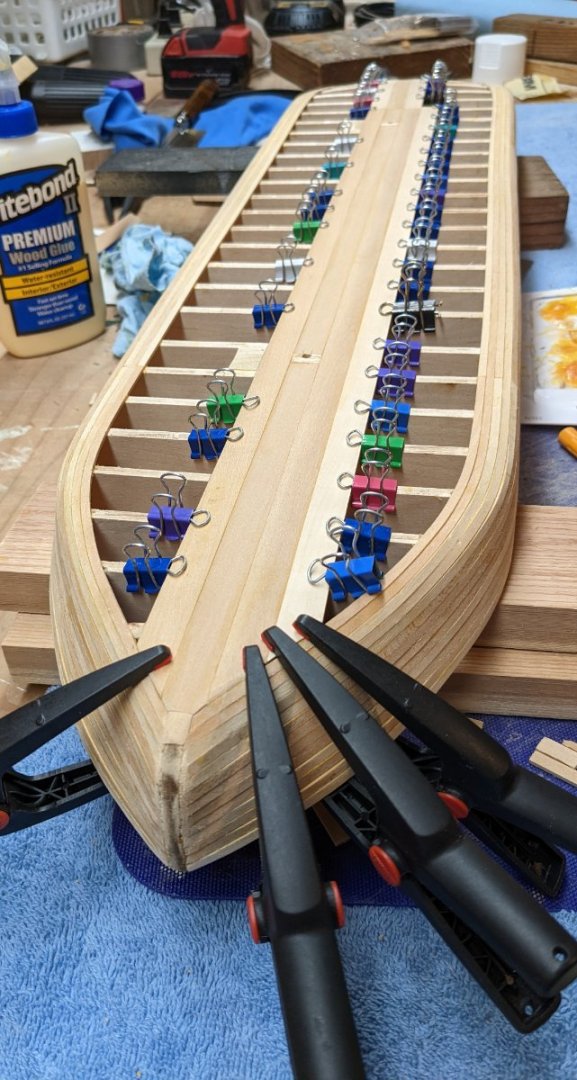
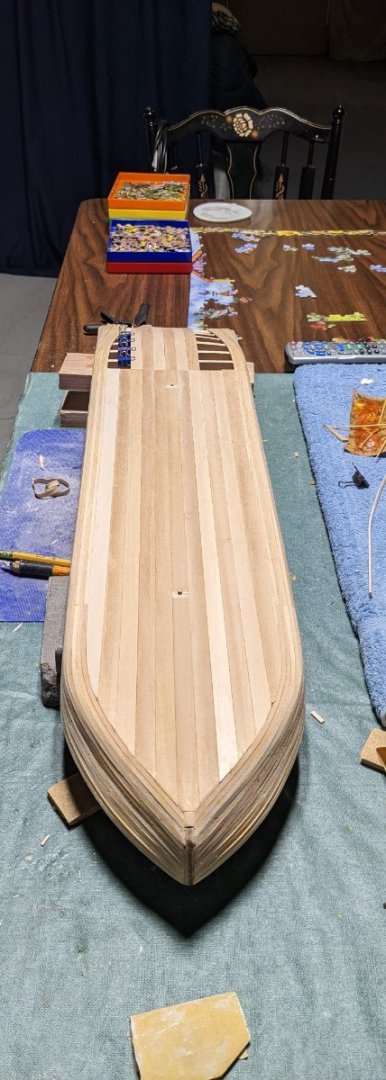
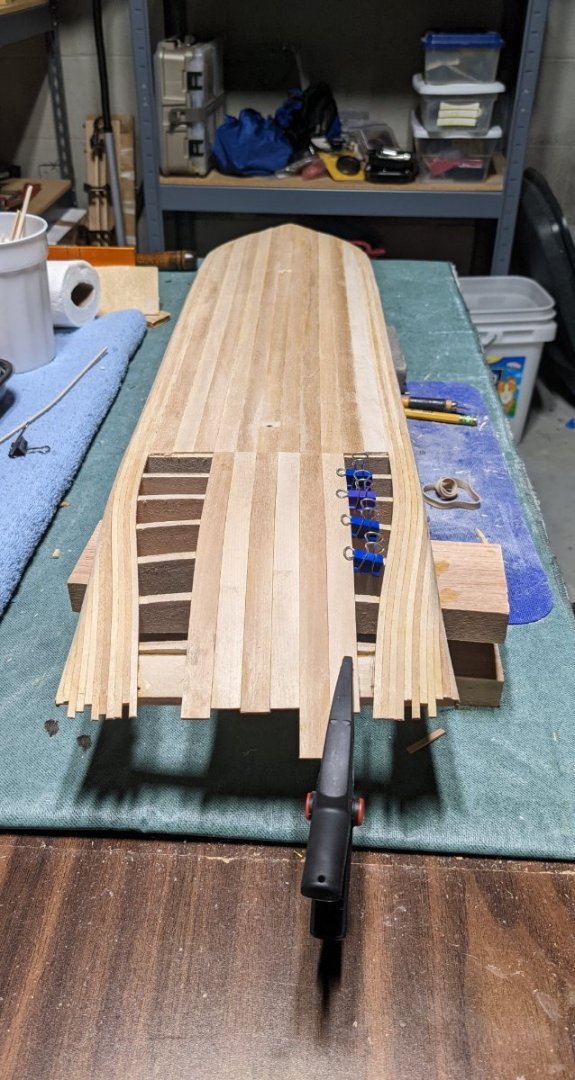
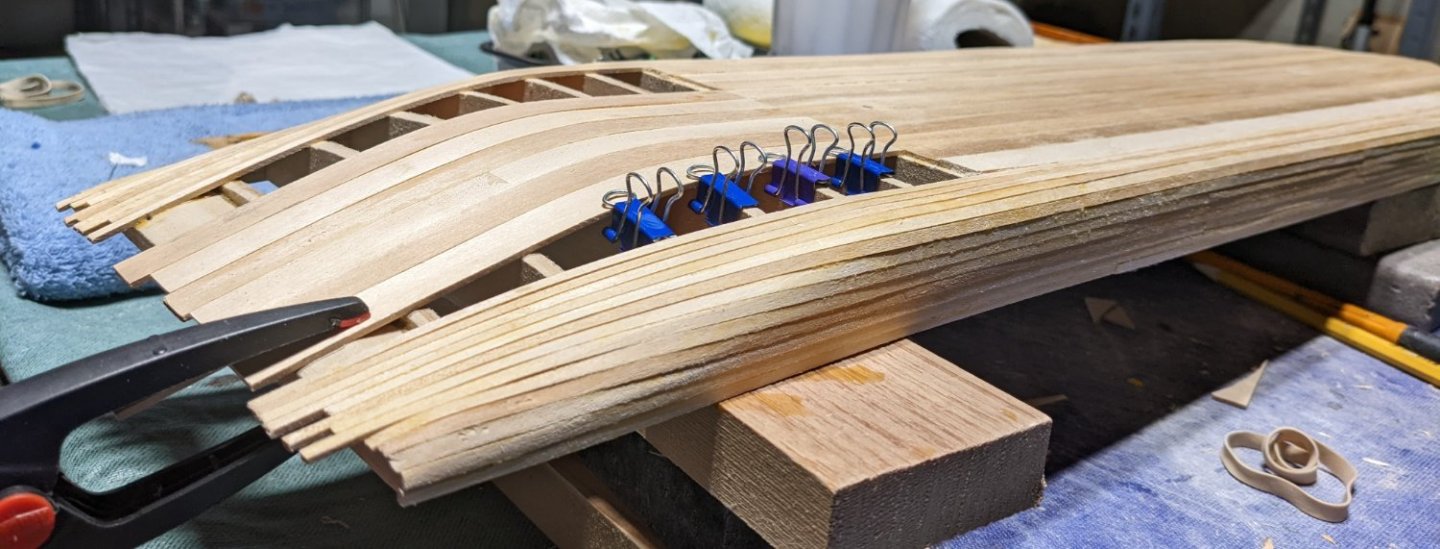

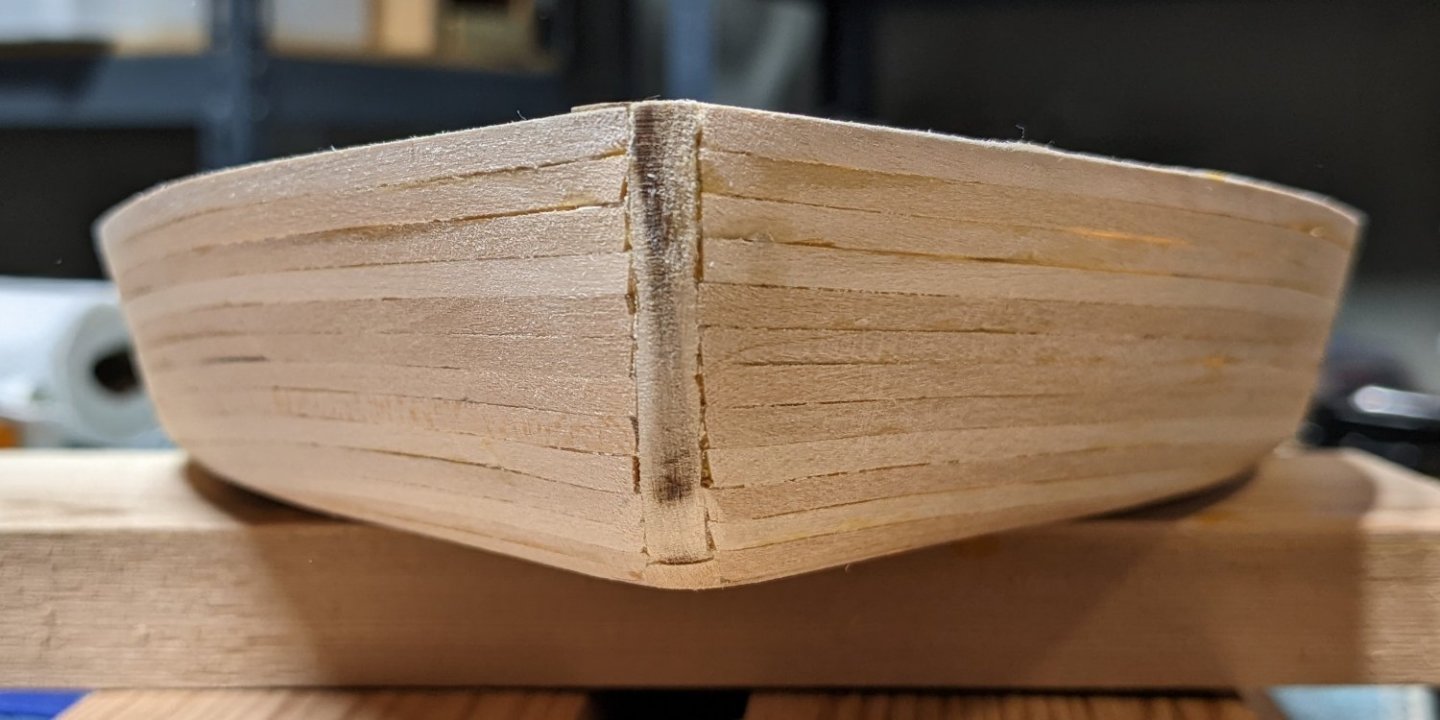
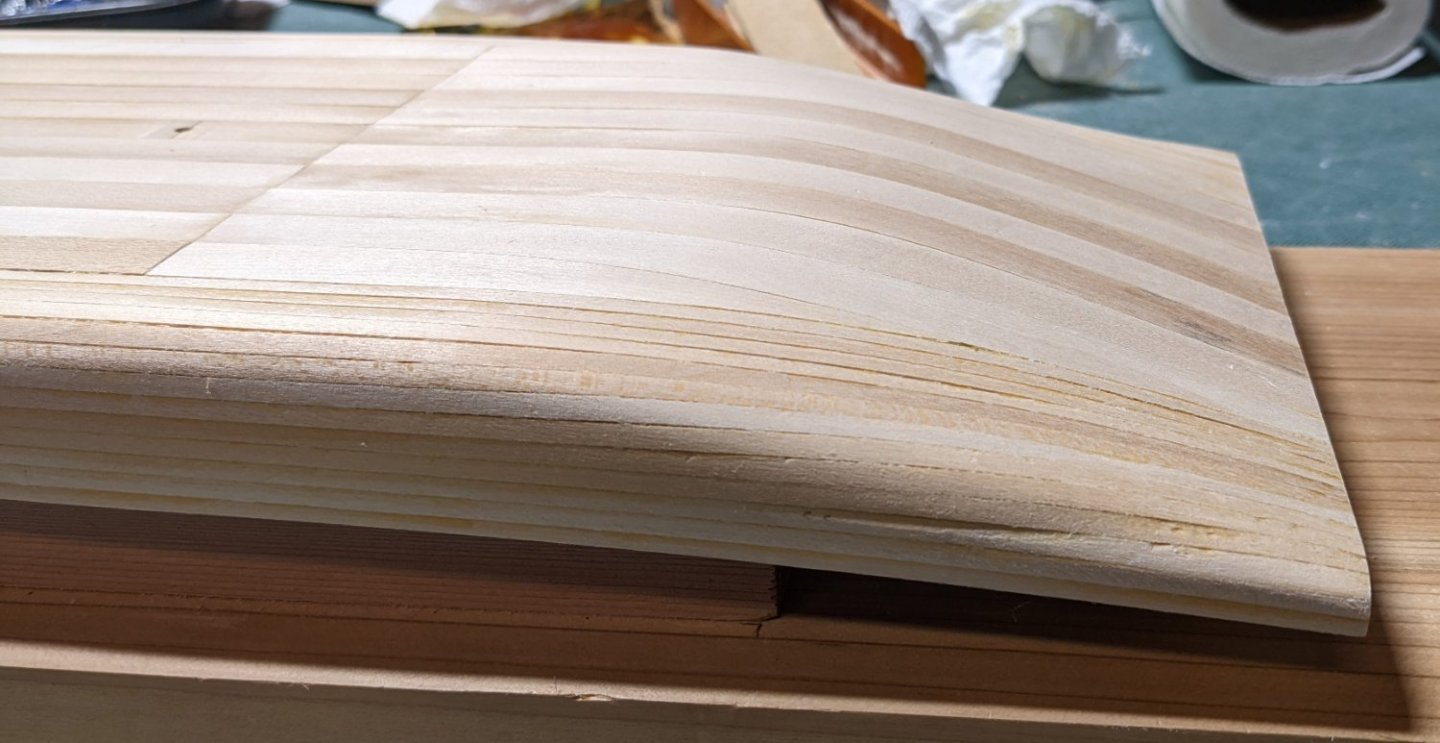
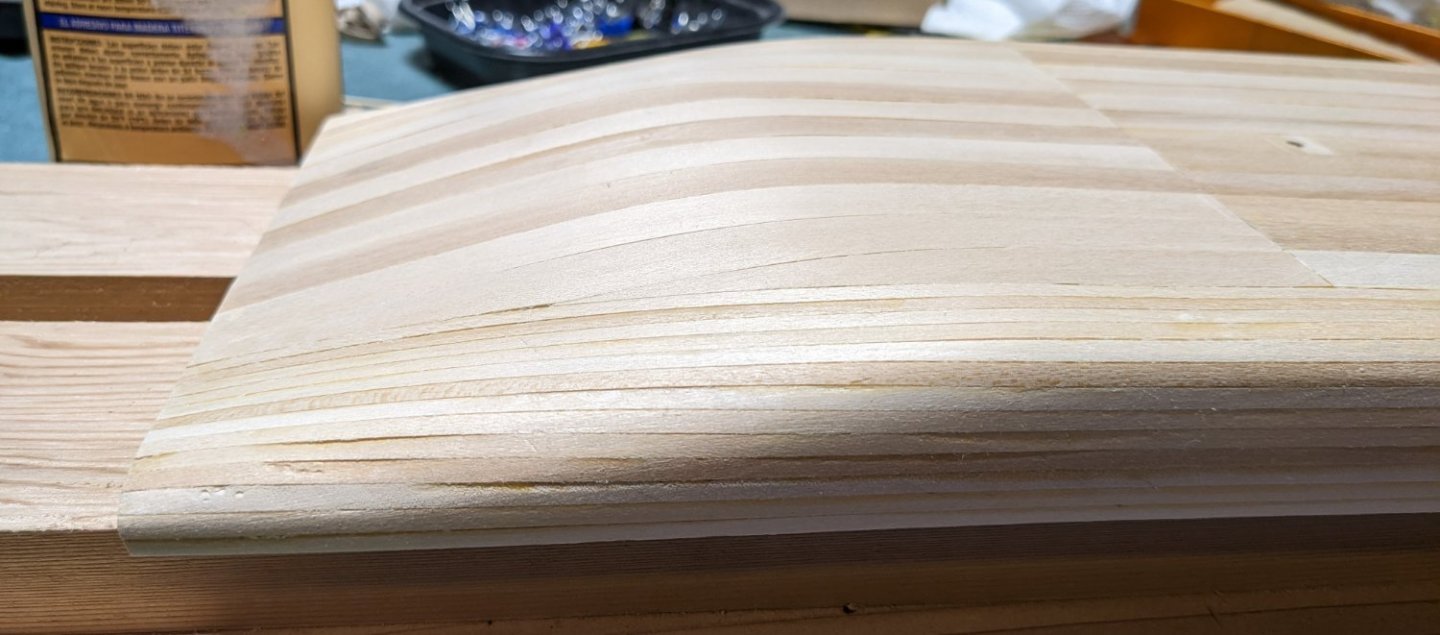

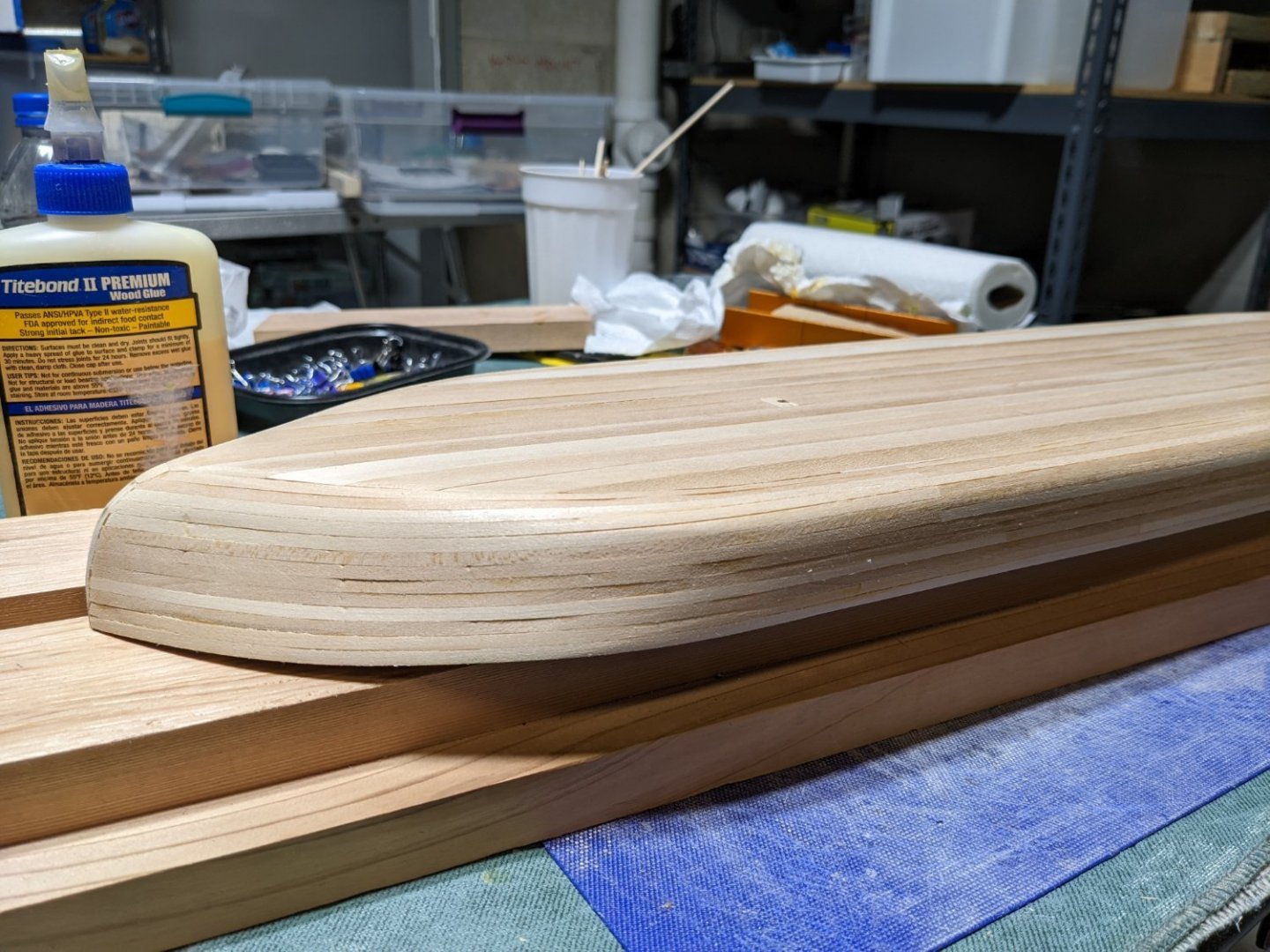
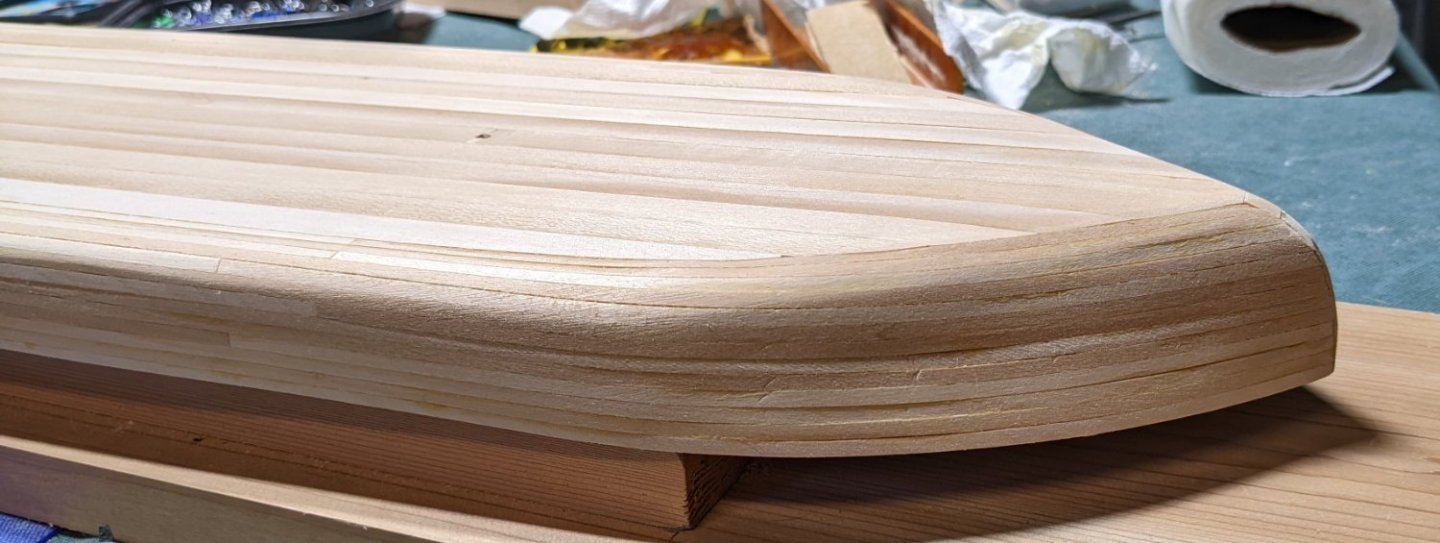
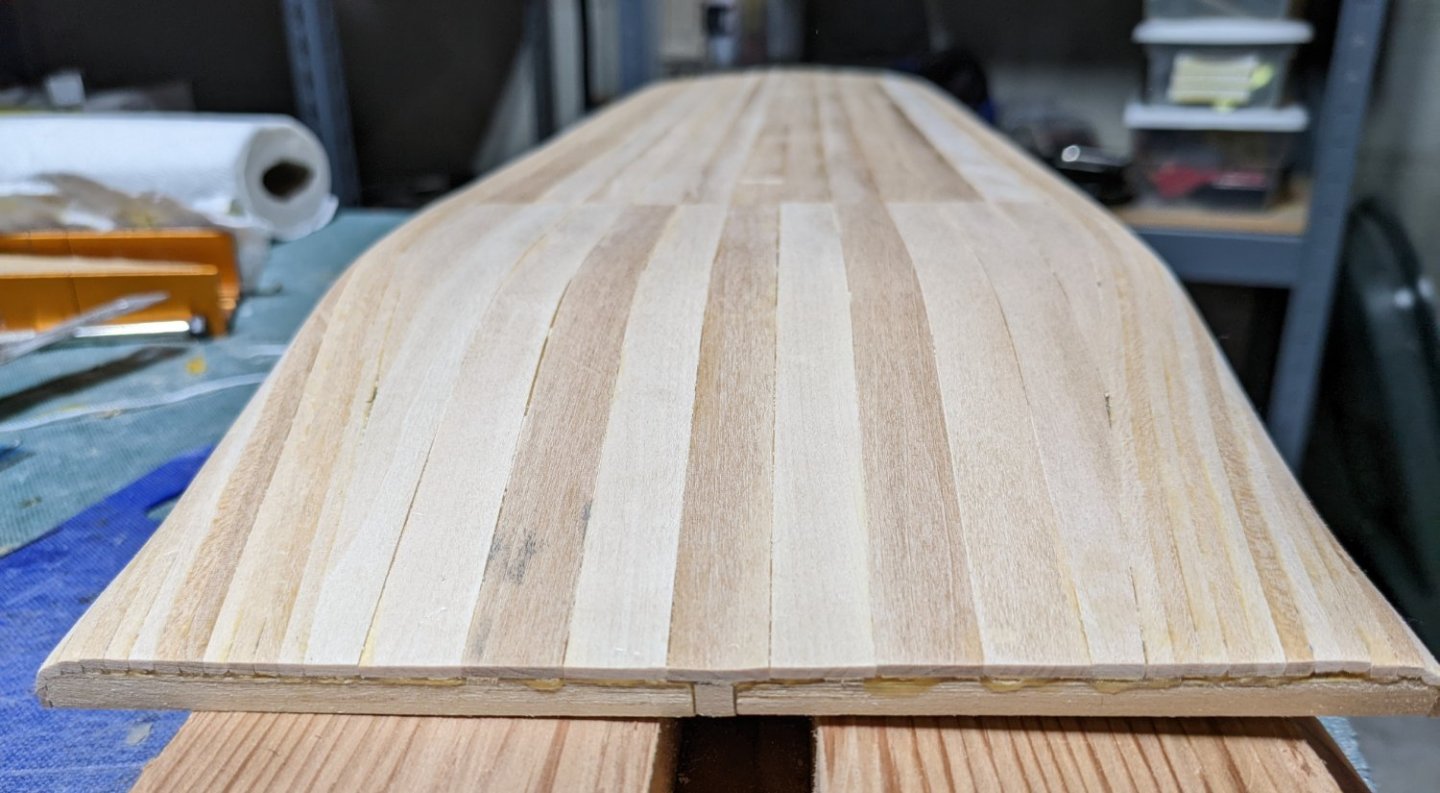
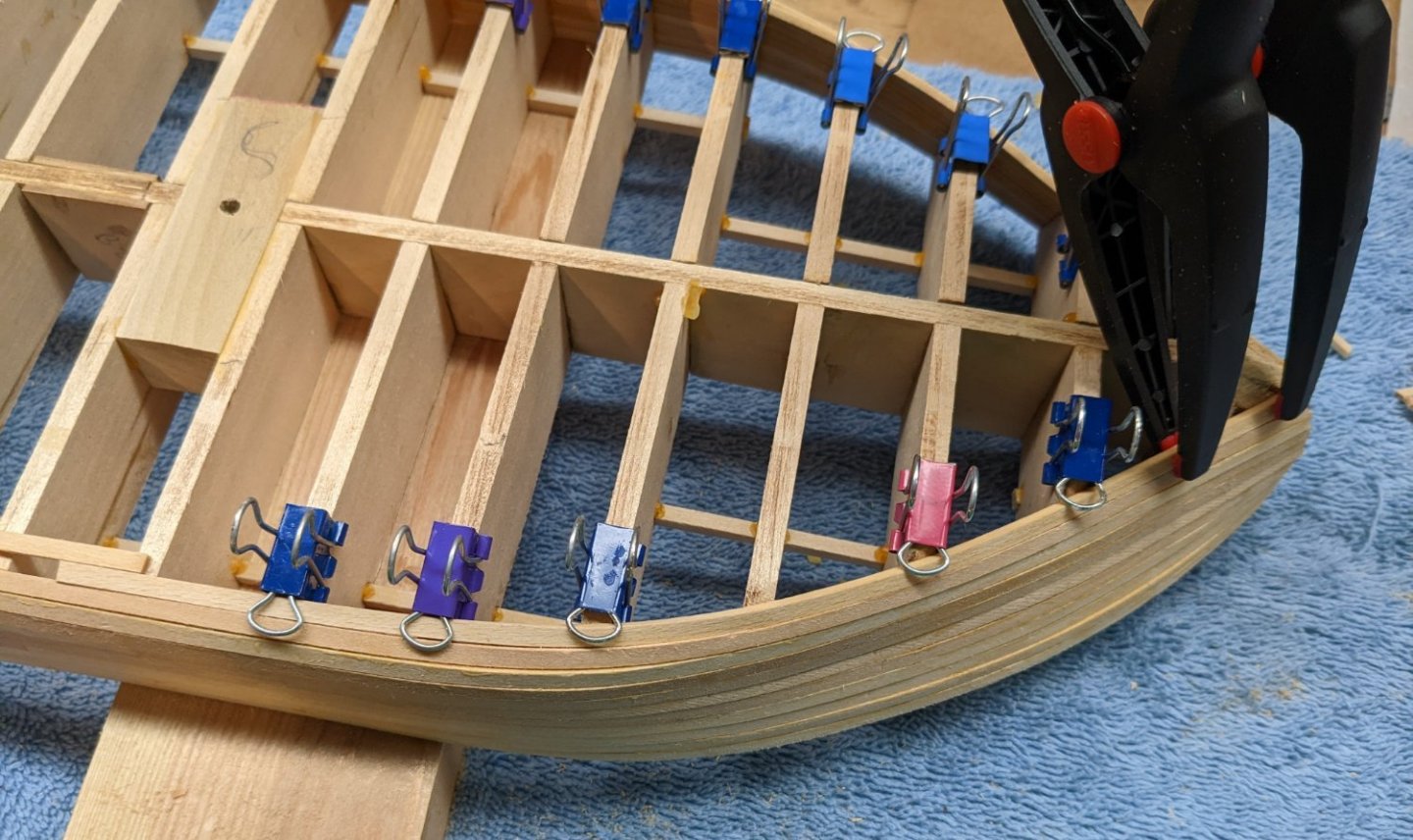
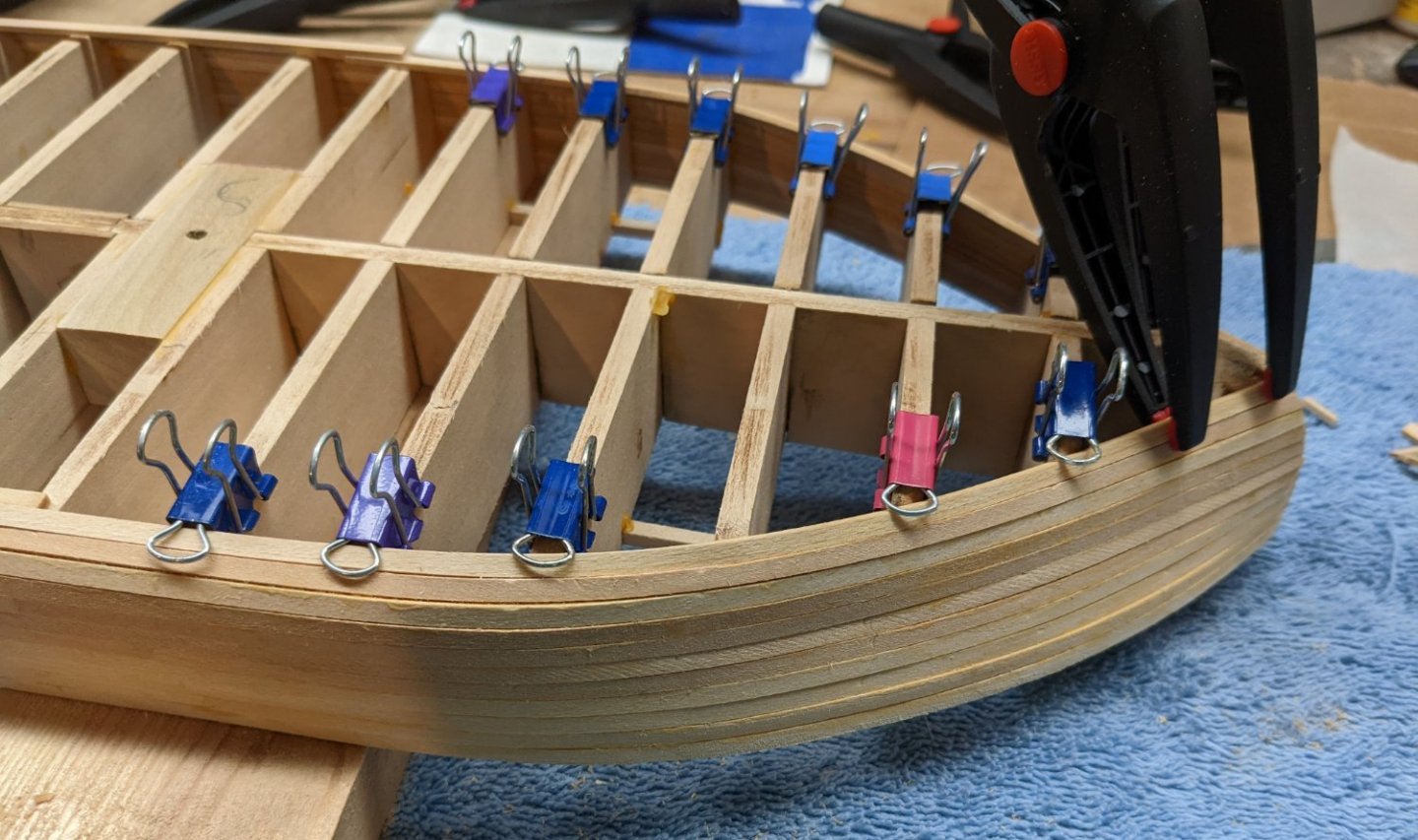
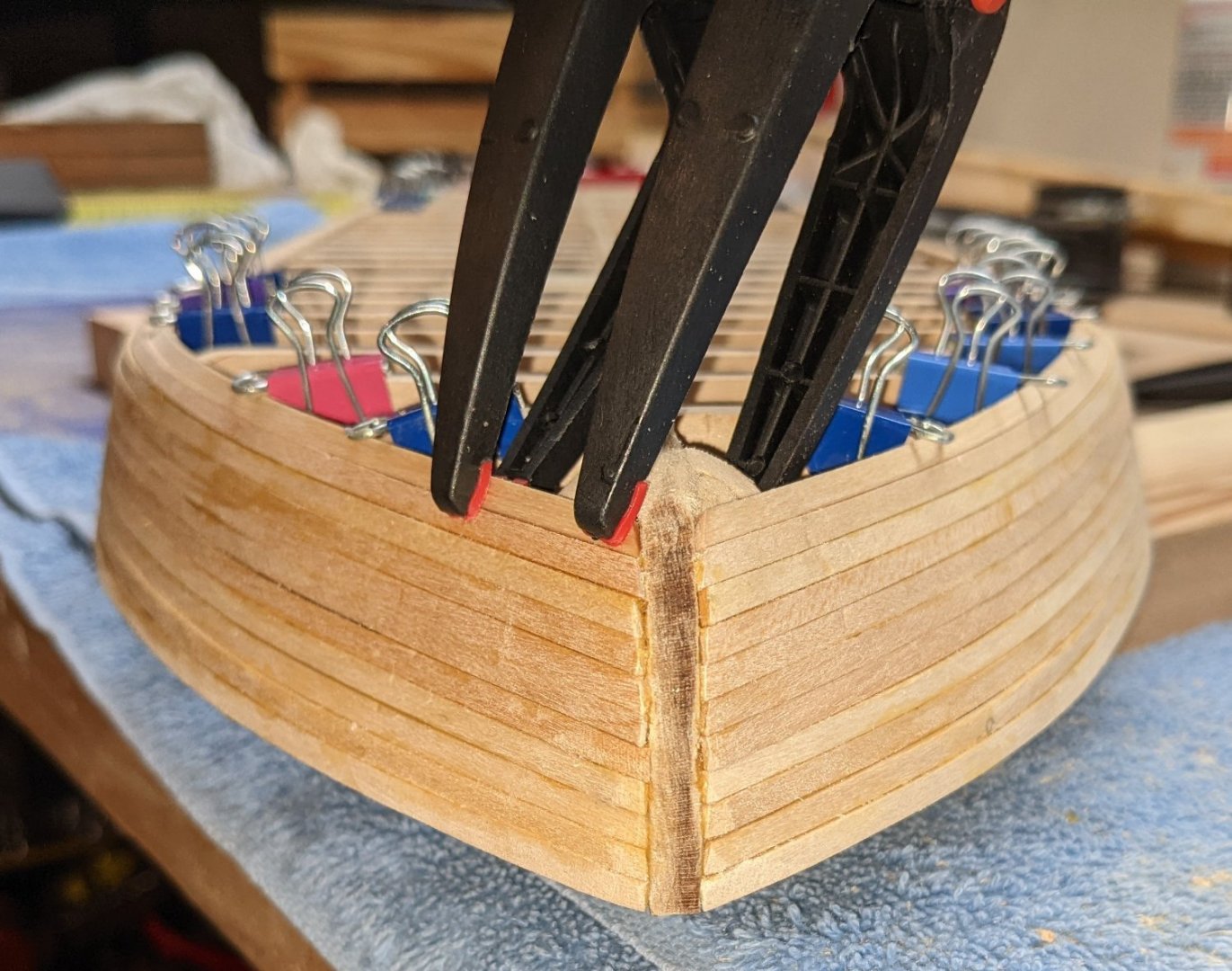
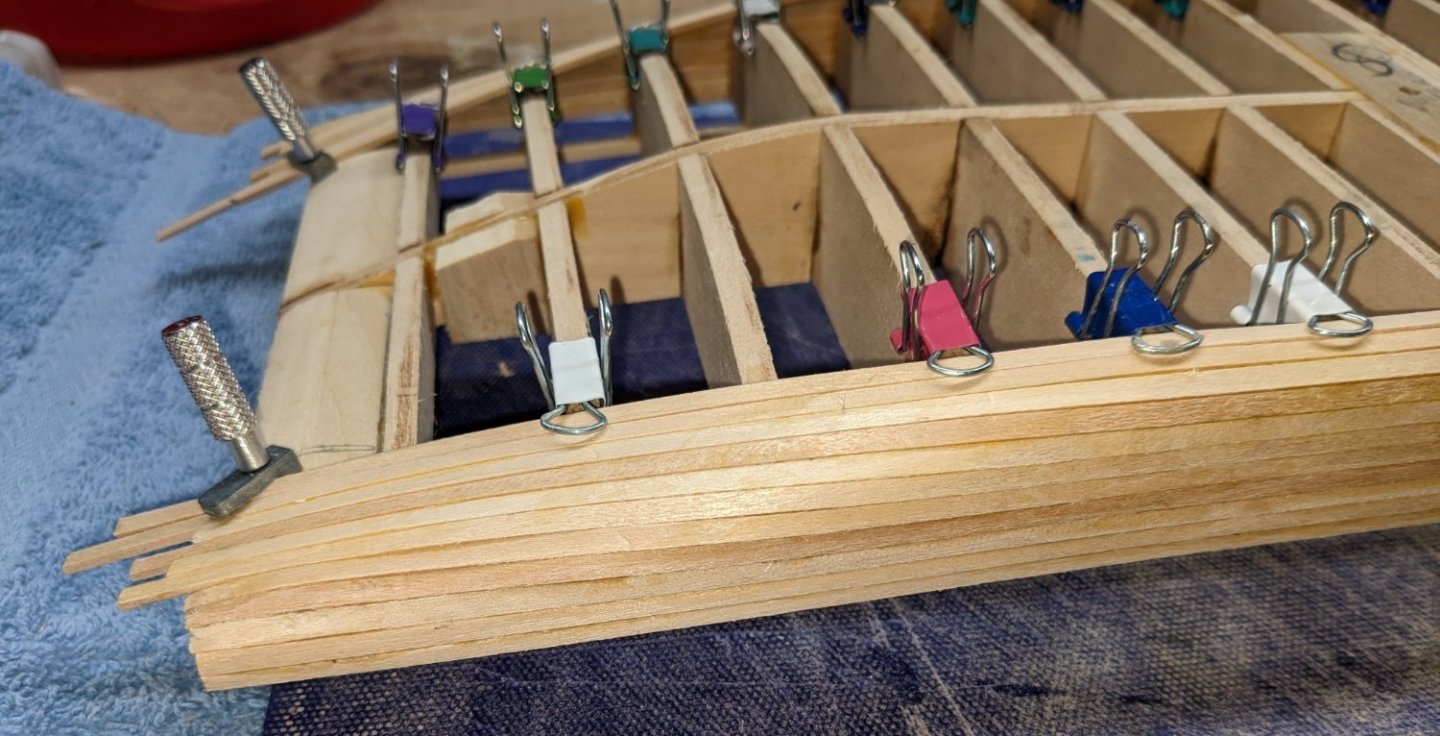
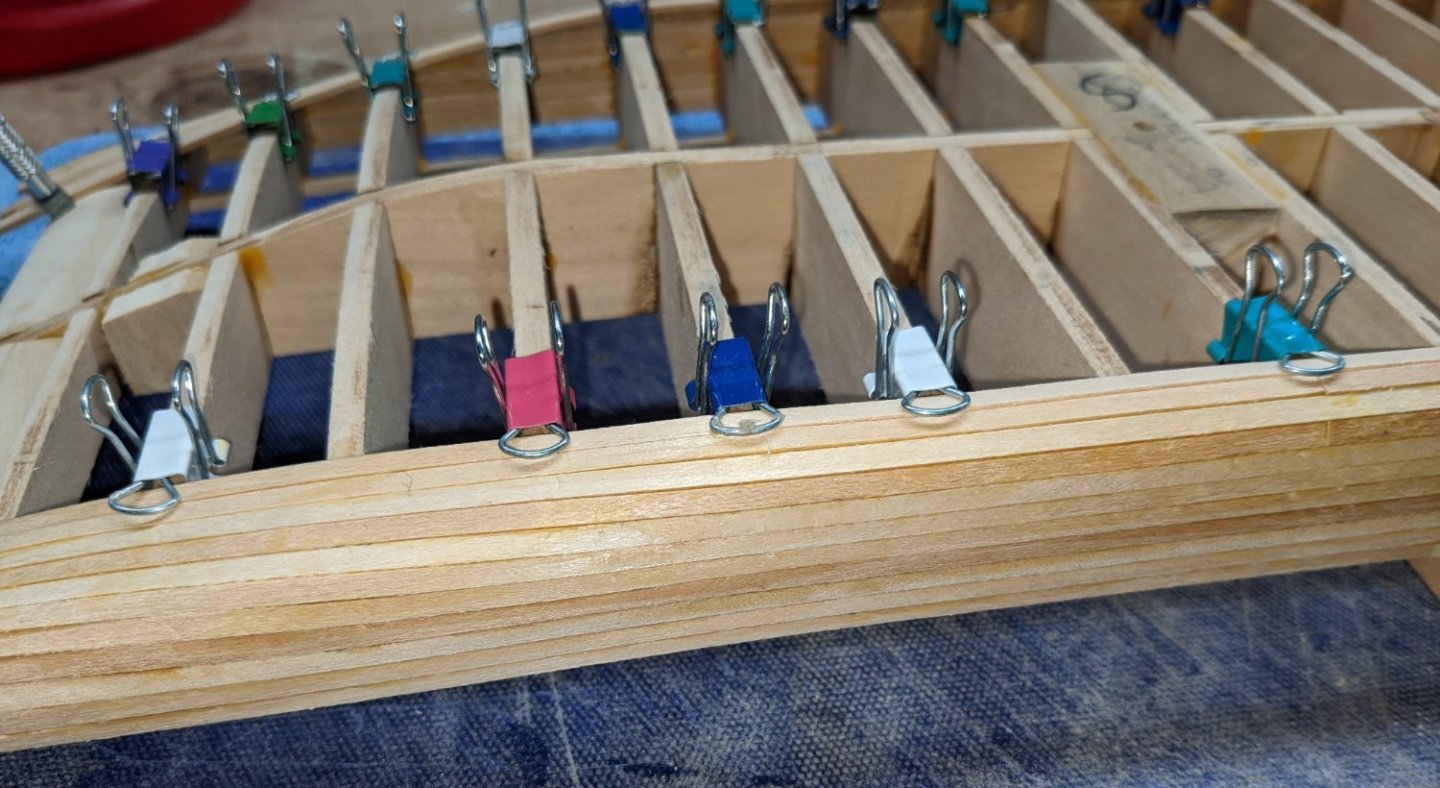
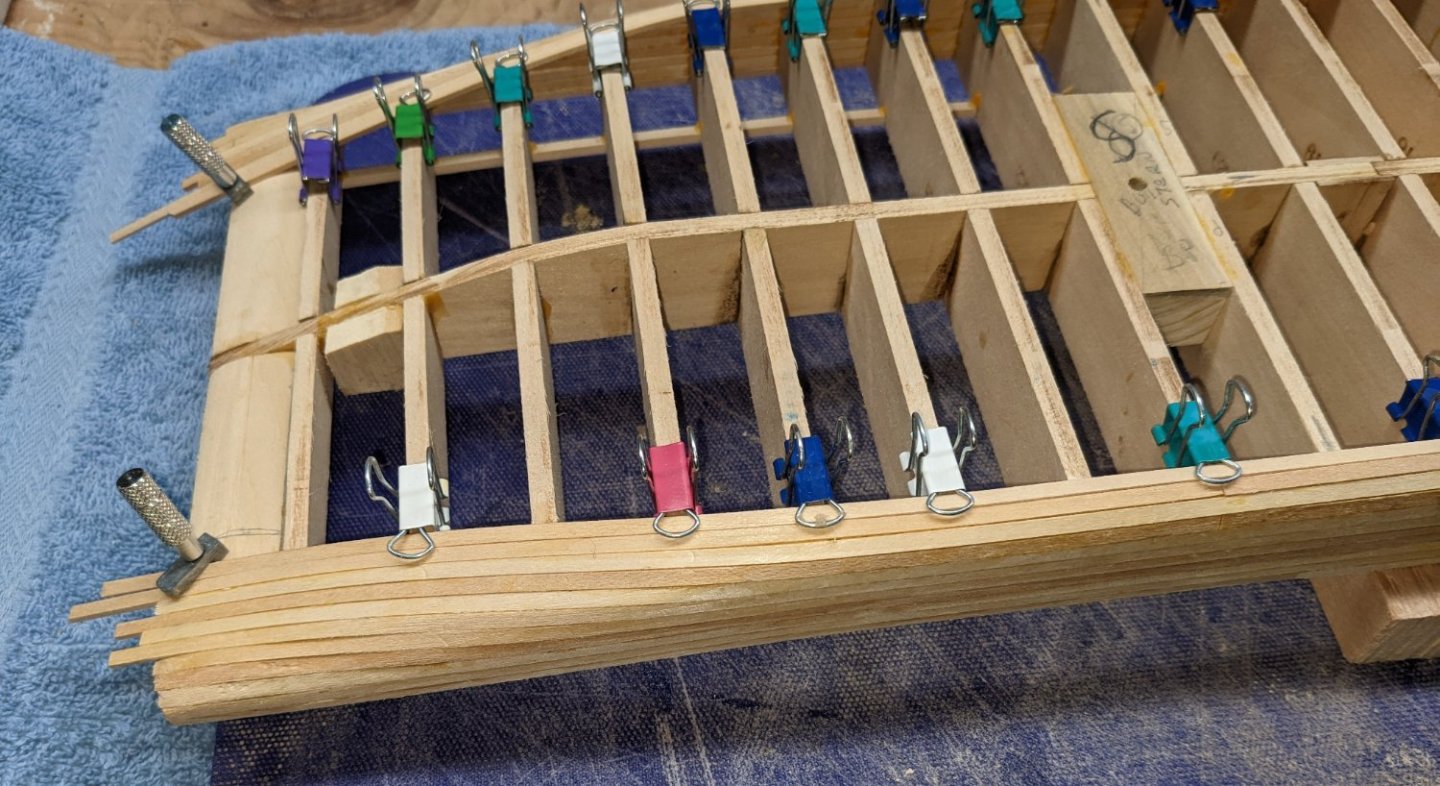

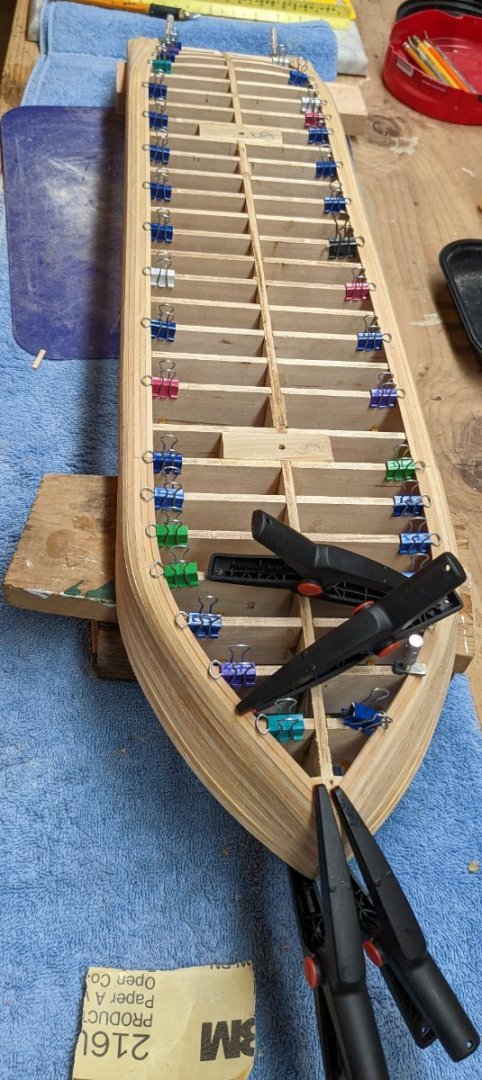
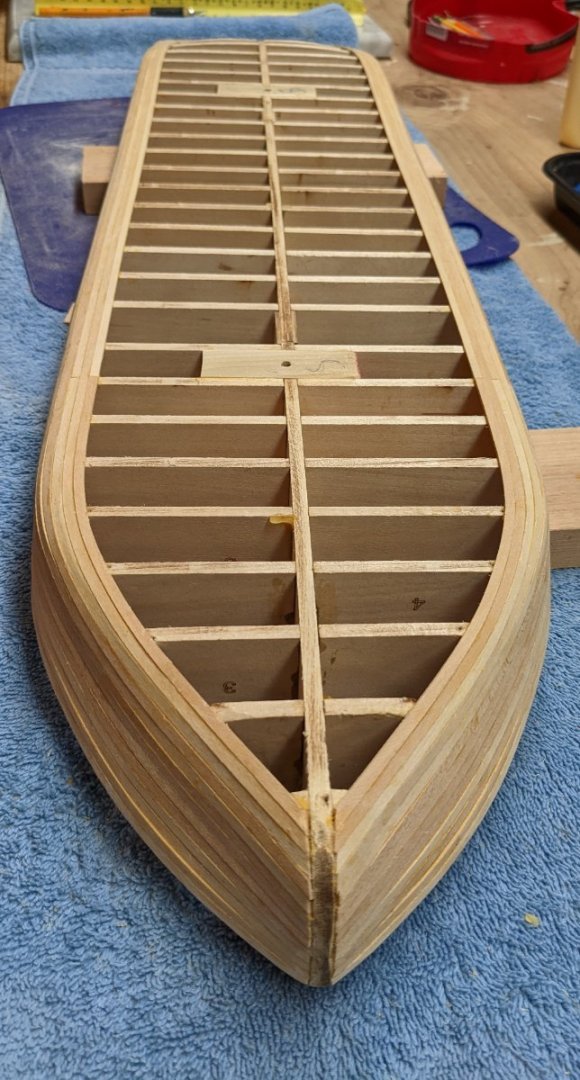
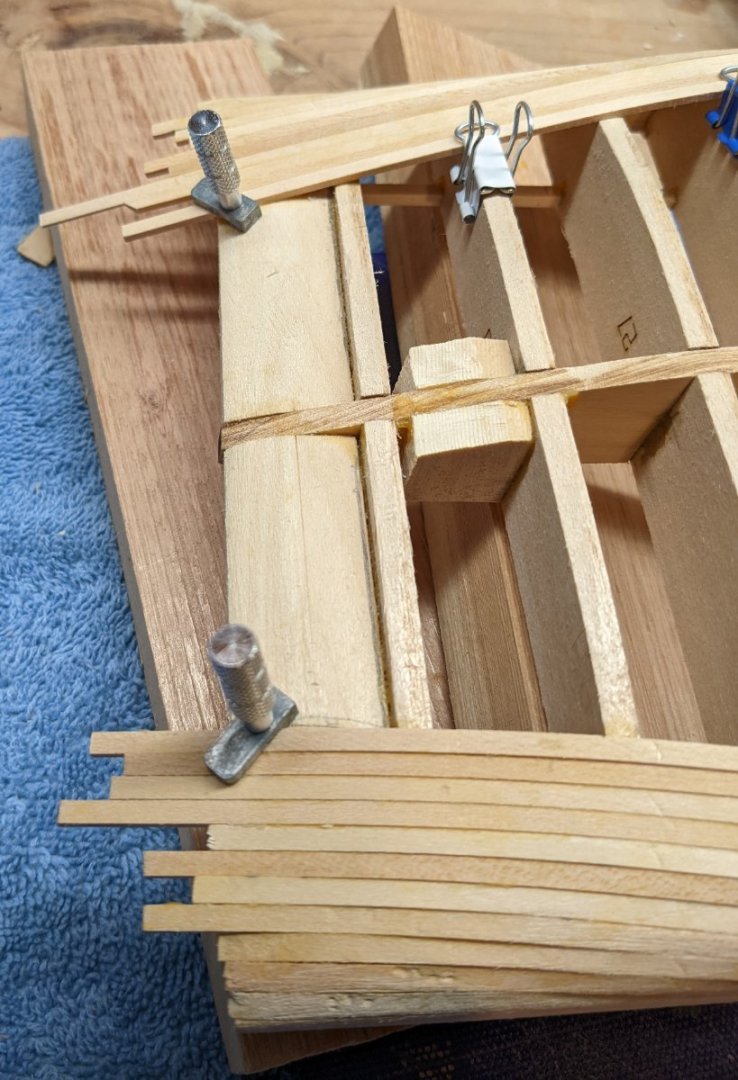
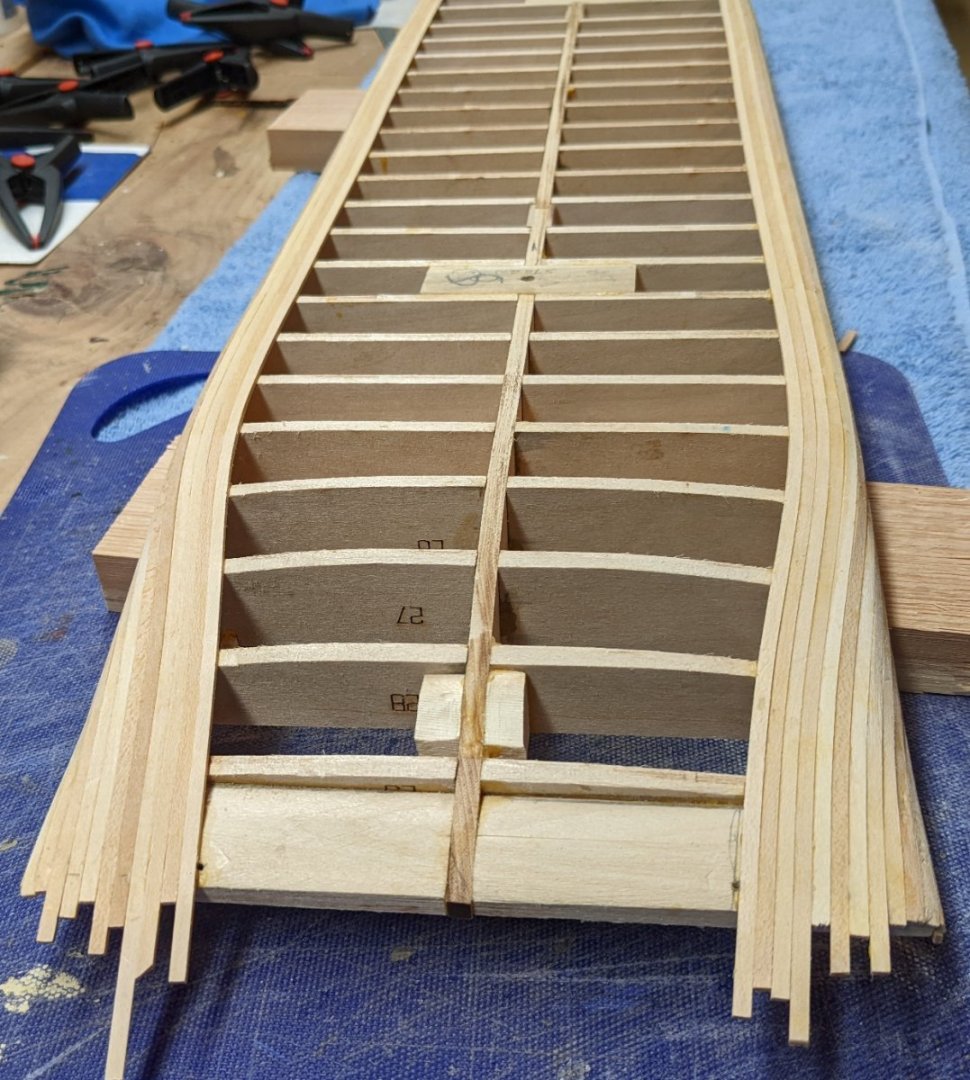
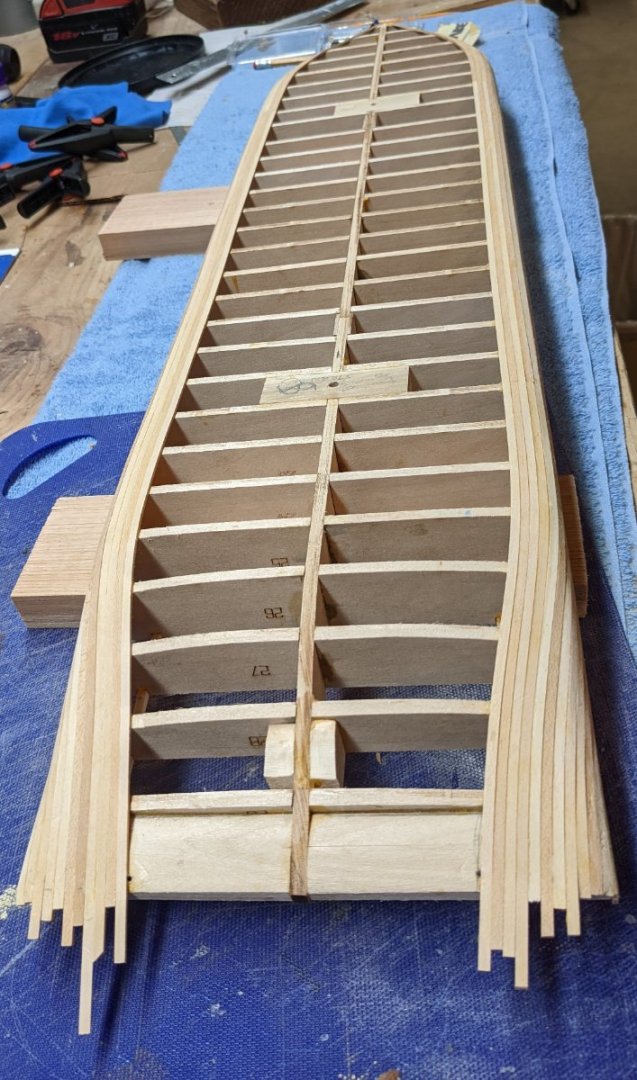

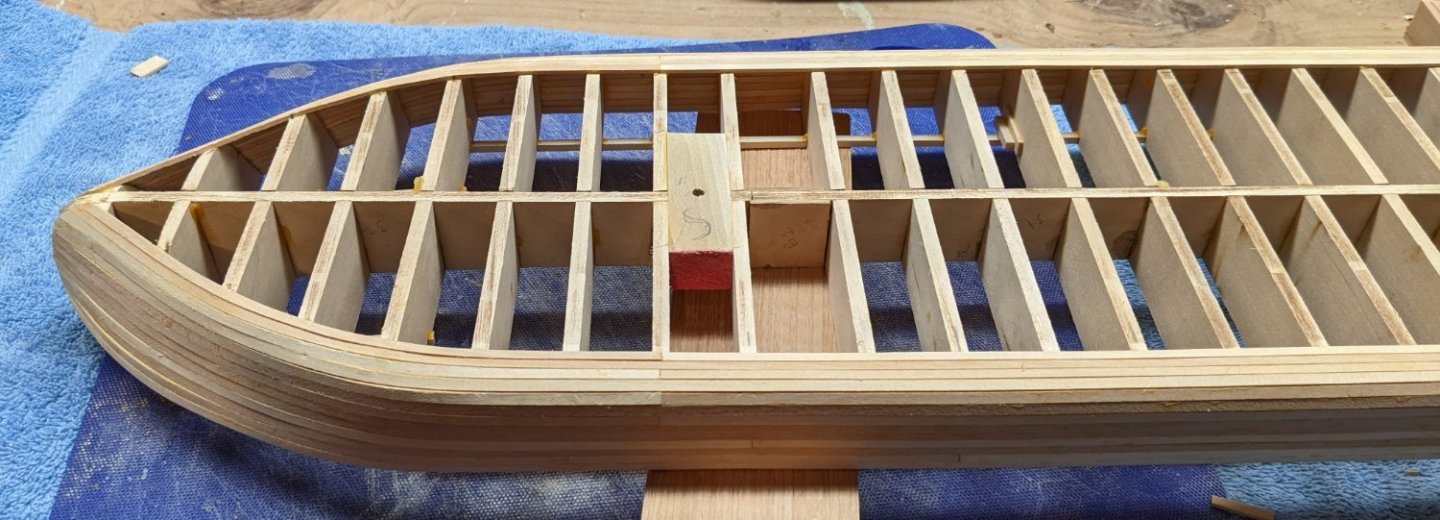

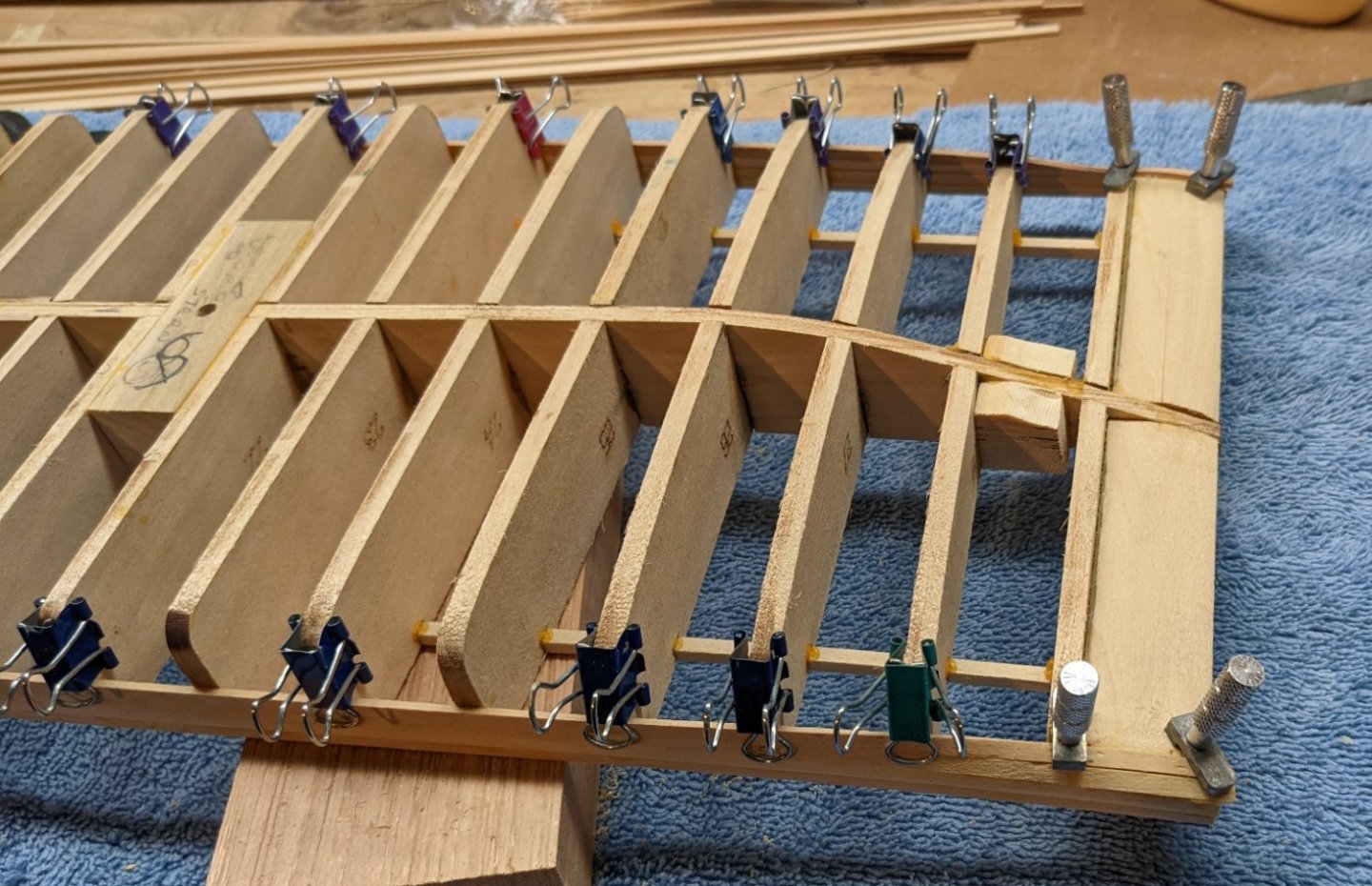
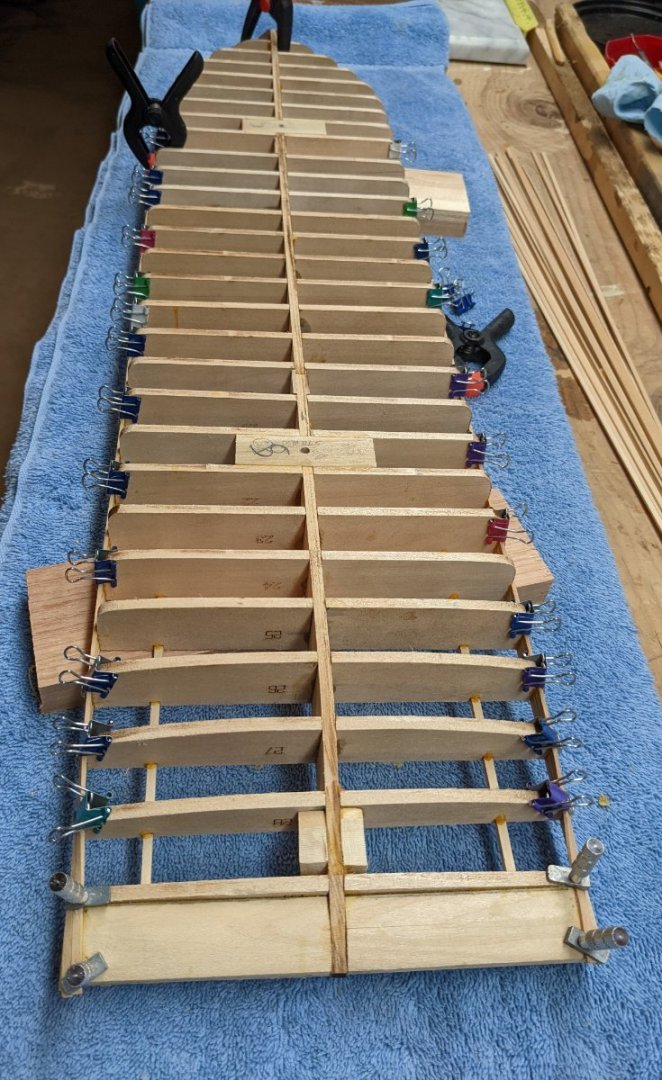
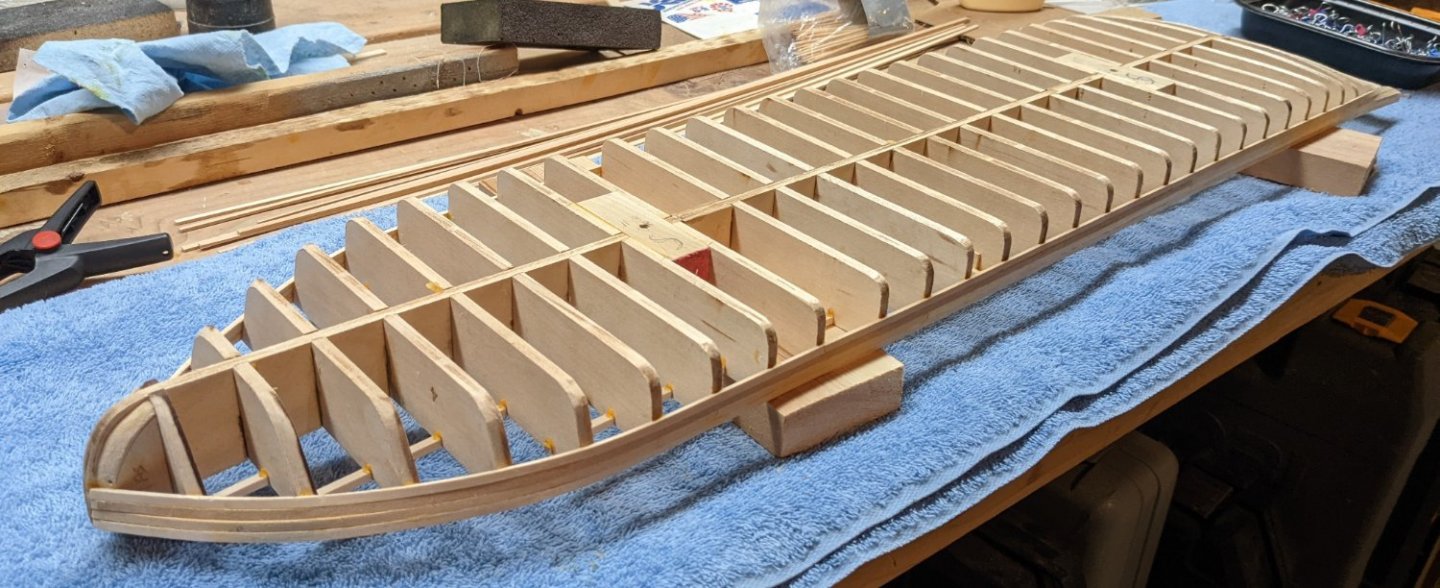
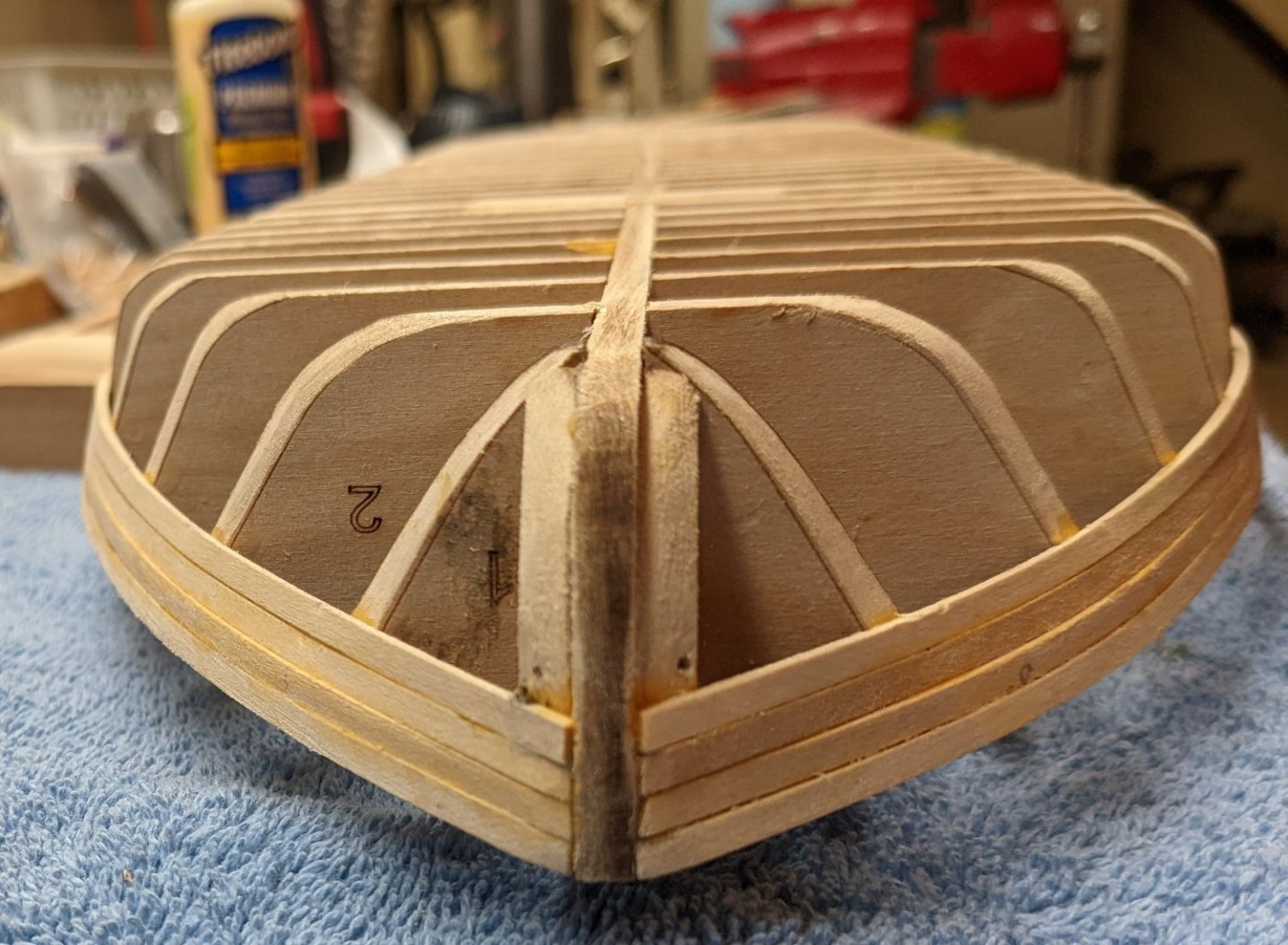
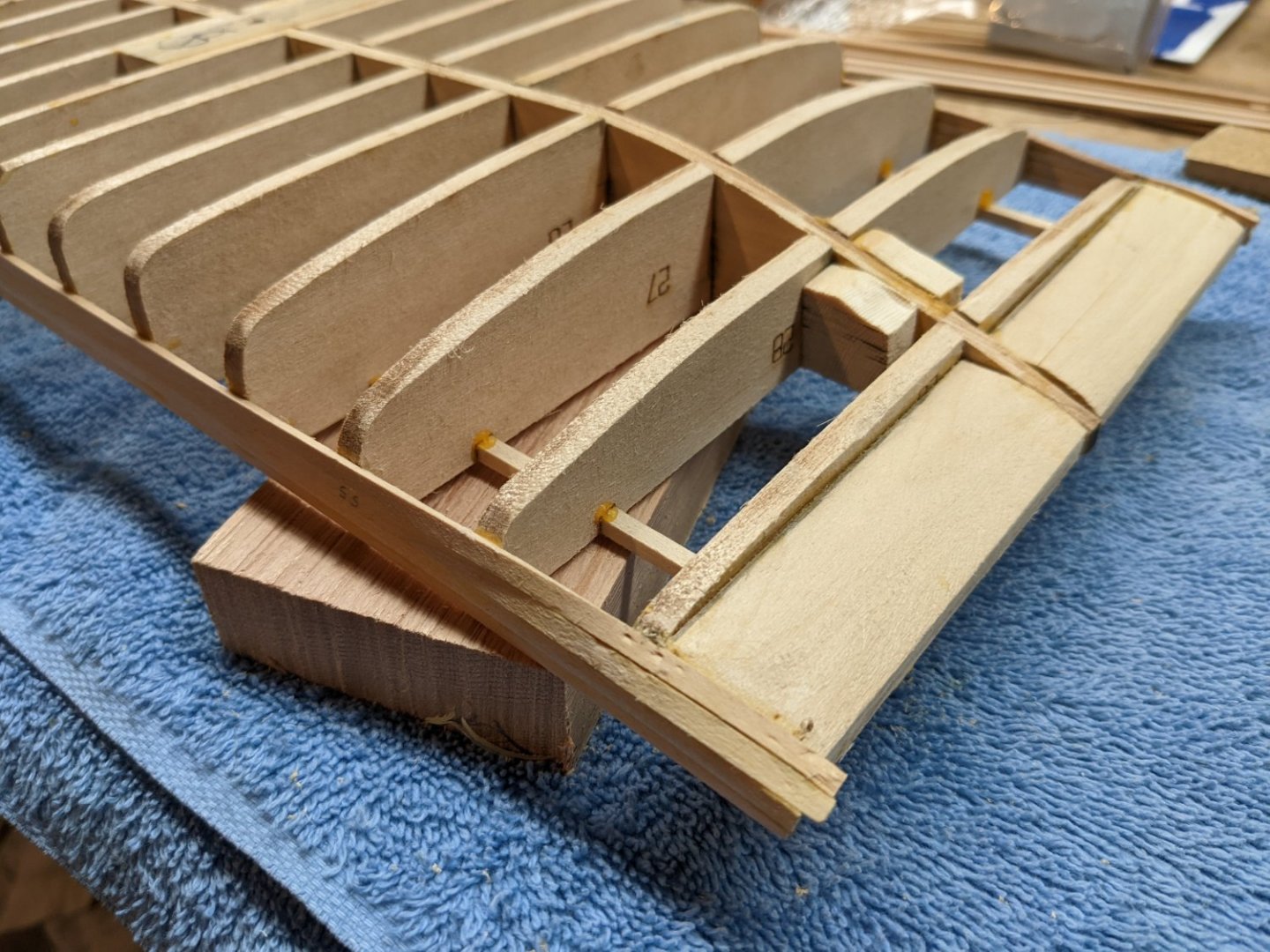
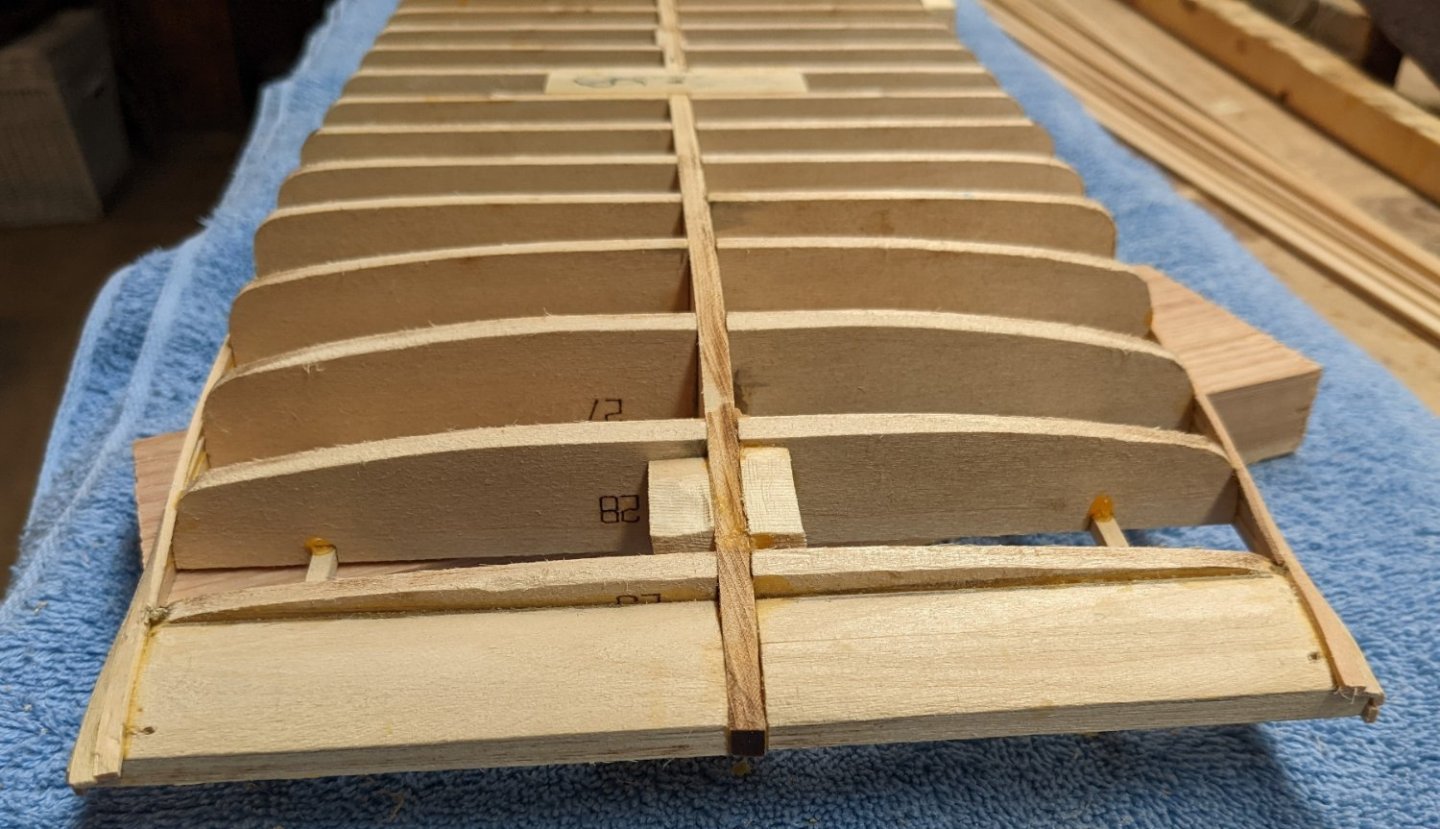
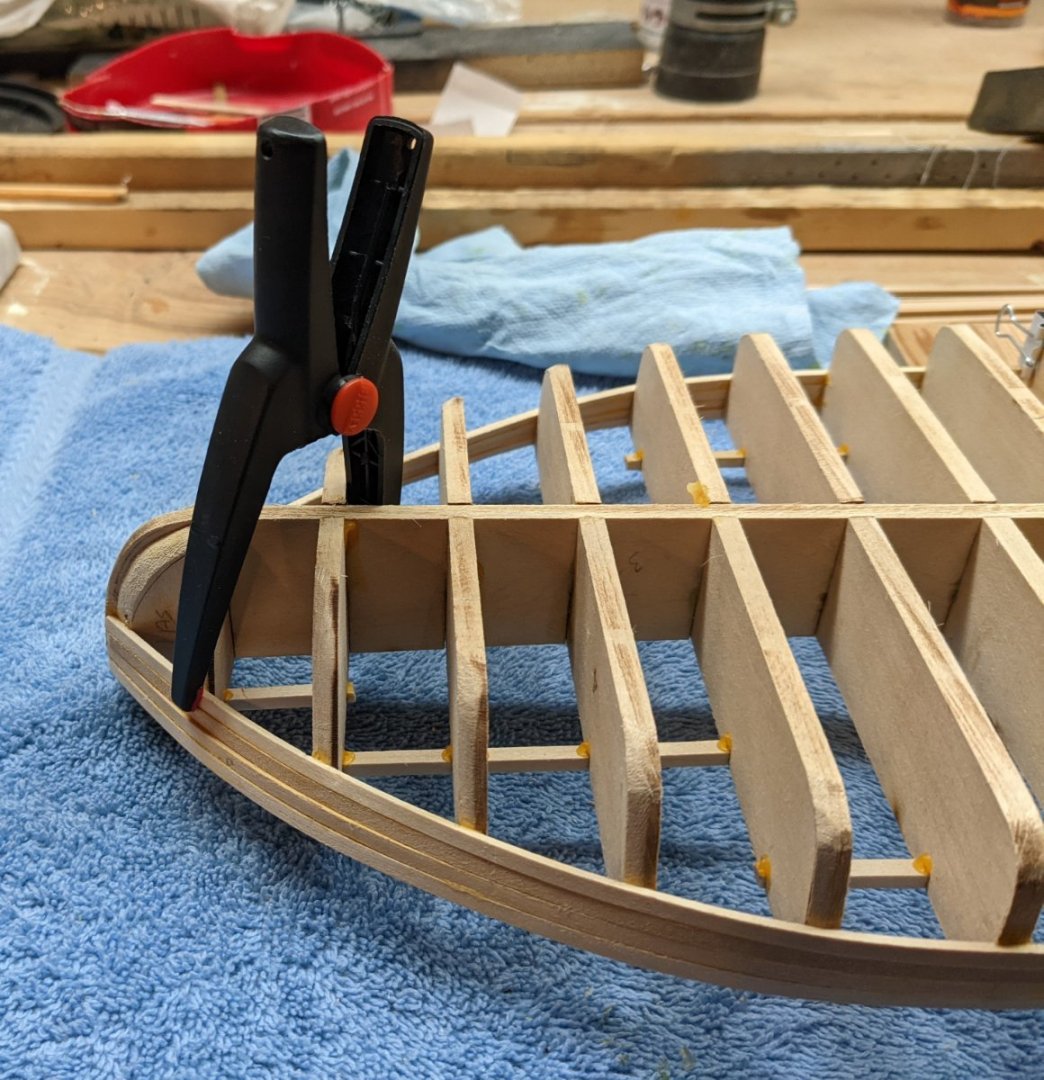
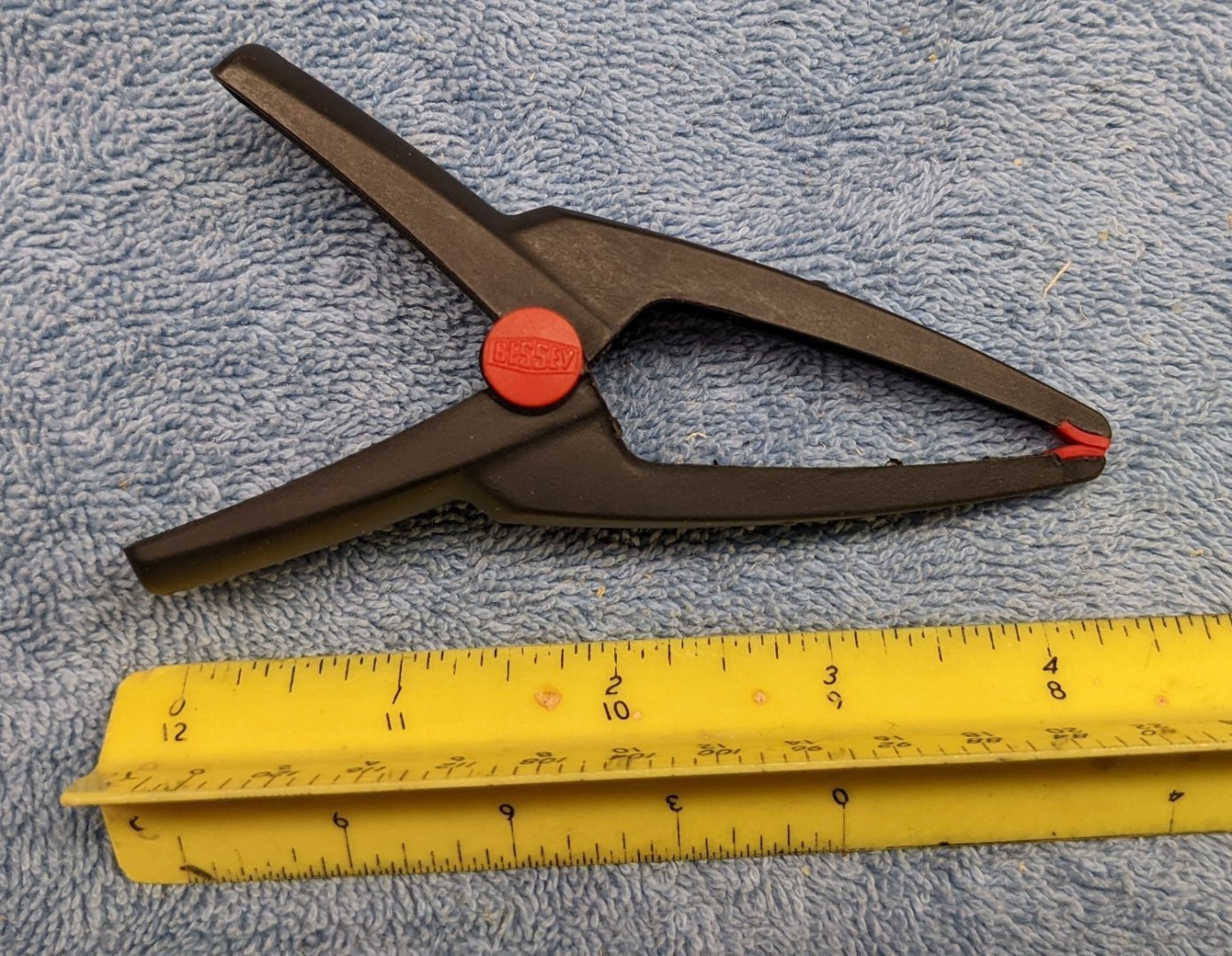
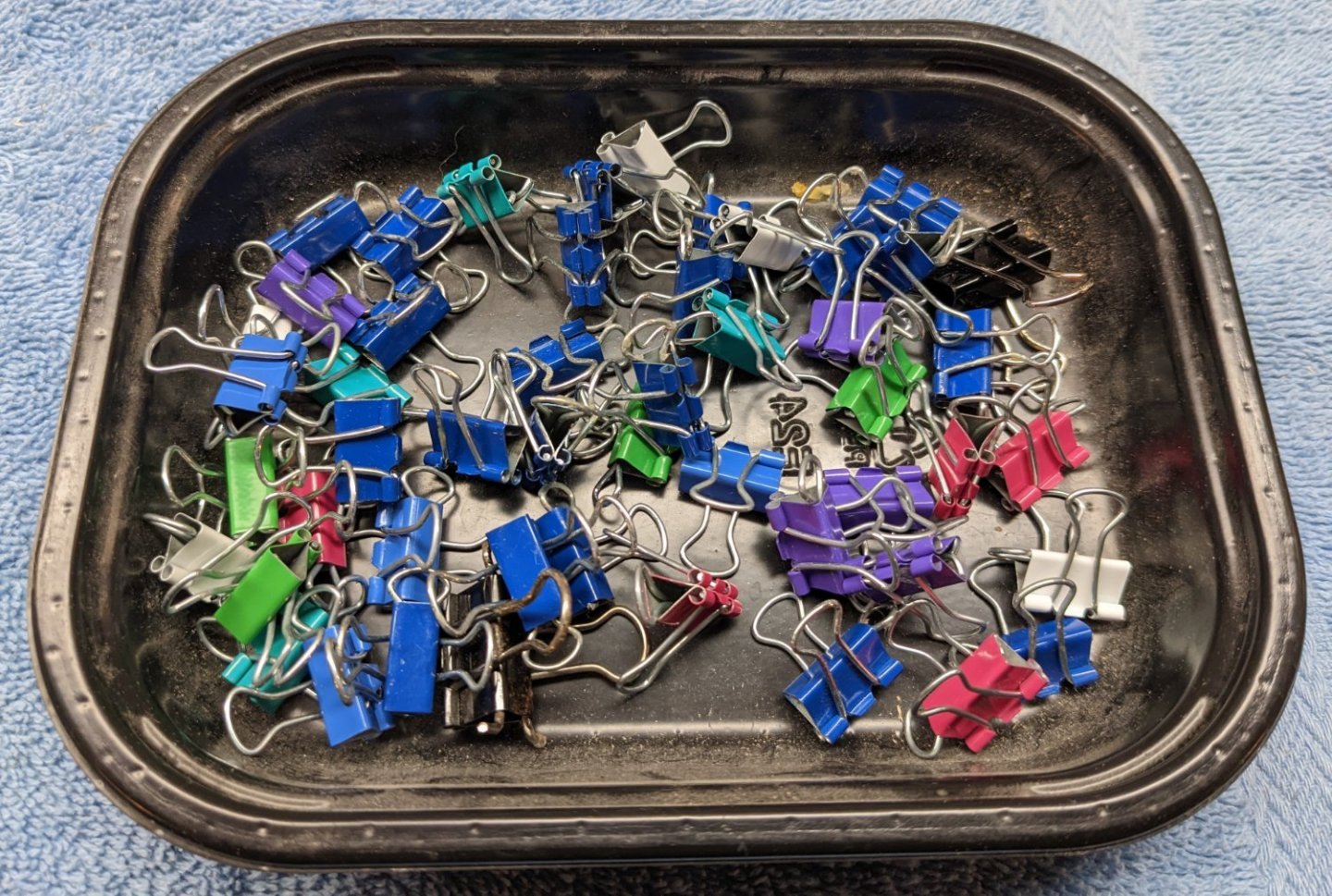
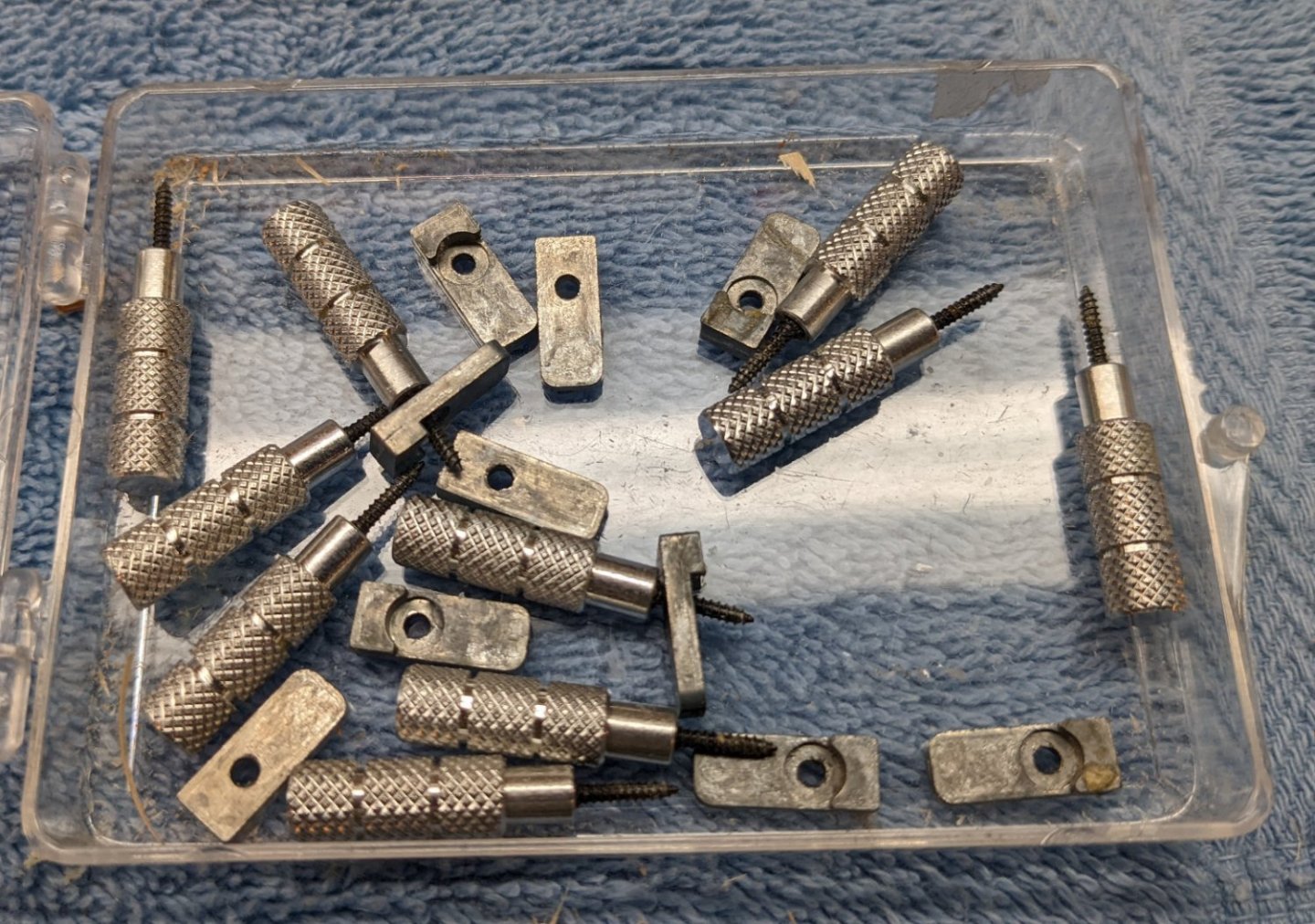
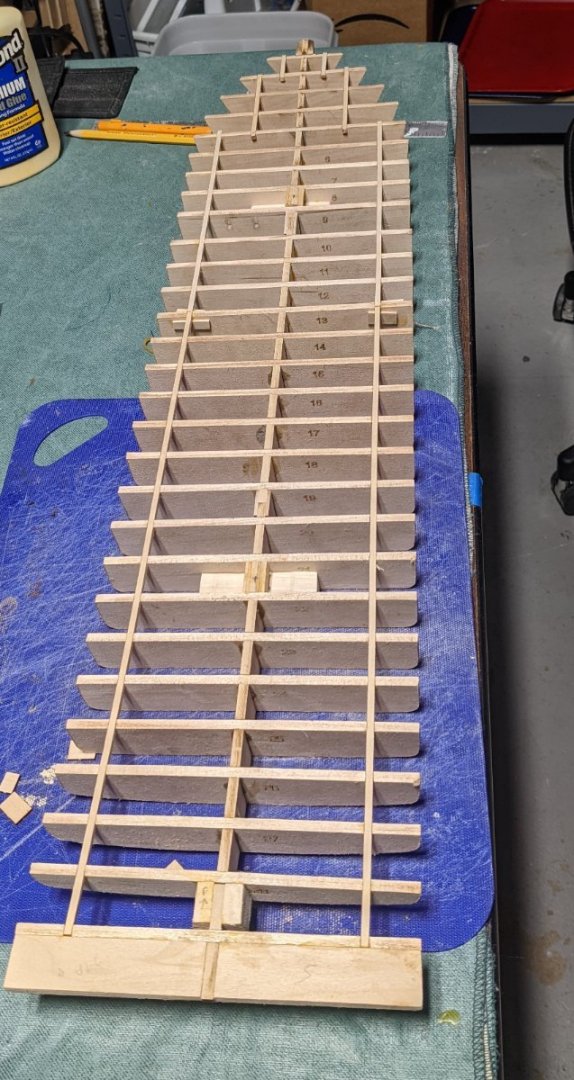
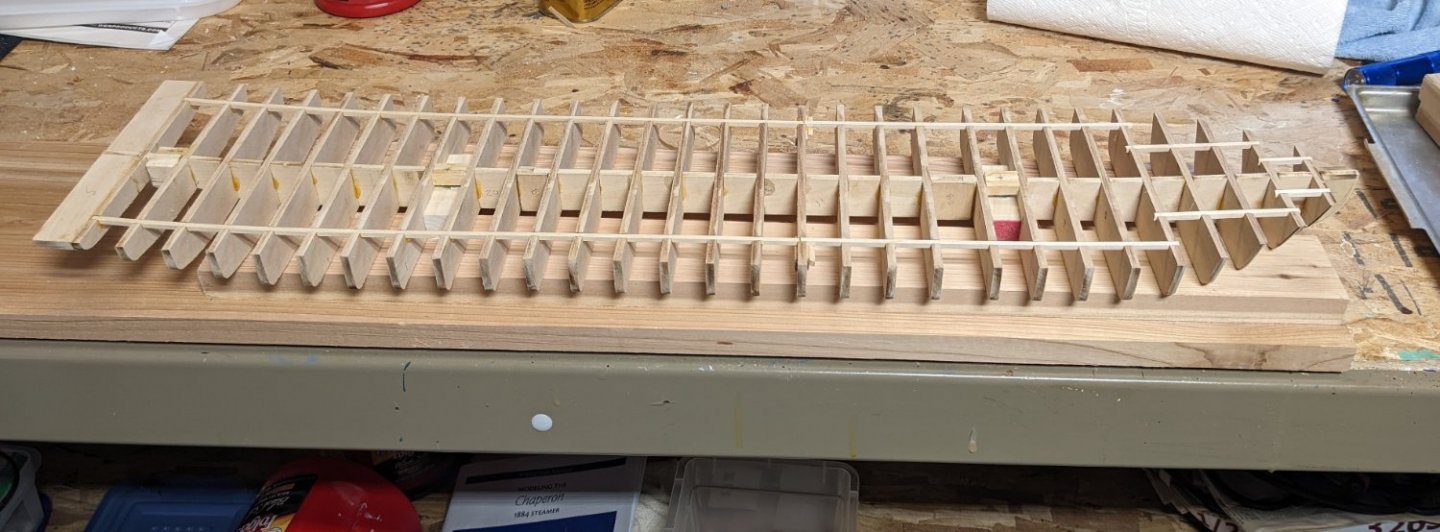
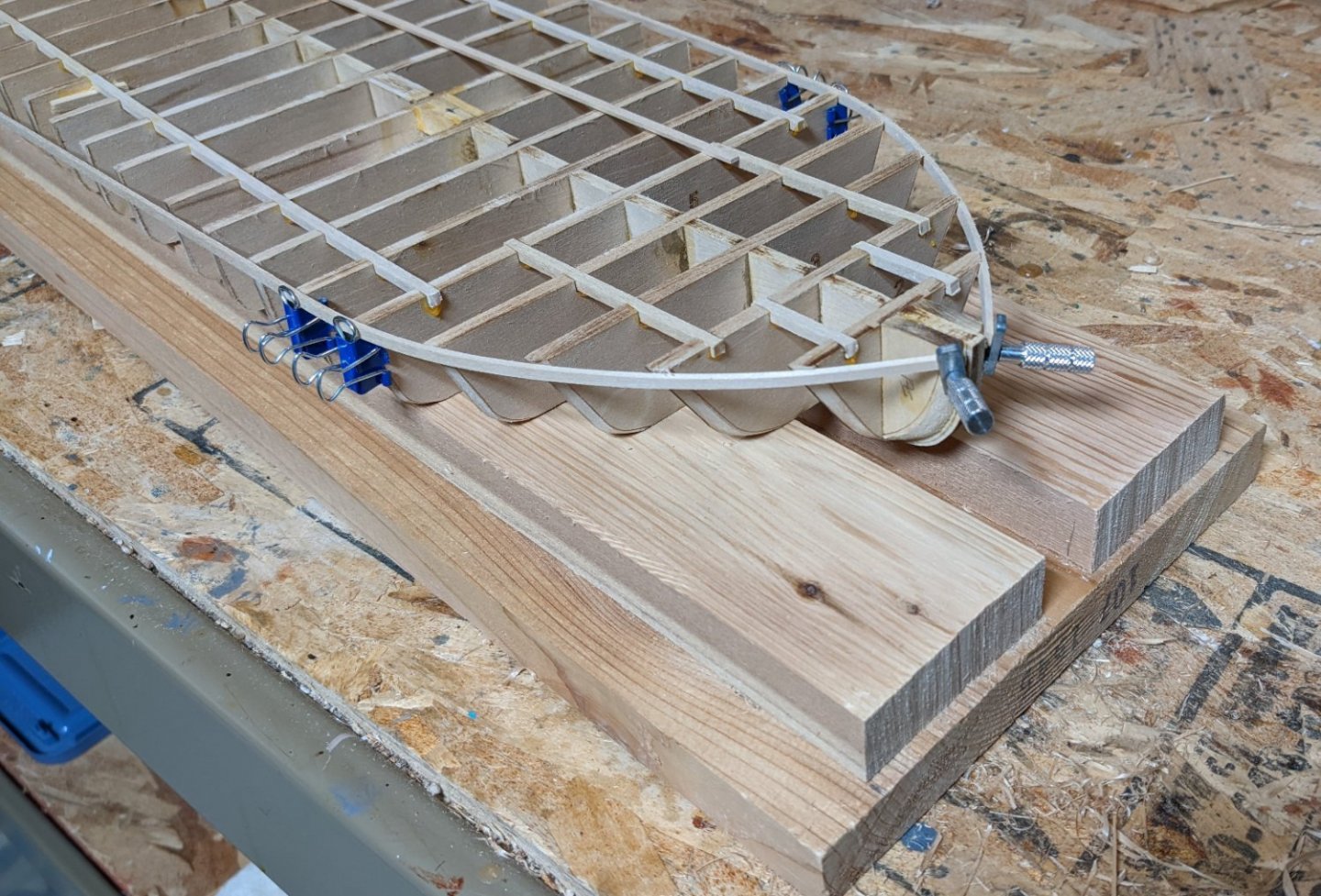
Oseberg Viking Ship by Jason Builder - FINISHED - Billing Boats - 1:25
in - Kit subjects built Up to and including 1500 AD
Posted
Jason,
The Oseberg has been on my with list for some time now. Someday I would like to take it on. It may be awhile though as my current project is the Chaperon (Steamship) and that will take me awhile. However I am anxious to view your build. Hope you have fun with it
john